#correspondencearchive
Explore tagged Tumblr posts
Text
3. Interview with Asianish
An interview with Sara Jimenez, Maia Cruz Palileo, Gabriel de Guzman and Cecile Chong, co-founders of Asianish. Part of our series of interviews with affinity spaces and groups.

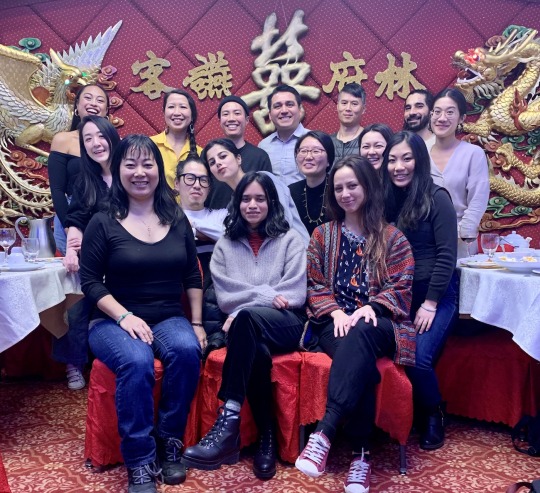
Correspondence Archive (CA): Can you please tell us a bit about your group?
Asianish: A few of us, including artists Sara Jimenez, Maia Cruz Palileo, Cecile Chong and curator Gabriel de Guzman, were interested in informally sharing and discussing the nuanced complex iterations of Asian/South/Southeast/East Asian/etc identifying individuals in NYC. We are interested in holding space for these “Asian-ish” hybridized identities that sometimes overlap and are also incredibly unique and specific to each individual.
The idea for these gatherings came out of our experience after participating in the NYC Creative Salon in March 2018, around the theme “identity.” That particular discussion was so rich that when it ended, we knew that we needed to do it again because there was a deep desire and an urgency to share intimate, non-white space together, what has come to be called Asian-ish.
We are grateful that this community exists. It seems at the root all of our discussions has been the need and desire to come together to identify the various ways in which we are affected by and wish to fight against the white supremacist structures of power. We hope that this community that we’ve built can continue to grow and recognize each other as resources for growth, strength and wisdom.
CA: From what I understand your group meets regularly for discussions and presentations. Do you do any other projects like pop-up exhibitions or public facing programming or have plans to do so in the future?
Asianish: Since March 2018 we met every few months in person and every time we had a different topic of discussion - identity, home, embodiment, community, food, nature. We also had a one day community celebration at the Dedalus Foundation with the Sunset Park community with performances, hands on activities and slide presentations. At the beginning of Covid we started to meet via Zoom, then our meetings became weekly when we felt the urgency to center our discussion around Asian solidarity with Black Lives Matter. In the future we may think about having public facing programming hopefully when we can meet in person.
CA: Why was it important to you to intentionally form your organization as an affinity group? What specifically did you feel was missing that needed to be addressed by your group?
Asianish: There were no spaces in the NYC art scene that had a contemporary lens for artists who identify as being in some kind of multiplicity in an Asian identity. We wanted to create a space that was not just for scattered pocket conversations but having it be a community. We felt that it was missing and that was what brought us together.
CA: What can an affinity group do that a mixed/blended group cannot? What is the unique work that your organization can do?
Asianish: Our conversations are centered around being POC. We felt the need to create a space for BIPOC to get together in the room and to be able to talk about things in a completely different way. The conversations are able to go in directions that typically in a mixed blended group the discussion can become limited. We recognize the inherent power structures that tend to exist in a room, whether it is intentional, conscious or subconscious. There are power structures and privileges that tend to take up space. Our discussions in a way function to upset this power imbalance. We want to let these conversations exist without the presence of these judgments or opinions which make it harder for BIPOC to express how we feel.
CA: What are the limitations of an affinity group? Is there something a mixed/blended group can do that an affinity group cannot?
Asianish: The fact is that mixed/blended groups tend to have more economic power and can raise more money. Because of this system of privilege that exists maybe an affinity group can tap into that privilege. As an affinity group we may not have that much access to privilege versus wealthier mixed/ blended members.
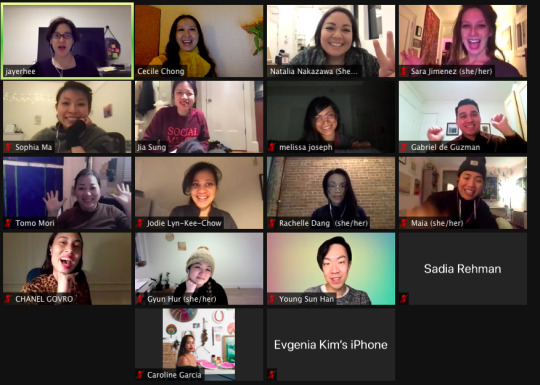
CA: What has surprised you about being involved in your group? What are some of the unforeseen impacts it has had on you personally and on the community/ies you are serving?
Asianish: There are many of us (96 participants and we keep growing.) We are surprised that so many are creating this space and how large our community actually is. On one hand we’re tied in together as Asianish, on another hand we’re very mixed and blended. The framework of the questions here could challenge that we do and we do not center around whiteness. Our discussions are about complicating that kind of binary, even though many of us are of partial white descent.
We’re also surprised that at one point we wondered who would be willing to meet and do all the work and planning? But there has been much to talk about and enough people to meet every week. It has been wonderful and surprising of the kind of support that is there.
CA: How do you view your and your group’s role in relationship to the larger, WSCP art world? For me, assimilation seems both impossible and problematic, while trying to force it to change is exhausting and depressing.
Asianish: Theaster Gates comes to mind who used the financial capital system and bought a building in Chicago to create opportunities for his community. It is about learning how to work with the existing structures in order to create change.
Recently we’ve had discussions of perhaps not moving towards utopia, but instead being in this inherent contradiction of a system and realizing that big money means blood money. We question how we can navigate within that conflict in an ethical, accountable way. Even if that means naming it and continually participating in a very mindful, collective and active way. Perhaps we can shift our perspectives and attitudes and think that there’s no utopic way or a simple answer. Instead we can see it as a daily struggle to grapple with and continue to have conversations to try to understand and unpack.
In our conversations we also find ourselves sharing with each other about after the trauma of our education system and many of us being in and part of the education system now, and how we’re still surrounded with white supremacy capitalism patriarchy. We’re having a place to come together to share those experiences. A big part of what we want is to create a visual culture that we want to see, one that makes more sense of our experience to our world.
CA: Shout outs! Who are the groups (contemporary or historical) that you look to for inspiration and that you are excited about?
Asianish: We admire organizations that support black artists like MOCADA and the Studio Museum, and also organizations that support Latinx and Caribbean artists. In the past there was Godzilla Collective but now besides A4 we don’t see organizations that support Asian or Asianish artists. We admire Asian American Writers’ Workshop, and we love Kundiman!
CA: How can people support Asianish? Does Asianish have any social media accounts that we can follow?
By being a guest speaker in our meetings. You can follow #asianishsolidarity on IG.

Asianish is a common space for people of Asian descent working in the field of visual art. We acknowledge the multi-racial, multi-ethnic identities shared and honor and respect our intersections. We are interested in holding space for these hybridized identities that sometimes overlap and are also incredibly unique and specific to each individual. By sharing our practices, we intend to deepen our connections individually and collectively so that we may strengthen and support our community within and beyond Asianish.
1 note
·
View note
Text
30. Mónica Palma & Kemar Keanu Wynter
Mónica Palma and Kemar Keanu Wynter discuss their recent work, how they are Invoking memories of food and home, the relationship of the body to their choice of materials and processes, trusting the wisdom of their bodies in making the work, how their thinking has evolved regarding making work for a white gaze, and how truth and honesty play roles in their work.

This conversation happened in person in the Winter of 2023, the text was edited for the purpose of the Correspondence Archive Project.
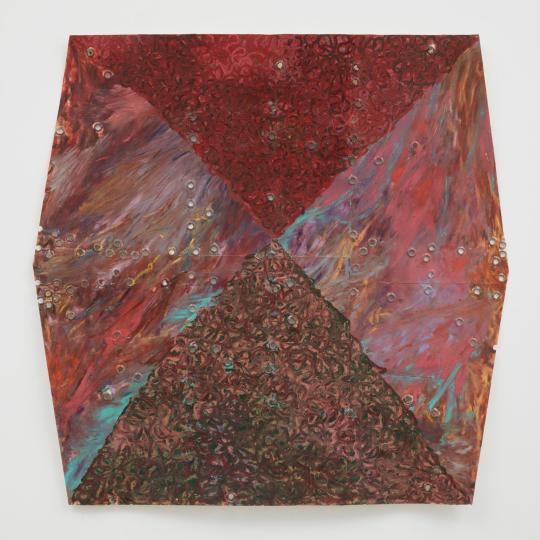
Kemar Keanu Wynter, (II.) Rederrin, 2022, Oil pastel, acrylic, graphite and grommets on collaged French cardstock, 35.375 x 36.25 inches
Mónica Palma (MP): Let's see. Hello. Okay, so we are in Crown Heights, Brooklyn. Tell us who you are?
Kemar Keanu Wynter (KKW): My name is Kemar Keanu Wynter and I’m happy to be talking to Mónica today.
MP: So here I am. I'm Mónica Palma. And I'm so happy that you're here! I knew you were coming and I'm aware that I live in the neighborhood where you grew up - Crown Heights. That's your place. Before opening this recording app, we were talking about place, location, and neighborhoods. We talked about neighborhoods changing and transforming. We were talking about mulberry trees in this neighborhood whose fruits are edible. And I know that in your work one of the biggest anchors is food, your neighborhood, and your family. I wanted to ask you, because I know that you were in a residency recently. What happens when you are far away from your location or the place that you consider your location at heart? How do you access those familiar forces? How do you remember actions? Do you think that those forces are embedded in you when the place changes and you find yourself in a different location? And if so, how do you access those sources, those powers?
KKW: Whether I'm home or traveling, be it a residency or just out of the city for any other reason, if I'm working on paintings based around the dishes that I grew up eating, generally the way that I try to pull back to that–I mean the process generally doesn't really change depending on where I am–is through the recalling of memories. You know, my experiences with these dishes within mine or my auntie’s apartments, which are just second, third homes. The best way to do that is through writing. Text has become a big part of my practice and it's something that I think I've refined and become more attuned to in the last year especially. I will start thinking about my experiences of the dish, the flavors, the heat, the conversations and ambiance around it– I feel like every single dish has a story attached, some have multiple stories that can be attributed to very specific, singular moments in my life. I just write about those moments, and that helps me figure out where my focus needs to be when it gets to the painting side of things.
From the jump I knew that I couldn't just be a freely working abstract painter, I always needed something to ground the work, right? Having that text, something that really serves to bring those memories from years back to the forefront of my mind… it’s crucial for me to hone in on those memories and use it as the nucleus for my practice and then reach out from there. There's definitely a point in my process where the painting becomes as much about the dish as it is about making a formally good painting. And so there��s this moment where the narrative I’m bringing to the dish evolves into this dialogue with the surface about what it takes to make this work a good painting, but I wouldn't be able to get to a finished painting at all without having those initial references at the foundation.
MP: You mentioned the words nostalgia and memories. When you travel into the past to access specific forces, they will help you carry the work, but you also have to anchor yourself in the present. Then when you were talking about the formal qualities, the interest in making a good work, and your personal ethics. For me, it's like you're mixing those two tempos, right: the past and the present, like perhaps the time traveling sometimes takes you to sad or happy places, but then you bring the work to the present, and you give it roots and feet and work that comes back here and has its own flesh and its own identity.
I was wondering if the topics of food and family become beliefs? When I think about my work and how I don't have a religion and I don't live in my country, and as a result, there are certain things, certain materials, certain memories, that I invoke in the work. This is part of, if you wish, a narrative, but then there's the other part of the labor, which is organizing the materials, thinking about composition, etcetera. I think, in that sense, there are some similarities in our work in accessing the past, accessing ancestors, and accessing memories, and then manifesting the work and giving it flesh, I think both of our works have bodily qualities.
KKW: Yeah, definitely. I think that these aspects around physicality have become more prevalent in this most recent series of works because I’m really studying and thinking about heraldry in relation to my work. There’s this quote–
MP: What does “heraldry” mean?
KKW: So heraldry as in coats of arms and such.
MP: Right!
KKW: There's pretty much like this language and system of metals, colors and materials; different visual motifs that denote a family’s identity or an individual’s relationship to their family. There are select offices where people study the previous millennia’s heraldic markings and work to ensure that tradition persists into the future. One of these titles in Scotland is known as the Lord Lyon King of Arms and he and his staff have records of every coat of arms ever appointed and oversee the creation of new arms because though arms could be inherited, between marriages and descendants, the markings of a family could go through any number of alterations–there are evolutions to it. One of these Lord Lyons said that heraldry is “the handmaiden of history” and I’ve been fixated on it since.
Even before knowing of the quote, I had always seen these dishes as my family heritage, there’s so much power and presence in the dishes. My family started immigrating here in ‘93 and brought every dish that I, having been born in ‘95, grew up on. Each of those dishes is incredibly formative in molding this concept of who Kemar is. Those dishes are markers and coats of arms for my family, serving as a way to evoke an aspect of our relationship to one another. So I’ve been leaning into that system recently, in the shape of the surfaces and the sort of–
MP: Some kind of new symmetries are happening.
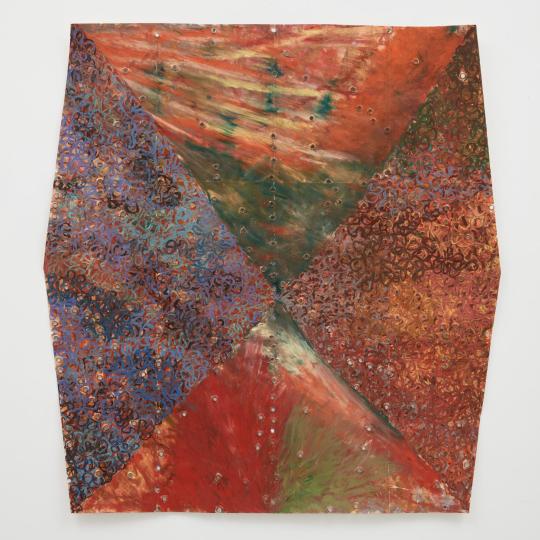
Kemar Keanu Wynter, (VI.) Tomorrow’s Dumplings, 2022, Oil pastel, acrylic, graphite and grommets on collaged French cardstock, 52.25 x 48.625 inches
KKW: Yeah, so the new works are all hexagonal because I'm thinking about shields, and I'm also thinking about Tupperware for holding food. You know, the painting is a container, so why don't I literally create the surfaces such that they evoke their relationship to the container, right? So for me, the hexagon made natural sense in that regard and with regards to that sort of triangulation that you're referring to, there are ways of partitioning shields, breaking their fields to identify your allegiances. The partition I'm using throughout these paintings is the saltire partition, which is utilized by the flags of only a handful of sovereign nations. The one’s I know off the top of my head are the United Kingdom, and more specifically Scotland, Grenada, Burundi and Jamaica so it felt like it made so much sense to take that form and keep it as my reference to Jamaica. Especially when you consider that this assumption of heraldry also runs headlong into a tradition intermingled with many fraught centuries of British hegemony.
It's been interesting for me to have to work with the complication of the per saltire partition across like a hexagonal form right. So now this hexagon is broken into these four fields, two rhombuses, two triangles and now I have to figure out how to deal with the composition.
MP: You in fact have partitions, where before you used to have fields, right? your surface used to be a field where you went swimming and now you have these partitions, these are boundaries. I imagine that you want unity at the end of the day but the idea of boundaries is also everywhere. Did you impose them on yourself, or did you think they were necessary? These demarcations also seem like they want something from you too.
KKW: Absolutely, they definitely give me something to sort of wrestle with and instead of there being one field, like you were saying, now there's four and how do I reconcile all of the sort of happenings within each of these fields? How can I make each of the fields function strongly, independently and then also operate together as one unit, one heraldic structure that also embodies the dish that catalyzed its making.
MP: Are you facing challenges related to entering a more mental space with the addition of these physical boundaries? I notice variations in the time-marking marks interacting with the divisions. Are these changes worrisome or exciting?
KKW: It doesn't entirely. I'm always open to making new changes in the work but the thing is, if I'm going to make a change in the work, it's something that I've probably been deliberating over for months before I actually make that first move. But once I do, I'm fully committed to it and to seeing it through to some point of resolution. So making the hexagons felt very natural, I'm really just taking a square and just tapering it at some of the edges, that was easy enough.
MP: I like the triangle because it's a very stable shape. Very solid, and present.
KKW: Exactly. There’s definitely a certain oomph to it for sure. There's that aspect of it of like having that sort of shapeliness, but the thing that I wrestled with the most there's now this sort of question of how I'm handling the surface because in prior work, I was sort of doing this sort of all over gestural mark that involved a lot of smearing and created a fairly uniform surface. Now, I’m also building more densely layered areas over that. I've done each of those approaches independently in work, but I'd never brought them together until this point. So it was a thing of just like, really wrestling with surface quality, and like really wrestling with how the sort of finished work should look.
And I think having those partitions to like really designate spaces for those sort of those textural qualities to exist, sort of in their own spaces, but also as part of the whole was the thing that made the most sense. I've always been like a very regimented, very list-oriented, a person who really benefits from having things very clearly delineated, so having those boundaries felt really natural and felt very generative in terms of just like really just figuring out the peculiarities of these new works.
MP: Coherence also with your way of thinking, organizing your brain, and also finding a form or shapes that make a mental click.
KKW: There's this moment where everything sort of just seemingly fits together. I'll build up the surface and have a first draft of the work, but as I'm looking at each section relative to the ones around them, I have to go back and respond according to what's going on in the other fields. So it becomes this call and response and I have these four parties demanding different things from their neighbors.
MP: There’s some kindredness; taking a bit of the DNA from this one, the DNA from that one. I saw a picture from the residency upstate where the paintings were all on a wall, and I could feel my eyes jumping from piece to piece, and my brain acknowledging the familiarity and sensing that the pieces required some democratic attention.
KKW: There's definitely moments where there's parts of the painting where I'm like, I love this section of the painting, but the whole painting falls apart because of it, right? And so I have to sacrifice that section and it becomes something else, for the sake of the cohesion of the whole. There's some times where sections pop, but it works because some of the other areas are a bit more muted or uniform. So there are those moments of calm within the composition that allow for like other places to speak more loudly.
The paintings now really feel like cooking, these are the most cooking-esque paintings that I've made. It's just like working on a stew for hours and like realizing okay, I need to add more of this seasoning here, and as things reduce down and tenderize and break down the flavors change again I realize, okay, I need to actually introduce a whole ‘nother element to round things back out.
MP: Is there one particular dish that requires all your attention, or you are talking about having different fires, controlling the temperature on all of them and making sure that nothing is burning?
KKW: You’ve got to maintain the tempo. I use stews as a general reference point to talk about the paintings, but I'm handling multiple burners at once, moving back and forth between the surfaces. If I hit a soft wall, I’ll move over to another one on the other side of the studio, and work on that one for a little while, just getting a little visual rest from the painting to return with fresh eyes and a new perspective. Or I'll make a mark on the surface that I'm currently working on right and graft it over to the one that I'm struggling with and it fully recalibrates the composition. It's become a really good sort of give and take, figuring out how not to overdo it�� getting the tastes right, getting everything to harmonize in the right way, not necessarily having them all operating at the same level but having everything make sense by the end of it. Like having really sour notes but then having some sweet, some bitter and a hint of char to make it make sense. So it's not just a dichotomy at play in terms of balance, it’s numerous sensations operating in tandem.
MP:
I think that that's something I need to do more in the studio, I get lost in one single piece. I get completely devoted to one single surface, but I have this innate trust that there's going to be a common language across all of them. But there are moments where I'm like, wait a second!, and I crave a little bit of what you're having right now; this contained energy with these groups of work, that they help each other and feel like more of a community of objects. In my studio right here, I sometimes desire that kind of consistency.
KKW: I see the works that are around us right now and feel like there is definitely a familiarity amongst them, like they all know one another. There are nuances to the way that the surfaces are applied of course, but within that there are common through-lines between all of them. It’s most notable in the way the works reach away from the wall, out into space and towards the viewer. Even with the bindings, the yarns that weave around and serve to dictate the forms. A real kinship exists, they all branch from a central bloodline.
MP: I hope so, I think as an artist, that's what you hope that you make your choices, that this knowledge and interest is so deep, that it is going to be integrated into your system, that your psyche and your body are taking care of that process. And you can just do the work because you absolutely believe in it. Then it becomes about the materials you choose to do the right thing on the surface. We both work with surfaces, right, I think we both want some acknowledgment of that surface, we like touch. How did you arrive at that?
KKW: I've also been sort of wrestling with that question of like, what is true or what is honest? Because I really want to make honest paintings and I think that in the last year, what I really have come to realize is, I find honesty in that point of my practice where I let go and remember that I've been doing this work and that I know what I want in a painting already and what’s been accumulated.
MP: I agree with the wisdom of the body.
KKW: We've accumulated knowledge that’s gotten coded into our muscles, what marks feel good to the hands, wrists, the body and how to make them. That also extends to our materials, we know what makes sense and resonates. We’ve developed this knowledge over years of investigating within the work and to a degree there are moments when we don’t need to think about what we’re making and just let the body do. There are times where I find the most interesting passages in my work happen in those moments when I’ve receded into the background, into the music playing in my earbuds, and just feel it out. That might be five minutes or two hours but when I come back, I find that I’m in a location beyond the hump or complication that I was brushing up against and that intuition was able to serve as the guide in the moment. It’s true because it didn’t have to be forced.
MP: Right.
KKW: Not that powering through and pushing through a painting doesn't have its benefits in certain moments, but letting go of the preconceived painting in my head and letting all of the body wisdom that has accumulated– that understanding of color, that understanding of mark do what it needs to do and take control of that moment and get you through that ravine of uncertainty to that other side. If that makes sense?
MP: That makes sense. I feel that also-correct me if I'm wrong, but I feel something kind of similar; you make this work, then there is a point where you need to jump! Mostly with each piece, you have to jump and know that you're not going to break your head. It’s the trust that you're going to do the job every single time, and you're going to come out alive after that jump. I think it's a matter of material congruence, with personal histories, personal narratives, and with context, but also trusting the walk to the edge. I don't know how you feel about that. People work in different ways. I like walking on the edge with performance in particular, but also with the object-based works here, and I like to believe that I'm going to come out alive after that experience. It feels like you are surrendering yourself to life in each piece - I don't know, maybe I'm exaggerating! But I feel this gravity every single time I perform. Since the performances are absolutely related to the work, then it helps me know that I'm taking the right risks and that if I'm afraid it’s OK - that's my main barometer. You have to have a little bit of fear. Sometimes I've had a lot, and it's unsustainable, for me, Mónica, sensing that fear can be a very good indicator that I'm alive, and I'm taking risks.
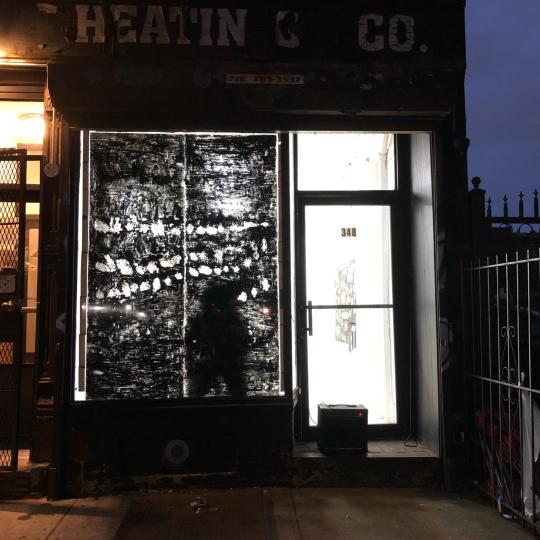
Mónica Palma, Before I Started Working With My Mouth (performance), Plexiglass panels, activated charcoal, honey, aloe, saliba, microphone and amplifier, 2020
KKW: Do you ever think that the embrace of fear and push on your boundaries that happens within performance expands the sort of boundaries that you have within the walls of the studio when you're working? Or do you think about performance and your painting practices sort of independent of one another?
MP: I find them completely related, but perhaps that's up to the viewer. My desire is that they are seen as related, if not even different manifestations of a single idea. In performance I expose my body and my body becomes a surface. I'm starting to see more and more that the pieces here in the studios are bodies that I act upon, and though not precisely my body (because it’s external), they feel like a proxy for my body. So for example; those marks on that piece are bites that are framing the metal. The last performance that I did in Tennessee I was using twine braids to tie up and restrain my body. In some of these pieces I'm also using braids to transform, mold, and mark the surface. And many of the pieces were done in a very performative way, more like private performances. Someone asked me if I ever film them or take pictures while I'm doing that, but because I'm so busy with my body, hands and mouth I never did.
KKW: I feel like there's this interesting relationship to like, to intimacy that exists within your work that I’m fascinated by. With the bindings I'm thinking about rope bondage and how aspects of power and control exist within that work, but simultaneously functions as an artistic practice where you're also using the rope to accentuate and sort of exaggerate the dimensions of the body. For me, it's interesting to think about these surfaces as surrogates for the action. These surfaces are your participants in these assumptions and relinquishments of control. As artists we're always sort of engaged in that because like we were saying earlier, there's that point where the work also tells you what it needs.
MP: I'm thinking about your small drawing pieces where you see your fingers smearing the oil pastel. I had this thought that you were tapping into S&M dynamics, although I'm not an expert in it, I'm interested in the idea of domination and pain, the kind that makes you feel present. I have a medical history, where too many things were done to my body, in a moment, at an age, where I could do nothing (I was 12), I had to be there for doctors to do things to me, to cut, to put things in me, and to extract things. The older I get and the more experience I have, these themes continue to emerge: themes of acknowledgment of a body and making it present.
I started using the braids thinking about my Mixtec grandmother's hair, and then braiding and wanting to bring that very simple action of transforming hair into my pieces, then eventually I wanted that braiding to be a force too. Those kinds of actions and materials are perhaps similar to the way that food is for you. They feel right. Like if someone doesn't get it, it's OK. I believe in the actions. It feels purifying. It feels liberating.
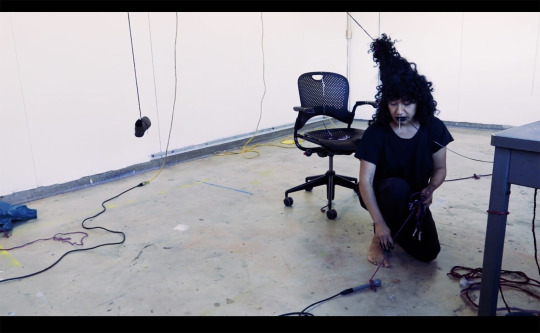
Mónica Palma, Cae mi voz (Mi voice is falling) performance, Chair, mug, hand dye braid twine with cochinilla, amplifier, microphone, vinyl text on windows, and serigraphy paper posters with poem by Xavier Villaurrutia, 2022
KKW: It is also interesting with braiding because you know, be it hair or any other fiber, that act of braiding strengthens the material. Even in this moment of vulnerability there is also this reinforcement that is happening. I think about that in relation to your works with these metallic edging, the central fields are paper but then they have this structure that once again, sets the boundaries, but those edges have this sort of strength to them, this rigidity that transcends the paper. It becomes like armor. Let me know if that doesn’t sound right.
MP: I think it's definitely the case with the metal that I've been using. They have the strength of bones. Those pieces you mention were done using the doors of subway cars. I took them on rides and I crushed them between the doors, and I enjoyed the moment where the middle of the doors and the rubber touch each other: metal meeting metal, that union, and the force, an external force that is the doors of the cars, marking the drawing. It was quite performative, even though I was not fully the one doing it but the machine. I'm not fully participating but I'm orchestrating the crushing.
KKW: You're a sort of conductor, you're setting a score. I would never say that I’m the most well versed in happenings but I think about how the Fluxus folks often had set instructions and parameters in place for the execution of their performances. I think about the medical situation in your past where you weren’t able to have that power in contrast to your role as the conductor in the subway and how there is a power in that relinquishment. Where you’re able to establish these parameters that are slightly out of your control and can exist outside of your intervention.
MP: I like what you're saying - I think it's about asserting the presence of the body. I'm talking a lot about my body, it is also about making visible the bodies of others that are not being considered, and asserting a presence by bringing materials to the front, by bringing the wound into view.
KKW: Making those who are pushed to the margins, those who are often invisibilized more visible in a way?
MP: The work gets political. Absolutely. Sometimes it is more explicit in the performance, the work here in the studio feels more abstract. Through the use of loaded materials like volcanic rock - of the same kind that the Aztecs built their pyramids which the conquistadors destroyed and used the same rocks to build their churches– materials like this bring the political component more to the fore.
KKW: How do you feel about that? It's something I always think about. That idea of legibility as someone working within abstraction. Prior to this, you know I was working with coded text, creating these conditions to obfuscate and slow the read of the writing I was sharing. And it's been interesting because as I’ve been making these works, I've realized that the coding is no longer important to the work and frankly, it was funny to look back because I realized my efforts to obfuscate the work, still ended up centering the white gaze in some ways. And so it's been interesting just making the work now, just now I'm just sharing the writing.
MP: More straightforward.
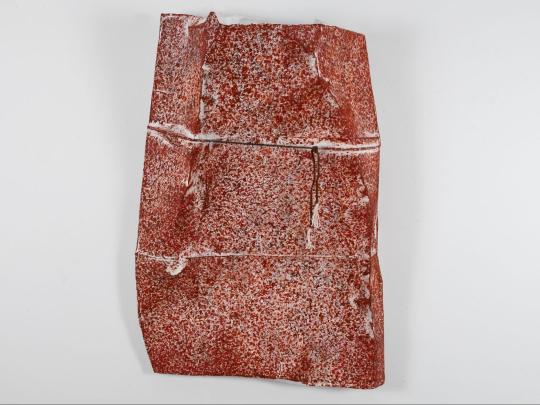
Mónica Palma, Ribes and Bites, Aluminum sheet, calligraphic rice paper, glue, encaustic and braided rope, 38 x 27 x 13 inches
KKW: Yeah just straightforward, leaving it for people to read. I find so much, there's a sort of freedom that comes with that I think, that I didn't notice, or that I didn't realize was absent. That like there was a sort of pigeonholing that I was setting for myself in this effort to speak on the hyperconsumption of Black cultural production.
MP: What you are saying right now is very important: the realization of who are you serving, right? Who are you? Who's the viewer? What do you make work for? With what energy do you make the work? It's interesting because I think both of us have very personal stories to tell about our work, yet we are abstract artists. And for me, I don't know if you feel like this, but it excites me, and I definitely want to go back to what you were saying, because I think it maybe gets to the core of this conversation. I find so much of your practice in the world of sensuality and materials. And I feel that that is revolutionary in a way to claim– to claim the flesh, to claim the dirt, to claim the body, to claim the surface, to embrace the smells. I want to be in that world. And I have other things to say, they're incredibly important to me, like credos. I absolutely need them, but I want the work to have this form manifested in the world in this way that is abstract. Because it's the most sensuous form that I know. And it's not prescriptive.
So back to what you were saying, it sounds very important, that moment where you became more assertive and decided to remove the text.
KKW: Yeah, I definitely feel like taking out, shifting that element of the work has definitely been a way for the work to be more honest. To push the work further toward this idea of truth or honesty. At the end of the day, I’m making the work first and foremost for Black folks, immigrants, folks of color. Reaching out to those who have their own stories and identity woven around these or their own culturally essential dishes… and I find greater pleasure in the work now.
MP: It's so interesting, because it's not indulgent, it's pleasure. And there's a difference between indulgence and pleasure.
KKW: I feel like the joy is purer, now that I'm not thinking about this additional realm of labor that I’d been imposing on myself, to then place within the context of the exhibition or simply engaging with the work.
MP: It’s very hopeful: the path to ownership, to have ownership of your own story, and your own pleasure too. Is there something you would like to ask me or to ask yourself?
KKW: I feel like discussing more in regards to truth and honesty. I feel like we’ve spent a lot of time talking about my thoughts and I’d like to hear more about you.
MP: I will talk more about congruence than honesty. I like the idea of congruence because I feel that it speaks of a convergence of different places falling into the right place, into the right spot. For me it’s related to a search for materials; I put a lot of eggs in that basket. I tried to extract these ingredients and information and make them meet. I want to see if these particles, these elements, when they come together, if there's some kind of amalgamation, but where they can also keep their individual identities shining. Also, I can act upon them and they can allow me to participate, they can allow me to enter. It's an invitation for different elements to come all together. But I don't know if I'm doing any justice to the question of honesty, which feels huge.
I was listening to some writers talking about honesty—fiction writers—they were saying how honesty has nothing to do with the labor of writing fiction—that kind of truth is somehow irrelevant, because you're talking about building different worlds—constructing, characters… Of course you have to have integrity, you have to have some order. But framing the work in terms of truth and honesty was mostly irrelevant. It's not that I see my work as fiction, but I can say that I love written fiction, and it’s almost the only thing I read. I wonder if there might be some similarity between fiction and abstraction, in the sense that what I'm presenting here is not volcanic rock. What I'm presenting here is not me. I'm making these amalgamas—I don't know the word in English—amalgamations! They're creating a third something. So the elements might get a little corrupted on the way, because they traveled from Mexico to here, or even in the thinking because they get transformed by so many factors, including the infidelity of memory. I don't know exactly if what I'm making is really a matter of truth, so much as belief. I feel like there's an element of fantasy to it. But I think that in any fantasy there's some kernel of truth. It’s tricky to make sense of. What do you think—can you help me with this?
KKW: How you think about it is also how I think about it as well. I think that when it comes to honesty there is a lot of room for slippage and for things to not necessarily be exactly how they occurred in history. Because I think about a lot of these pieces that I've written, looking back and reading some of the things, I know this isn’t exactly how it happened, but this is how I remember it. That's the thing, memory especially is such a subjective, such an easily tarnished thing. I've decided that there's no point in fighting it. Whatever your brain is able to evoke that's the honesty and in some ways, I think that as artists we are maybe in some ways unreliable narrators but at the same time, because it's our story to tell we're the most reliable narrator you’ll ever get.
MP: I like what you're saying. I think it's almost like you believe in the grey area. I think we're believers in the grey area.
KKW: Yeah, we're always floating through the fog a little bit.
MP: And if I asked you about your auntie in particular; the order of her cooking ingredients, you are the holder of that information, there's veracity in that. But I think allowing yourself as an artist to explore and take those grey areas, that spacing between buildings, you know, that little gap, the alley or where the dust is being accumulated. So that's sometimes where the juices are there's an area that hasn't been completely defined.
KKW: There are times where I've written about dishes and most of the text isn't about the dish itself. I wrote something recently about a meal I had in Europe and the majority of the vignette is about the day that I had after the meal. It was just like talking about the weather on this particular afternoon and how the air felt on my skin, strolling along a canal for hours doing nothing in particular and in my mind, that's as much about the dish as like the actual talking about it directly. We have this luxury of being able to frame the image exactly how we want to present it.
MP: So if there's some sort of veracity that veracity for me is in being in front of the object—in the composition, in temperature, the visual temperature, in the touch—that's the veracity. The rest of it goes somewhere else, beyond. Maybe it has to do with dreams, maybe with memories, and we know that the concept of memories is complicated, like false memories, for example; the more you think about something, the more you transform it in your brain. But as visual artists we need to go back, back to having a bite of that food right? We travel back to that tangible moment or memory.
I wanted to ask you about—this is a bit of a jump to something different—but I know that maya, your partner, was with you at their residency. How was that? Are they involved in your process or a particular kind of viewer? What's their participation in the work? How do they see it? Do they give you feedback?
KKW: It’s interesting because I would say, it's usually one or two things when it comes to relating to the work. It's usually either they'll come into the studio unannounced and see one or two things that really draws their attention and that's usually a good sign I'm in a good place because they're one of the best color theorists I know.
MP: Wow. And they’re a writer.
KKW: Yes, they're also an excellent writer, so I trust them heavily. I trust them fully when they say something is exciting, I usually try and coax as much information out of them as possible about why they find certain aspects intriguing. I’ll usually take a line or two of notes and keep that percolating in the background as something I should be mindful of while working.
Alternately, there are times where I instead ask for feedback. I’m very much a studio hermit and don’t like having people interfering with my work especially when I’m actively in the midst of a session. I need to be in my mind with minimal distractions while working, when I reach around 85–90 percent done with my work, that’s when I might actually call maya in for some feedback and a temperature check on things happening on the walls.
MP: Going back a little bit, tapping on the theme of truth and veracity; Isn't it a beautiful thing that, when you love someone and you respect someone in your life, that person can see you and you believe them? I mean, when Calvin, my husband, says something about my work, I actively listen, though of course occasionally I disagree. The amount of trust that you can build with a partner who's in the arts or even if they are not but they are sensitive and receptive. It's really beautiful.
KKW: It’s definitely surreal, the sort of sensitivities that you have with the people that you care for and their work pulls a different type of critical energy that I think is– it's not necessarily meant to be people pleasing. This is where I stand in relation to your work. With an awareness of your tastes, but also an awareness of their own tastes, seeing those connections firing behind someone's eyes while looking at your work is a beautiful thing to watch.
MP: Sometimes it's the awareness of how they perceive you. Sometimes they see that you've been losing your mind in a project. They sense your energy, your mental health, "That thing is destroying you. Chill!"
KKW: Exactly. Oh my god, very relatable. It’s vital to have that outside look.
MP: Those kinds of viewers are so valuable. I don't know how many you have… well it's not about the numbers. It's just so important to have at least one person like that, who is going to give it to you straight.
KKW: Absolutely. Funny enough, I actually trust my family a lot. None of my families are necessarily like formal artists, but I trust them when it comes to their thoughts regarding my work because the thing is, all of these dishes are based on familial gathering and dishes that we've all eaten, often together. If I tell them the title of a dish, they immediately start laying out all of their own relationships to the meal and ideas about the painting. Frankly, they're my first audience, right? Back when I was in school, I always said that I wanted to make paintings that my mother would like, so you know.
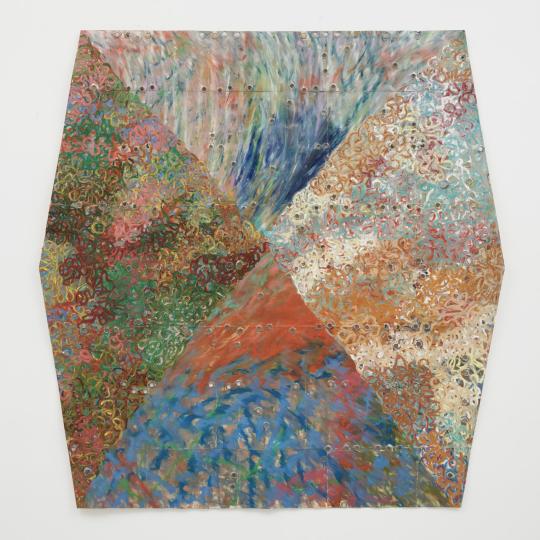
Kemar Keanu Wynter, (V.) Earl Grey and Water Crackers, 2022, Oil pastel, acrylic, graphite and grommets on collaged French cardstock, 48.625 x 47.25 inches
MP: These folks have a sensitivity that is very similar to yours. I mean, they might not have a studio, but they smelled the same ingredients as you did. They are anchored in a sensuous world where, adding the salt, they know that in order to make a dish some steps have to be followed. It's almost like synesthesia, you know, that they can taste and get where you're going after.
KKW: Exactly, there's an equidistance between us and these reference points. It’s easier to make connections from work to dish and of course we share a lot of these memories.
MP: It's all under one umbrella.
KKW: Exactly. It’s all woven together. Also, I think there is a bias that also comes from me not having a formal, dedicated studio in New York. I’ve sublet one here or there for a month at a time but that's it, so I don’t really have a lot of visitors. There’s a few family members who are usually actively up to speed about what I’m working on, maya, a handful of other individuals and yourself, with us having so much kinship between our practices. I know you’d get what I’m working out.
MP: I have been in your studio. Yeah, remember when you were at the Ortega (Ortega and Gasset Projects), I saw those paper pieces.
KKW: The collage pieces.
MP: Were very interesting. Fascinating.
KKW: Those works have definitely led me down the path that I’m on now.
MP: I still see traces of that work they were also coming from tracing I guess, food containers?
KKW: I was pulling from the forms of actual food, drawing them over and over and abstracting them. That was January of 2018, so five years ago.
MP: You first came to my studio sometime later. And then you also saw me perform on the street.
KKW: Yeah! We’ve been in long range communications.
MP: Right. I agree with that. Yes. Are you still mostly using oil pastels?
KKW: Yeah, mostly oil pastel. I remember that you said the marks you’re making are produced from a sponge right?
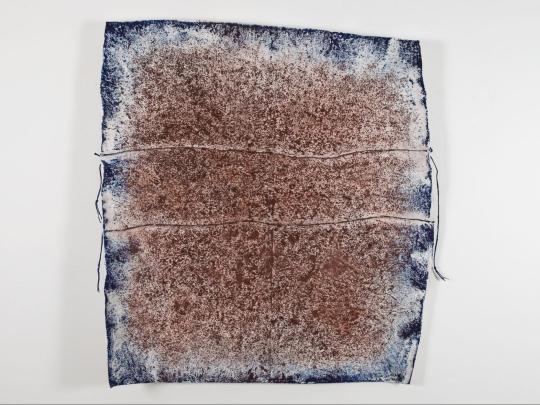
Mónica Palma, Big volcán, Aluminum sheet, calligraphic rice paper, glue and encaustic medium, pulverized volcanic rock (tezontle) and braided twine, 2022
MP: Yes, though I also use brushes. These surfaces are now sheets of metal (aluminum), which I coat with layers of rice paper, dipped in archival glue. They make some kind of armor or exoskeleton that I can manipulate. Sometimes I bite them or spoon with them. And recently I started using encaustic to draw on them. Most of the work you’re seeing right now is encaustic, but I sometimes mix it with ground volcanic rock. And here is where I “cook” my ingredients. I've really been enjoying the heat source. I enjoy having to kind of control it, turn the heat down a little bit, also the immediacy I have to react first right at the moment.
KKW: It becomes the heart of the studio. It's so interesting how certain tools can just sort of shift the gravity of the space, you know?
MP: Right. It's like in a home people tend to gravitate towards certain areas like a kitchen. Wait, did you move away from the grommets?
KKW: Oh no, I'm still using the grommet. The grommets are an element of the work that just like will never leave. It's one of those elements that entered the work out of necessity.
It came out of the desire to make larger surfaces and using small sheets of paper to make that happen. It's one of those things where I don't ever see that changing because I think that I kind of like the compactness of just having a stack of paper and those same sheets often become drawings. The utility that comes from being able to take an element or ingredient and utilize it, modify it repeatedly for various functions, and various suites of work just feels right to me.
MP: It feels honest, right, and looks right too. I think it gives a lot to the viewer: little portals, and binders too. The exposure of this material versus the other one; the oil and metal.
KKW: Everyone always asks if they're metal, and I love saying no. It’s one of my favorite things, I love that sort of illusion.
MP: Wait, they’re not metal??
KKW: No, they're paper. They're all paper.
MP: The grommets too??
KKW: Oh, no, my bad. The grommets are metal, the surfaces primarily are paper.
MP: All my pieces incorporate paper too because I have this drawing-oriented mind. Sometimes, I wonder if I'm just being stubborn. What is it?
KKW: I think of my work as painting through drawing so I get what you’re saying. At this point, I don't even know, right? Where are the boundaries?
MP: Maybe it's not up to us, we have other things to think about.
KKW: Leave it to the art historians to figure it out. Yeah, but it's definitely one of those things where it feels so right to put the grommets in.
MP: Closure and satisfaction! Like punctuation marks after a sentence. Period. Comma, Accent. Parenthesis.
KKW: Absolutely. Also, how would I hang the work otherwise, that's the other question. So as a tool the grommet is serving two vital functions. To borrow your idea of thinking about these works as bodies, it’s like trying to build the body without the skeletal system. At that point, it's kind of just a slouchy mass of tissue.
MP: It's giving it something like an entrance.
KKW: With how many grommets go into our surfaces, it actually does make them more rigid in a way
MP: It must be so nice feeling the weight when it's just paper, and then after the grommets come, sensing the weight.
KKW: You're probably the first person that ever really brought that up without me mentioning it. The way the paper changes from just being this fragile thing to something truly robust.
MP: Savoring the weight! Today, I got some X-rays, and they put the weighted blanket on me and now I'm almost having that sensation. They have a substance.
KKW: They're substantive but they're also kind of delicate. If they’re handled the right way you can really maximize the robust traits of the work rather than emphasizing the sensitivities
MP: I think there's something similar also with my work. They have a fragile facade. Especially these days (with the combination of metal and paper) people don't know how they were made. It's not that I'm intentionally trying to trick anyone. It's just doing what feels right for me.
KKW: Thinking about the work and its relationship to people. It makes sense that there's a certain level of trepidation, a certain level of sensitivity to the way that the work is hung or sits on a wall and exists in space, so that you’re not compromising or endangering the work because they have a certain solidity.
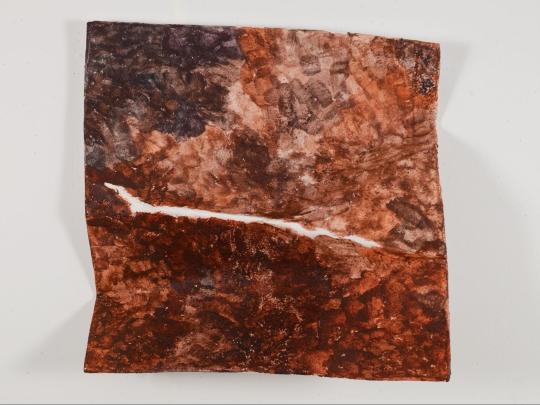
Mónica Palma, Small volcán, Aluminum sheet, calligraphic rice paper, glue and encaustic medium, pulverized volcanic rock (tezontle) and achiote seed powder, 21 x 22 x 8 inches, 2022
MP: In my case the work has been already intentionally injured or intentionally touched. I think they are already accepting of their not being imperfect. But yes, when you hold them, you realize that they need some care, but they also are allowed some level of roughness too. Just by touching, the pieces tell you what they need.
KKW: Absolutely, I'm always sort of relearning my sort of engagement with my materials. I’m figuring out new ways to pack them, new ways to build up the surfaces like there's always something that's changing. Previously, I was using rags or the side of my hand to do a lot of the smearing but I've switched over to gloves and the way that marks are built up is completely different.
MP: Totally.
KKW: There's a slickness to the touch that changes things which, and for the most part have been for the better, but then I've noticed other moments where like, Okay, I need to, like, shift the approach a little bit, right. Yeah. And, yeah, it's good. It's like it's, it's kind of like dealing with people. I mean, I'd like to think that the paintings have a sort of vibrancy and a sort of life to them that you know, they have presence.
MP: Something kind of anthropomorphic
KKW: And even beyond anthropomorphic, they don’t even need to be of the body. With the hexagon, it’s hard for me to not think about the torso, or even thinking about shields and how they relate to the body of course. But I hope that there’s this element in the work, just in how the surfaces are handled, that these marks are imbued with enough care and intention and intimacy that vestiges of myself can be felt and radiate off when you’re in the presence of the work.

Mónica Palma was born and raised in Mexico City and studied visual art at the Universidad Veracruzana in Xalapa, Veracruz. She received her MFA in Painting and Printmaking at Virginia Commonwealth University. She currently lives and works in Brooklyn, New York. Her work has been shown at TSA (NYC), 245 Varet Street (NYC), Ortega y Gasset Projects (NYC), the Nelson-Atkins Museum of Art (Kansas City), Soloway Gallery (NYC), Underdonk Gallery (NYC), and Essex Flowers (NYC). Since 2020 Mónica has been a lecturer at SUNY Purchase in the department of Painting and Drawing. In 2022 she was the AIR resident at UTK in Knoxville TN.
www.monicapalma.com @mopanana
Kemar Keanu Wynter (b. Brooklyn, NY) holds a BFA from the SUNY Purchase School of Art and Design. His work was the focus of recent solo exhibitions at Klaus von Nichtssagend Gallery, New York (2021) and Tiger Strikes Asteroid, Queens (2021). He has exhibited in several recent group shows including Notes on Ecstatic Unity, OTP Gallery, Copenhagen, Denmark, Faraway Nearby, North Loop Gallery, Williamstown, MA, and Shining in the Low Tide, Unclebrother, Hancock, NY. Wynter has been an artist-in-residence at The Macedonia Institute, Anderson Ranch Arts Center, Ox-Bow School of Art, the ARoS Kunstmuseum in Aarhus, Denmark and AQB in Budapest, Hungary (both facilitated by Flux Factory, New York). His work is held in the collection of the Art Galleries at Black Studies at the University of Texas, Austin. Wynter has forthcoming solo shows with Encounter Lisbon and Klaus von Nichtssagend Gallery in the spring of 2023.
cowfoot.studio @cowfootsoup
0 notes
Text
29. Dana Davenport & LaRissa Rogers
Dana Davenport and LaRissa Rogers discuss their experiences as Black and Korean artists and how their research and life experiences have led them to work with specific materials, motifs, and ideas. They discuss their work through the framework of family history, belonging, and Black-Asian futurity/solidarity.

Dana Davenport (DD): Hi LaRissa! I'm so excited to chat with you about our practices, expressions of identity, and interconnected histories. I came across your work a few months back while doom scrolling on Instagram. Unlike most days, I can say it was productive as it brought me to your work. I was thrilled to come across another Black and Korean artist working within similar mediums (sculpture, performance, and video). I was equally as excited simply to meet another Black and Korean person. I asked our mutual friend, TJ, to introduce us and now here we are. As I began to dive deeper into your work, I discovered so many throughlines in how you utilize the body, draw from familial history, and use specific materials to dissect identity. Perhaps, as a place to start off, can you talk a bit about your relationship to the materials that you're currently working with?
LaRissa Rogers (LR): Hi Dana! I am very excited you extended the opportunity for this correspondence. Similarly, I found your work doomscrolling on Instagram a few years back, and I was immediately a fan. It was exciting to see someone working through their identity, familial history, and materiality as a Black and Korean femme. Then a few years later, I received a lovely email from TJ, mentioning you were in LA and introduced us! It was such a great surprise, and I am so excited to start this relationship and pick your brain! Haha.
For me, material history is the easiest way to dissect and draw parallels to identity formation and larger narratives around diaspora, migration, belonging, violence, labor, care, etc... At the moment, I am working with porcelain, sugar, and soil. I began working with soil in 2019, almost as a default. I had just finished a project, “We’ve Always Been Here, Like Hydrogen, Like Oxygen,” which was a performance on the Richmond slave trail. The performance consisted of me washing my body with oranges as a ritual of self-care. At the time, the BLM uprisings were happening, Breonna Taylor was assassinated, AAPI hate was high, and I was paralyzed by the similarities in the political landscape of LA in 1992 and the current times. For me, oranges were a direct link to the Latasha Harlins murder and the erasure/silencing of Black women and girls. But, this case is very layered and complex. It's about anti-blackness, fear of others, misinterpretation, the legacy of slavery and policing, the corrupt judicial system..and I could go on. But, essentially, we have to look at this event holistically and consider all of the ways internal and external anti-blackness showed itself in violent ways. I wanted to use the Richmond slave trail and the African burial grounds to think through how we are implicated through landscape and history. It was also important for me to link temporalities and draw out similarities between these three moments in time. This performance was an outcry, an attempt at asking: “what does it mean for Black women and girls to be protected and cared for?” The title of the piece stems from a Dionne Brand quote, when the descendants of enslaved people meet their ancestors in a slave castle – where the ancestors say in awe: “you are still alive, like hydrogen, like oxygen.”
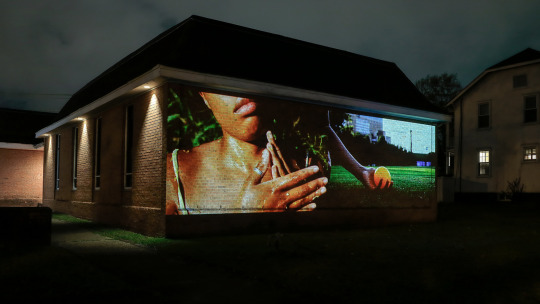
LaRissa Rogers, We've Always Been Here, Like Hydrogen, Like Oxygen, 2020. Double channel video Installation, 7min 22sec. Installed at Resurrection Lutheran Church, Richmond, VA.In Light 2020: Safety and Accountability. Photo Courtesy of 1708 Gallery. Photo by David Hale.
LR: This work leads me to work with soil. I was in online grad school at the time and had just moved back to Virginia (where I was born and raised) and did not have a studio. So, naturally, the landscape became that for me. As we already know, Virginia is a fraught place. I lived in Richmond for several years while attending undergraduate school and stayed a bit after. But, I was born and raised in Charlottesville, VA. Reading the news one day, I encountered this article about Pen Park. I grew up going to this park when I was young. My mom would take me to play at this park while we waited for my brother to get out of school. My father golfs there as well. But, Pen Park used to be an antebellum plantation. At Pen Park, there is a golf course, and on the golf course, there are unmarked slave graves. This place is not acknowledged. Around this time, I was also thinking heavily about monuments. The confederate monuments in Richmond were getting pulled down, and it seemed like every major city around the world was having conversations about their relevance and relationship to collective memory.
In Christina Sharpe’s In The Wake, On Blackness and Being, she speaks about residence time. She describes the residence of sodium held within the body being 260 million years, in relation to the enslaved Africans who were thrown, jumped, or dumped in the ocean during the middle passage. This residence time allows one to begin to think through the terms in which we understand the conditions of Black suffering. In contrast to water, the body takes approximately 200 years to return to dust when buried in the ground. As the nutrients of the body disintegrate back into the earth, how can thinking through residence time in the soil help us understand what it means for Black people to suffer when suffering is the ground?
Given how closely Black people are indexed to death, soil also holds the capacity to speak to regeneration. Historically, it is a place of Black resilience and possibility through geophagy, slave gardens, revolts, and the migration of African plants and foods to the Americas by way of women smuggling seeds in their hair during the middle passage. Soil is a living archive and speaks to the nonlinear nature of time. Saidiya Hartman’s theory of temporal entanglement questions how we narrate historical time when thinking about the afterlife of slavery. She calls us to examine the intersections where the past, the present, and the future, are not discretely cut off from one another, but rather, we live in the simultaneity of that entanglement. The ephemeral nature in which many traditions, stories, and ways of knowing are preserved in Black, Brown, and Indigenous communities becomes visible in intangible ways due to colonization. Methods of remembering that cannot be held but are protected through and within the people themselves.
Using this as a framework, I did a few projects with soil, Virginia soil, and soil from different locations with historical relevance. You can see my attention to soil in the works “Ode to soil” “A Poetic of Living” and “On Belonging: The Space In Between.” As a material, soil does a lot for me.
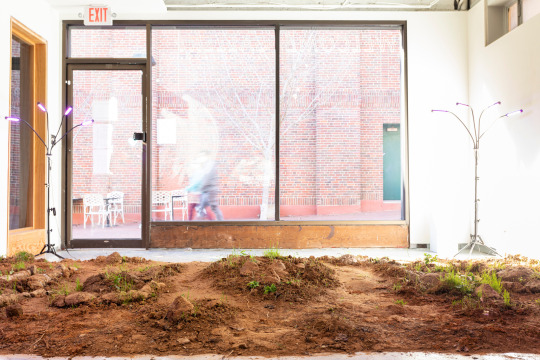
LaRissa Rogers, A Poetic of Living, 2021. installation, Dimensions Variable, Soil from Pen Park and Farmington Country Club, Celosia, Fungus, Oxygen, Light, Care. Photos courtesy of Welcome Gallery. Photos taken by Stacey Evans.
LR: I am also working with porcelain and sugar. I began researching sugar after my project with oranges in 2019. We are all familiar with the sugar trade and its relationship to the transatlantic slave trade in the Americas and Global South. But I am also interested in how sugar functions today within the US context. It disproportionately affects Black and Brown communities – operating similarly to that of the plantation system. My family has a history of diabetes and sugar-related complications. Alternatively and historically, sugar is a commodity that has connected all four continents. The first significant wave of Korean laborers worked in the sugar plantations in Hawaii. There is also an expansive history of coolie workers and indentured servitude related to sugar in the US. In the 18th and 19th centuries, sugar pastillage was used by European royalty to create table displays for admiration, then consumed at the end of the night. The sugar sculptures became a status symbol often, displaying racialized and exoticized images. With the decline in sugar’s value and the impossibility to preserve the sugar sculptures for long stints of time, sugar pastillage was substituted for porcelain. This porcelain is commonly coveted within upper-class white homes as "fine china.”
Right now I am delving deeply into Anne Cheng’s work around ornamentalism. In yellow feminist theory, the Asiatic subject becomes ornament. Whereas in Black feminist theory, the Black body is bare life, these relationships are important to me and start to touch on the complexities of my afro-asian identity and how I experience violence navigating within a world that prioritizes skin. Thinking through these two materials and their relationship to the body, the mouth, the act of hunger, the ornament – become what Anne Cheng describes as the divergence between Black flesh and Yellow ornament. Using the scars from being whipped on Sethe's back in Toni Morrison’s Beloved as an example, Anne Cheng articulated that the flesh that passed through objecthood needs ‘ornament’ to get back to itself.” This is where ornamentation, particularly the chinoiserie pattern I am researching right now becomes a nuanced symbol and not just a decoration. There are moments when the wound needs ornament – we see this a lot in Black material culture through the use of gold, chains,” swag” –but there are also many times when the wound and the ornament cannot be compared.
The chinoiserie pattern, which the blue willow pattern stems from, was something I grew up around. My mom is Korean, born in Seoul. She was a war baby and orphan brought to the US by a Black soldier stationed in Seoul during the Vietnam war. It is crucial to realize the complexity of her story on a macro and micro level. Her story is a byproduct of US imperialism in Korea, GI babies, and the beginning of Korea's large adoption project that set legislation in place to rid the country of “unpure” Koreans. At this time, there was also sanctioned prostitution of Korean women for the American military resulting in a wave of Korean mothers and American fathers, who eventually moved to the US.
For my mom, once brought to the US at age four, her adoption requirements were never fulfilled, so she remains stateless. She was raised by my grandfather's mother in a poor Black household in Madison, VA. My father, a Black man, was similarly raised in a very poor neighborhood in Newport News, VA. Growing up, my mom decorated the house in this blue and white greenware. I was unaware of the history of blue and white greenware or chinoiserie, but I was always curious about this decision. I read it as a representation of a heritage or place (Korea) that she no longer had access to. My new body of work delves into this pattern, chinoiserie -- a pattern adopted by the Europeans as an idyllic and exoticized interpretation of Asian people and life. I am interested in its relationship to diasporic distance, belonging, and everyday violence that upholds white supremacy. I am also interested in this conversation surrounding the influences, perceptions, and interpretations one performs in the creation of self. The way this pattern, a distant interpretation, a fantasy of others, became removed from its violent history within the home, assumed, and merged with a Black interior aesthetic to create a new language – one that exists in the in-between, the liminal.
For me, the liminal is parallel to notions of authenticity when working with this pattern and being mixed-raced. One should always question their perceptions of purity and outside influences of authenticity. Where does culture begin? With the start of global trade in the 18th century and the rise of capitalism — cultural symbols and objects were constantly being assumed, consumed, merged, adopted, and recontextualized. It’s a violent process. But, in specific situations, this cannibalization or hybrid transformation impacts intersecting identities and allows the violent collision to become something greater than just the violence—especially for those who have been exiled. Edward Glisssant calls this “opacity” – or a lack of transparency for and toward the other– that can “coexist and converge weaving fabrics.” He states that “To understand this truly, one must focus on the texture of the weave and not on the nature of the components.” For me, opacity has become a strategy for engaging cultural multiplicity and diasporic imagery of resistance and power. Opacity allows you to be fully seen without being owned. It allows you to occupy spaces you may not be seen as a member of. Opacity and what Fred Moten coins as “fugitivity”-- “a desire for and a spirit of escape and transgression of the proper and the proposed…a desire for the outside, for a playing or being outside, an outlaw edge proper to the now always already improper voice or instrument”-- creates portals for seeing and being seen.
Also, a fun fact, the chinoiserie pattern was used by the founding fathers (Thomas Jefferson, James Madison, etc..) to reinforce symbols of enlightenment that uphold race within architecture commonly found in Virginia...
But, I am curious and would like to ask the same question. What materials are you working with right now, and how does your background inform those decisions?
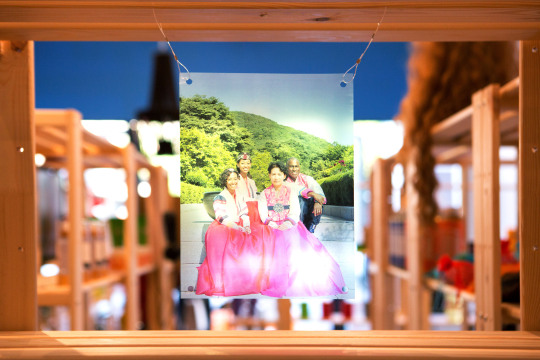
Dana Davenport, Dana’s Beauty Supply ~and relaxation space~ (detail of family photo)
, 2021,
Installation at Recess Art
, Photography by Mary Kang
DD: Wow, thank you for so eloquently sharing your relationship to the materials you’ve been working with. Your use of material and the histories that they hold really resonate with me. As you know, I was born in Newport News, Virginia and raised in Seoul, South Korea. Although Virginia is not a place that I’ve spent much time in, much of my dad’s family is scattered throughout the Virginia area so it’s where we meet for family reunions and such. As a kid, I went through many different phases. One of those phases was an obsession with America (and therefore Virginia) and claiming my Americanness to my friends who also went to school on the military base in Seoul. It sounds silly to want to “prove” your Americanness while literally going to school on an American military base. But, you know how kids can be. They’ll find anything to pick on someone about. Haha. What I didn’t know or understand at that time is how fraught of a place Virginia was and still is. The way that Virginia existed in my mind as a place that validated my belonging even though I was thousands of miles away, versus the reality that even if I lived there, there would be a constant battle for the contributions of my ancestors to be acknowledged, was definitely a plot twist for me and something that I’d become more exposed to as I’d visit more frequently over the years in middle and high school. There is something eerie about being in Virginia, walking on the land, yearning to connect with ancestors, cultures, histories, and languages that have been buried in the soil. When I feel this yearningness, it’s humbling to remember that these histories exist through and within me.
I didn’t know that the first significant wave of Korean laborers worked on plantations in Hawaii! This is really interesting to hear, as my partner and I visited a friend in Hawaii a few months back and didn’t know much about the migration of Koreans (and other Asian folks) to the islands.
I’m really interested to learn more about your exploration of chinoiserie patterns. I see your use of it in Licked Until Your Tongue Rubbed Raw, 2022 and in On Belonging: The Space In Between, 2021. Are you creating the chinoiserie patterns yourself? It is quite interesting how this pattern has shape shifted and been adopted into Black interior aesthetics. I’m intrigued by aesthetics that seem to exist in between and thinking of ways that we can create visual languages around Black and Asian experience, solidarity, and futurity. For the past several years, I’ve been working with synthetic hair and hair care products as a material that binds Black Americans and Korean Americans through the beauty supply industry, an industry that we know is overwhelmingly Korean-owned with a primarily Black consumer base. Prior to this, I was doing a lot of performance work but became weary of having to rely on the presence of my physical body in my work in order to discuss not only the tensions that I felt in being a Black and Korean woman but also everyone else's interpretations and projections of the conflicts between Black and Asian communities. It was a lot to carry. After a particularly uncomfortable performance at a “prestigious” space with a nearly all white, generationally rich audience, I took a step back from performance. At that time, I simply didn’t know how to continue doing that work in a way that was also protective of my body and my experiences. So, in saying that, I was seeking out a material that could serve as a proxy for my body. I began to think deeper about hair care and the experience in obtaining these materials. When I first moved to NY from Korea after graduating high school, I remember being baffled after walking into a beauty supply store and seeing that the folks behind the counter were Korean. This was odd, as there are basically no beauty supply stores that cater to Black hair in Korea, and there wasn’t really any talk of how this industry in the US is dominated by Koreans. I started to experiment with speaking a little Korean here and there and it would not only confuse the Korean employees and store owners, but it’d severely improve the treatment that I received. I’m talking, free samples, the works! It was an uncomfortable reality of privileges that I hold. Disclaimer: I don’t speak Korean fluently so it took some courage and pepping myself up to actually speak Korean in public. All of this being said, I became obsessed with hair, hair care, and the beauty supply as a space to be reimagined where we can have critical dialogue around our collective history while envisioning Black and Asian futurity. In this reimagining, I return to the past and think about other businesses that are Asian-owned, in Black and Brown neighborhoods and how they are some of the few spaces where Black and Asian folks may find themselves intermingling. I think about the murder of Latasha Harlins. I think about my mom’s friend who’s worked at a beauty supply store for more than 20 years in Virginia (my mom and her friend are both Korean). I also think about early Chinese immigrants that opened grocery stores that served former slaves. They were successful because they offered goods at lower prices compared to plantation commissaries that inflated their prices to keep former slaves in perpetual debt. And of course, I consider the ways in which The National Housing Act of 1934 made it nearly impossible for Black folks to start businesses within their own communities.

Dana Davenport, Dana’s Beauty Supply ~and relaxation space~
, 2021,
Installation at Recess Art,
Photography by Mary Kang
DD: You studied Painting and Printmaking in undergrad at VCU and are now at UCLA in New Genres. Can you talk a bit about your journey from painting and printmaking to sculpture, performance and video?
LR: Thank you for your openness and criticality in articulating the tensions that arose from your experience, material practice, and journey as an artist. I resonated with many things you said and even found myself getting out of my chair and snapping my fingers in agreement because of it. Haha.
Firstly, when you were talking about your experience growing up in Seoul on a military base and feeling the need as a child to prove your Americaness – your virginianess -- was something I connected to. In my case, because I was born and raised in Charlottesville, it was not necessarily my Americaness I felt the need to prove, but my Asianness. I went to a predominantly white, upper-class private school, and I distinctly remember this moment on the playground when I was asked by a white classmate “What are you?” At this moment, I already knew I was different. I was one of maybe three Black kids in my grade for many years, but as a child, I had recognized the cultural currency my mom held as a Korean woman that my dad did not as a Black man. At that moment, I felt the need to legitimize my Assianness because I thought it would give me some sort of advantage. I longed to be accepted and included by my peers. There was always a feeling of not being accepted by the Black community or the Korean community. This was for a lot of reasons. My mom's relationship with her motherland was severed. Her connection to Korea and any sort of Korean roots is fragmented. Mine even more so. I did not grow up around other Koreans. My body also gets read as Black in the US. My Blackness has been prioritized because it has been perceived as more of a threat. How do we begin to talk about psychological violence? How do we begin to talk about these entangled and complex realities and relationships between Black and Asian futurity? How can we talk about belonging and arrival in the context of Black and Brown worldmaking? What are the tensions between belonging and fugitivity? Beauty and horror? Opacity and transparency?
Right now, I’m really sitting with Saidiya Hartman's offerings around monstrous beauty.
I say this and also recognize the privilege and complexities I hold being mixed-race.
I love your work and how you use the body as a material. Not just physical body, but hair as body. You asked about my relationship to the medium, particularly studying painting and printmaking and working primarily in sculpture and installation now. My journey was very similar to yours in a sense. In high school, I began to consider art as a career, and my introduction was primarily through painting. I fell in love with oil paint. The layering of color and texture, the manipulation, and the capacity for a single brush stroke to encompass expression and emotion. I went into undergrad knowing I wanted to be a painter. After the first year, that reassurance shifted. I took a time-based media class, and I was not great at making videos– but I did one performance, and something clicked. Through movement, material, place, and sound, I was able to tap into a sensory experience that felt more true to the emotion and criticality I was attempting to create in figurative painting. In the last two years of undergraduate school, I didn’t make a single painting. I began to work with hair and created a series of videos, sculptures, and performances that tried to pull out some of these tensions I felt navigating my identity.
I continued to make videos after undergrad, but I didn’t consider myself a sculptor at the time. It wasn't until after I graduated that I found object making through installation. Painting was such a distant memory at that point. Another reason I didn’t continue with painting is that I felt it was not able to do what I needed it to do. It couldn’t tell the story I was trying to convey, and the history of the medium is so fraught. I didn’t want to contend with it.
I then moved into performance. In the work with oranges, I was thinking of my body as orange. But, as I continued to perform, I would similarly get triggered. Especially performing to predominantly white audiences. This felt unsafe for my body and experiences. It got so exhausting that at one point in “My body is the architecture of my Every Ancestor,” (performed a few days after the Atlanta spa shooting) I performed inside the gallery through their “storefront window” making the audience watch the performance outside. I then pushed back the audience even further — to the sidewalk— to view the performance. I was trying to create distance, some sort of mediation of the violence of the audience, their gaze, and their interpretations of my body. I felt like an open wound, especially after my first year of graduate school. I felt vulnerable and constantly oozing…constantly being split open. Looking back, this is the moment I subconsciously turned to material as a stand-in for my body. A proxy that could be read in relationship to, but without my physical presence. This also allowed for larger narratives and histories to merge into the work.
As I continue to make performance and work that is non-archival in nature, I ask myself, what does it mean to build a practice that resists collectability/ownership and demands extensive care for its upkeep? As an ethos, how can I resist the market as a place of only transaction?
Going back to your question surrounding chinoiserie. I am starting to create the patterns myself. In "On Belonging" and "Licked Until Your Tongue Rubbed Raw '' I had not started to create my patterns yet. At the time, I was still grappling with the dissemination of these patterns. For my mom, it was less about the particular landscape within the pattern but more about the blue, white, and porcelain combination. You can now see within an American interior aesthetic, blue and white has become an interior decorating staple. The blue and white pattern has been adopted by many different cultures around the world. The interpretations, redactions, translations, adoptions, and reinterpretations don’t stop haha. This was intriguing to me because this pattern is synonymous with the colonial project. At that moment in time, I wanted this aspect of the work to be digested. The everydayness of this violence within this pattern. I was using generic interpretations of the chinoiserie to talk about the interpretation of the interpretation. The didactic. The performance of it. But now, I am less interested in that and more interested in how the pattern can be flipped or incorporated into my myth-making to generate something else. Similar to how I witnessed the pattern functioning in my home - a place of a combined Black and Korean interior aesthetic (though blue and white stems from a Chinese tradition). I am currently meditating on the beauty my mom has created through proximity of objects within the home. The rituals she has implemented so our family can begin to mend generational ruptures. For her, these mendings happen with food, and at the table. A type of physical and emotional nourishment that can happen in the home. This ability to mend and create beauty out of the monstrous, out of violence— it is a superpower. It is the Black radical tradition. It is the in-between. It is in the liminal. It is neither here nor there. It is the place where entanglement creates new futurities. It is everything all at once.
I am also curious about the aesthetic merging that happens in your work. Especially the chandeliers and Synthetic hair. Can you talk more about why the chandelier and how you landed on that form/object?
Also, in your works ``Much Love” and “experiments for relaxation” you’re working with multiple notions of care. How are you thinking through the registers of care that are required to nurture a critical dialogue surrounding Black and Asian futurities and solidarity? More specifically, What care is required to nurture yourself, your history, and your family's story? How are you thinking through care, and how do photography and family archives aid in telling this story?
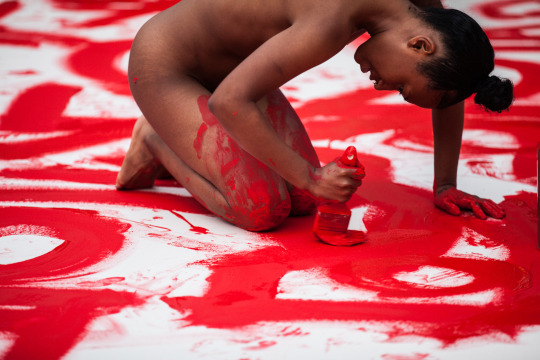
Dana Davenport, 흑인 (heugin)-black person,
2017,
Performance at Watermill Center,
Duration: 2hrs,
Photography by Maria Baranova
DD: Ahhh, that very familiar feeling of wanting/needing to prove your Asianness. It’s wild that even at a young age, we unconsciously understand privilege and where one is situated within that system. While I was obsessed with America for a bit, that phase was short lived. My desire to “prove” my Asianness is unfortunately something that has taken much longer to shake off. In a lot of ways, my art practice played a huge role in that process. It provided me an unrestricted space to express all of the messy, contradicting, and nonlinear feelings that I was moving through. Initially, it was a lot of bottled up anger, a desire to be embraced by Korean culture while simultaneously resisting it in fear of rejection. This is most clearly articulated in my performance piece “흑인 (heugin)-black person”. In this performance, I write the word 흑인 repeatedly on a blank canvas on the floor. Gradually, the task became more aggressive resulting in exhaustion, examining the arduous notion of performing identity. Have you found that your relationship to Korea/Koreaness has shifted over time? And if so, what was influenced these shifts?
While our experiences differ in ways, I’ve arrived at similar questions. “How do we begin to talk about these entangled and complex realities and relationships between Black and Asian futurity?” I definitely don’t have an answer but something that I think about a lot is where are Black and Asian folks are interacting the most and under what conditions? I feel as though, within America, store owner/customer settings are the most common spaces in which Black and Asian folks gather. Commonly, Asian-owned shops in Black neighborhoods. So, that’s where I’ve started and how I arrived at the beauty supply as a space to be reimagined. I didn’t know that you worked with hair in the past! I’d love to see some of that work. I’m really fascinasted by your research around chinoiserie patterns, as it’s something that I’ve seen in so many places in totally different contexts but never stopped to think about how it lived between these spaces (I also never actually knew what the pattern was called). I always viewed it as an “Asian-coded” artistic style (often seen on vases and such) but then would also see as a wallpaper in some preserved colonial mansion in Virginia and not think twice about the overlap between the two. This pattern is truly a chameleon! I love how you are thinking about the next lifeform of this pattern, how it can shape shift to reflect a new culture, a combined cultural aesthetic, how it can be flipped as a tool to mend wounds. As you said, it is our superpower to mend and create beauty out of the violence we and our ancestors have endured. When I began working with hair, I started with simple domestic objects. A vase, slippers, rug, etc. I wasn’t really sure why, I was just drawn to it. As someone who studied Photography in undergrad, I hadn’t really considered myself a “maker” and definitely didn’t have the tools at that time to create the sculptures that I’d envisioned. Out of the many ideas that I’d jot down (and often talk myself out of trying) creating a chandelier was one that stuck. In the Summer of 2018, a family friend, Dan, offered to teach me how to weld. That changed the game for me as far as the tools that I had to create. Initially, I was drawn to the chandeliers because of their ability to elevate a material that, when worn and activated by Black folks, is criticized as ghetto, cheap, fake, and unprofessional. As I’d hang them within my studio and home, incorporate them in installations, and hang them in gallery spaces, they began to take on a protective role, setting the tone for whatever room their in and requiring that viewers look up at them with appreciation and awe.
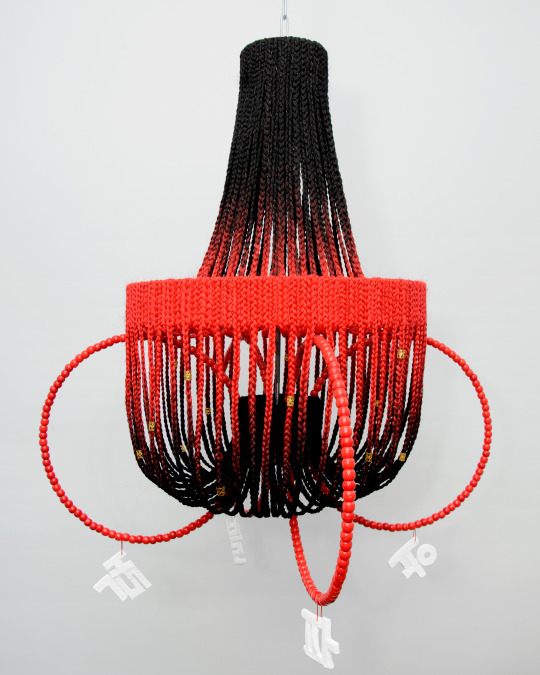
Dana Davenport, Box Braid Chandelier #3, 블랙파워 (beullaegpawo)-Black Power, 2021, 30in x 25in, Steel, plastic beads, modeling clay, synthetic hair from Hair Style 21 (Online)
DD: Years ago, I created a piece titled “Questions Not To Ask The Artist”. It was a large piece of wood (the size of a door) that listed several things I was simply tired of being asked by viewers of my work and visitors to my studio. I was at the ChaNorth residency at the time and I placed it right in the entry way to my studio. It served as a sort of agreement between myself and viewers entering my space. I find that the chandeliers function in a similar way. In “Experiments for ~Relaxation” which was performed at Gibney Dance (New York, NY)I was processing alternative ways of performing that weren’t focused on the production of labor. I wanted to push myself to explore what relaxation could look like for me. What does rest look like for bodies that look like mine? How do we achieve mental and physical relaxation? The creation of this piece was chaotic. I found that it was actually quite difficult for me to achieve a state of relaxation. This pursuit, the awkwardness of it became part of the piece. “Much Love” was a really beautiful collaboration with Jazmine Hayes at Swivel Gallery (Brooklyn, NY). Together, we created a space that spoke to restorative practices of protection and care, transforming the gallery into what felt like a domestic space. Reminiscent of your grandmothers home with pink painted walls and red carpet. A space where you were protected, where you could release, where we honored ancestral practices. The back room served as a meditation and alter space, calling forth generational repose and threading together themes of love, labor, ritual, self-care, and communal care. We interspersed our family photos and hung them throughout the space, connecting our families and our histories. Photography and family archives are really how we mark our time in this world, how we claim that we are here. We exist. It allows us to write our own narratives and have some aspect of control over how we are represented. Family albums impact the way that we connect with the memories that we hold and how we tell stories and pass them down. My mom always made it a point to ensure that we took a lot of family photos. Unfortunately, there are only two photos that my mom has from her childhood. When she was young, her home caught fire and with it went whatever photos her family had (which probably wasn’t many to begin with). On the contrary, my dad’s family has a huge archive of photos. I recently inherited a box full of them and have had so much fun flipping through, reading all the hand written notes, and asking my reletatives who certain people are. From that box, I found a photo of my mother, sister, and a few other family members, sitting on a brown couch at my grandparents house. It had to be from 1993 or so. The carpet in the room was a dark red was nearly identical to the carpet in the “Much Love” exhibition. That was a real treat to come across. I think that to be in solidarity with eachother we must first see eachother. Literally, seeing eachother in space and metaphorically seeing eachother within ourselves, within our histories, and as living, breathing, feeling individuals. It’s important to understand how the past factors into our realities in the present but it’s equally as important to dream of our futures. Care is conveyed when we hold ourselves accountable. When we place trust in eachother. When we can share space. For the past few years, language has played a large role in how I nurture myself and my own familial history. After years of feeling embarrassed for having lived in Korea for so long and not speaking Korean, I finally started taking Korean classes. I resisted for many many years, as I’d convinced myself that learning the language meant I was surrendering in some ways. Surrendering to a culture that rejected me and my Blackness. Honestly, I just had to get over that and understand that I can show up for myself by allowing myself the freedom to learn, to recontextualize, and to grow in this way. I’d like to ask you the same question. It feels like a beautiful note to come to a close on. How are you thinking through methods of care as a tool to nurture critical dialogue around Black and Asian futurity and solidarity? What care is required to nurture yourself, your history, and your familial lineage? And how does photo documentation and family archiving contribute to these forms of storytelling?

LaRissa Rogers, My Body Is The Architecture of My Every Ancestor, 2021. Performance, 1 hr 15 min. Performed at the Bridge Progressive Arts Initiative. Photos taken by Chan Williams.
LR: You begin your response by asking if my relationship with Korea/Koreaness has shifted over time, and I think it has. The work is a direct timeline of that shift. The Latasha Harlins case was my first stepping stone. The interaction between Soon Ja Du and Latasha Harlins speaks right to your articulation of what solidarity requires– for us to see each other individually and collectively within shared experiences and histories. Within Latasha Harlins’s and Soon Ja Du's interaction, there were fundamental misinterpretations of the “other,” and those misinterpretations are based on our system that can only survive by pinning us against one another. In “We’ve Always been here, Like Hydrogen, Like Oxygen” I directly speak to this in some of the text overlaid in the video which reads, “you and I are connected.” When I wrote it, I was thinking of Latasha Harlins but also Soon Ja Du. This conundrum reminds me of a quote I read from Scott Kurashige that states: "The 'model minority' stereotype isn't meant to define Asian Americans. Rather, it's meant to define African Americans as deficient and inferior to white people by using Asian Americans as a proxy...It was never an accurate portrayal of Asian Americans." Though I had discomfort, sometimes anger, a deep sense of loss, and a longing to be more connected to my Koreanness I needed to recognize within myself why I felt tension and separation. I use my art as a way to heal and as a means of owning my Koreanness while acknowledging my positionality within it as someone distant from the place and culture. Coming to terms with this was something I had to get over and required me to be soft with myself. But care is hard! Often we forget that. Care is a lot of work. Sitting within the pain, within the hold – as Christina Sharpe would say is not pleasant work. That is what I am trying to do with my work. It is also how my relationship with my Koreanness shifted. I am no longer preoccupied with proving my Koreanness, legitimizing it, or ignoring it, which I did for many years. Embracing and attempting to learn my history and heritage-- one I also feel does not fully embrace me at times– is an attempt to understand my mother's experience, my experience, my father's experience, and the histories of entangled experiences. It is not an either-or. It is a both and. A hybrid approach that has allowed me to reject categorization and politics of authenticity that felt restricting and violent.
It's interesting to hear you speak on the few images your mother has of her childhood because similarly my mother only has a couple of images left from when she was a child in Korea. Her father discarded most of them when she was young. Alternatively, my grandmother on my mom's side made many photo albums. When she died, the photo albums were gifted to us. In my last year of undergraduate school, I remember going through all of the photos for the first time. I would ask my mom about members of the family that I could not identify. This was a way to connect to my family and the family my mom adopted into. My grandma also loved embroidery, and every so often when I was going through the box of photographs I would find notes on the back of images, and embroidered handkerchiefs with quotes or rhymes. It was really surprising for me to discover these notes because I would never classify my grandmother as a jokester. But, a lot of the images had inside jokes written on the back of them. It was an entirely new way I understood my grandmother. By 2019 my grandmother had passed away, but I had a show “Invisible Weight” where I used her embroidered handkerchiefs as a mode of rememory and collaboration.
My great-grandmother was also a great archivist, though many family photographs were lost in a house fire.
Growing up, my mother was very good at documenting our lives. My siblings and I have a “life book” that tells our childhood story until high school. Many photos in my “life book” show up in my “Brown Paper Bag Series” from 2019. This book includes adoption photographs, songs, family vacations, holidays, and images of loved ones. Looking back, this was another present my mother gifted the family as a healing mechanism. She continued a labor of care that women in my family had done for generations. She made sure we documented our lives so we could feel seen and know where we came from. How does one memorialize the everyday? I would argue, through family archives – visual and embodied.
Solidarity requires grace. I have eight siblings, and most of them are adopted. Despite adoption, my family is close. Our home was also a foster home for many years. People cycled through, all of who came with their own “baggage.” I learned at a very young age that communing with people from different experiences and backgrounds requires empathy and grace. Grace for others, and yourself. Grace softens. Grace allows us to listen and hear, to nurture and understand. Grace creates space for everyone's story, history, and experience. In order to create new futures we need to acknowledge the past is not the past and difference is inevitable. Yet, through acknowledgment and accountability, new ways of being can emerge. In the words of my mother, care and repair requires one to "die to self."

Dana Davenport (b.1994) is a Korean and Black American interdisciplinary artist raised in Seoul, South Korea. She is currently based between Los Angeles and New York City. Her work shifts between installation, sculpture, video, and performance. Davenport's work has been shown throughout the United States and internationally including Gibney Dance, New York, NY; Watermill Center, Water Mill, NY; NYU Skirball, New York, NY; Brown University, Providence, RI; Swivel Gallery, Brooklyn, NY; Cultural Center Recoleta, Buenos Aires, AR; and Seventh Gallery, Melbourne, AUS, to name a few. Davenport is currently a 2023 Center For Craft Fellow and Bandung (MoCADA + A4) Artist Resident. She was selected for the Recess Session Residency in 2021, and received the 2018 Chashama ChaNorth Fellowship. She co-organized Free Space, month-long programming at Miranda Kuo Gallery in 2018, and is the founder of Dana’s Beauty Supply.
www.danadav.com @dana_dav
LaRissa Rogers (b. 1996) is a Black and Korean antidisciplinary artist raised in Ruckersville, VA. She is currently based between Virginia and Los Angeles. She holds a BFA in Painting and Printmaking and BIS in International Fashion Buying from Virginia Commonwealth University. Rogers has exhibited and performed in institutions such as Frieze Seoul (Korea), Documenta 15 (Germany), Fields Projects (NY), 1708 Gallery (VA), Second Street Gallery (VA), Black Ground (Colombia), W Doha (Qatar), The Fronte Arte Cultura (CA), LACE (CA), Grand Central Art Center (CA), and the Museum of Contemporary Art (VA) among others. She received the Visual Arts fellowship at the Virginia Museum of Fine Arts (2022) and the Black Artists and Designers Guild Creative Futures Grant (2022). Rogers attended the BEMIS Center of Contemporary Art Residency (2022), Black Spatial Relics Residency (2022), and SOMA (2019), among others. Rogers is currently pursuing her MFA in New Genres at the University of California Los Angeles.
www.larissamrogers.com @larissa_rogers
0 notes
Text
28. Hyun Jung Ahn & Bonam Kim
Hyun Jung Ahn and Bonam Kim discuss Bonam’s solo exhibition at AIR Gallery, how their experiences as immigrants from Korea has informed their work in different ways, and the ideas they are working through in their new work.

Hyun Jung Ahn (HA): Hi Bonam, I’m so excited to have a conversation with you. I've seen your work for a long time since we went to M.F.A at Pratt Institute, but I think it's the first time to discuss our work in detail.
Bonam Kim (BK): Thank you. I’ve been following your work and I’m excited to be having this conversation with you.
HA: I heard your solo show is coming soon. Congratulations! When is the opening of the exhibition? Can you tell me about the solo show at A.I.R gallery in NYC?
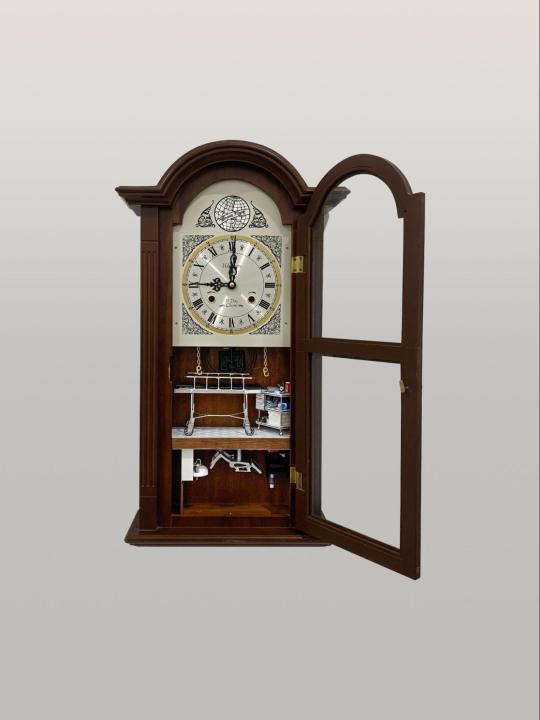
Bonam Kim, Untitled (1990-2005), 2022, Wall clock, dollhouse miniatures, wood, 26.5" x 13.75" x 5.5"
BK: Yes, I’m so excited about it. The opening is on February 11th. One month from now. I can’t believe it’s been four years since I had my last solo show. It was supposed to happen last year, but the schedule has been postponed due to the pandemic.
I’m showing six new sculptures and three old pieces in this exhibition. The last three years made me significantly aware of my personal relationship to space, given that we were stuck inside for so long, I had a long time to reflect on how we render and represent habitats. I remember growing up with my brother’s architectural models and drawings scattered around our house. I was captivated by the relationship between model and space, I gained an acute sense of my spatial surroundings. This sensibility, combined with my love of making things with my hands, led me to constructing miniatures of my world. Based on this idea, I created six different miniature spaces and invite viewers to navigate not only the spaces I have occupied physically, but also the psychological space of my experiences and memories. By manipulating scale and taking a bird’s-eye view perspective, I reclaim power over the past and present.
HA: I can’t wait to see the new works in person! We both are originally from Seoul, Korea, and currently live and work based in Brooklyn, NY (I’m in Seoul for a teaching job for now, tho). Generally, we had similar experiences in a similar timeline, but the ways we understand the world and express thoughts are totally different, and I love that. My abstract paintings seem like an enigma, but actually, it was my own method to overcome the language barrier when I moved to NYC for the first time, and it’s still evolving to explore the relationships around me. I've noticed your work is more about immigrant identity based on your experience as an alien and the way to survive outside of the motherland. Can you tell me any current or specific experiences that inspired you?
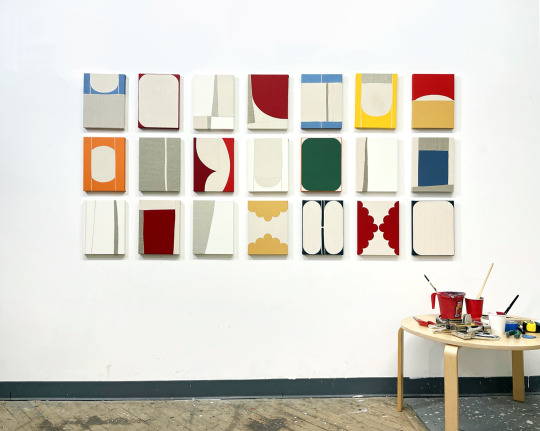
Hyun Jung Ahn, Installation of Painting Diary_November, 2020, 2020, acrylic on sewn linen, 12 x 9 in each
BK: I create my body of work based on ideas coming from my personal experience of displacement and my struggle with cultural identity. Since I’ve lived in the US for 9 years, I’m getting used to the systems here, but still my life experience as an immigrant inspires me to make my work. These days I’m interested in memories that are related to a sense of belonging, specifically due to a loss of my grandmother last year.
HA: I’m so sorry for your loss. You and your family must go through a difficult time last year.
BK: Thank you. I went through a very difficult few days. I have so many beautiful memories of living with her before moving to the US, but only a few objects left behind are in my possession. Among them, I have beads from my grandmother who was very into Buddhism, and she had always carried them to a temple and then gave them to me before my departure to the US. They are for protection in spiritual way. I want to express these two mixed feelings: existence and absence through these objects. In order to express these feelings, I started thinking about using the growth of fungi to erase the surface of them to express passing the time and memory. I think I need some experiments before going ahead since this is my first time using living organisms to my work.
HA: I think it’s beautiful to transform memories into your art. I’m sorry again. And hope your new idea goes well with the work.
Since you mentioned passing the time and memories, I remember one of your old works, which I love most, the suitcase piece that has all your previous artworks together. I think it’s fascinating, but I didn't have a chance to ask about the meaning of it. Can you tell me more about the work and what did bring you to begin to create your own tiny miniature world?
BK: That work titled The Story of a Stranger is very important piece for me. I have moved many times from one place to another since I came to New York. Keeping my work as a miniature allows me to hold onto it. I have recreated in miniatures the full-scale projects I made in the past and put them into the trunk. This work represents my time and history here.
HA: That’s interesting. I think your work has a strong theme and consistency. What do you want people to see or know through your art?
BK: I think art is for communicating with people. I hope my sculptures create a pause for the viewer to connect with their own soul and experience, reflect on the mysteries of life.

Bonam Kim, Untitled (401 Suydam Street), 2022, Dollhouse miniatures, wood, paint, paper, 36" x 24" x 23"
HA: Yes, sure. That’s the biggest role of art, communication with people in its own way, and as you said, it can let people see what they have in their mind. I always wonder what viewers can see through my work since there is so much blank space to fill on the paintings. Lately, I’ve been working on a set or diptych of paintings, not a single piece, to study the relationship and the rhythm between the images. I think most of the process of my work, cutting (fabrics), stitching them again, and images with connected shapes are based on a concept of 'relationships' no matter what it is. I’m not sure where it goes yet, but I really like the way I explore for now, so I just let this happen.
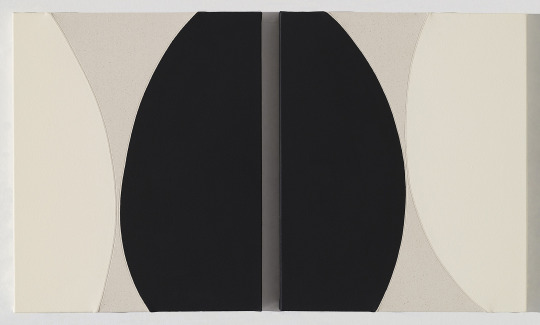
Hyun Jung Ahn, When I Met You, 2023, acrylic on sewn canvas, 29 7/8 x 17 7/8 x ⅞ in
HA: As much as I love learning your thoughts and your world via this conversation, I would love to visit your studio. Maybe it’s a little bit early to ask, but do you have any idea that you want to try or experiment with?
BK: I have been learning ceramics since last September, and I’m trying to expand the materials that I use for my sculpture. Working with clay makes me relax, and I like the fact that it’s easy to control with my hands. My work tends to be accurate and mostly has geometric shape, but by using soft materials like clay and plaster I want to express my feelings in a more organic way.
HA: I’m looking forward to seeing your new work. Thank you for participating in this conversation, and I appreciate your time! Best wishes for your solo exhibition.

Hyun Jung Ahn is a Brooklyn-based multidisciplinary artist from Seoul, South Korea. Through her work, she investigates enigmatic abstract forms, which she references as “shapes of mind.” She begins by drawing from her visual diary, which captures feelings, personal connections, and emotional states of being. She then translates these notions into minimalistic drawing, painting, and sculpture. Ahn was selected as the 'Emerging Young Artist' at La Mer Gallery, Seoul, South Korea, and was the winner of the Emerging Art Award at Baditto Art, Tuscany, Italy. She has attended residencies, including Vermont Studio Center, Johnson, VT, MASS MoCA, North Adams, MA, and Trestle Art Space, Brooklyn, NY. Ahn Graduated from Duk-Sung Women’s University, Seoul, and received her M.F.A in painting and drawing from Pratt Institute and currently lives and works in Brooklyn and Seoul.
www.hyunjungahn.com @about.ahn
Bonam Kim is a sculptor based in Brooklyn, NY. She received her BFA and MFA degree from Hong-ik University in Seoul, South Korea. In 2016, she completed her second MFA in sculpture from Pratt Institute in Brooklyn, NY. She was featured as an emerging artist from DongBangYoGae in Art in Culture magazine, published in Seoul, South Korea. She was also awarded the Stutzman Family Foundation Graduate Fellowship for her residency at the Vermont Studio Center in Johnson, VT. She has completed a three-month residency at NARS Foundation in Brooklyn, NY and the Wassaic Project in Wassaic, NY. She has exhibited work at NARS Foundation, Tiger Strikes Asteroid New York, SOHO 20, The Korean Cultural Center, Super Dutchess Gallery, and Denise Bibro Fine Art, among others.
www.bonamkim.com @bonamkimstudio
0 notes
Text
27. Janna Ireland & Manjari Sharma
Janna Ireland & Manjari Sharma discuss the evolution of their work, navigating the nuances of photographing one’s family, juggling family, career, and patriarchal attitudes towards artists who are also mothers.

Janna Ireland (JI): Thank you for inviting me to do this with you.
Manjari Sharma (MS): It's my pleasure. I have looked at your career and looked at your work for a long time, and it's a pleasure being able to discuss it officially other than all the unofficial times we've been able to chat with each other as friends. Should I start with a question?
JI: Yes, please.
MS: I would love for you to talk a little bit about Milk and Honey, which is the first body of work that I learned about.
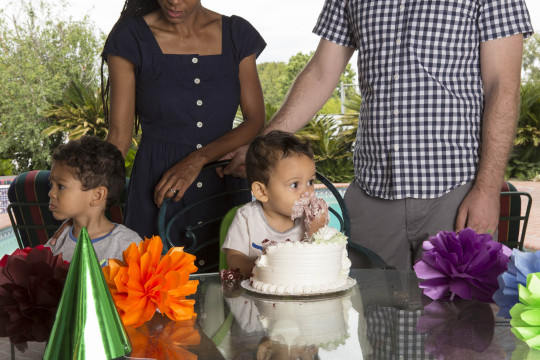
Janna Ireland, “Birthday Boy” from Milk and Honey, 2018
JI: Milk and Honey is a sequel to a body of work called The Spotless Mirror, which was my thesis in grad school. For The Spotless Mirror, I was photographing myself at my husband's grandfather's house here in LA in the San Fernando Valley, and just kind of pretending to be this person who lived in this kind of grand home in the Valley with this pool on this tennis court, and dressing myself up to look as though I could be the person who lived there. After my kids were born, I began photographing them there, and thinking of them as people who had a different relationship to the space, as people who were born into a family that has those kinds of resources and just kind of expected them, and thought of them as part of their lives.
It was a continuation of The Spotless Mirror, but also, I hope, something that could stand on its own. That work became Milk and Honey.
MS: What inspired the name?
JI: It comes from the Bible. The Promised Land is described as “a land flowing with milk and honey.”
MS: A lot of this work makes me think of having this outer body experience where you’re looking at yourself as a part of a world that you didn't originally belong to perhaps? I see you stepping into a kind of a costume, so to speak, and playing a role. And your expression in so many of these pictures has a departure from the scene that you are in. I mean, that's what I find really interesting about this work is that I see you almost in conversation with the camera and it feels like you are letting the camera record some kind of a sync missing between what you feel and where you are. But then, you talk about how your children don't have that separation because they were born into it. How do you see yourself communicating about this work to them at an older age?
JI: Oh, that is a really interesting question. As they grow up, I imagine my work will always be something going on in the background that they don’t think all that much about, and then, one day, maybe when they are in their 20s or something, maybe they will have an a-ha moment, and understand that I was trying to talk about class and race and all these other things in this work that they were a part of.
The work that I'm doing with them right now is much more spontaneous. It's more like they're doing something that is interesting or beautiful, and I run and get my camera and try to record it in a way that's sort of natural and doesn't interfere with the activity.
With the older work, Milk and Honey, they don't remember doing it, but we go to see it. We just saw it at LACMA.
MS: And they understand that it's them.
JI: Yeah, but they don't have the memory of doing it, and they don't really know what my intentions are, or what it means. They know that I'm an artist, and that it's art, but don’t really have a full grasp of what my work is, and what their participation means.
MS: Did you feel like you had a sense of belonging in that world, in your in laws home or you didn't?
JI: At the beginning, I didn't, and that's what the work was about. And then, through being there again and again to do the work, I came to know the people in the family more, and then I felt a sense of belonging.
MS: Interesting.
JI: So we would go to brunch, and then I would take pictures, or we would watch a Lakers game, and then I would take pictures, and I just became part of the family through these pictures that started as being about confusion of being part of this family that was so different from mine.
MS: There's this picture where you're looking into the mirror, and you have the mirror that has the ring like all around it, it looks like there's a tear under the left eye. Is that what it is? Is that what I'm looking at? Or is that like an illusion?
JI: I think it's an illusion. That’s one of a few pictures in that body of work that are actually taken at my house while the kids were napping or in bed. That was one of the first pictures, where I was kind of breaking away from the location and trying to figure out how to continue the ideas when I couldn’t be there.
MS: Do you feel like you started in a place of questioning your place and ended in a place of making family with that place?
JI: I think that's true. I think I questioned it at the beginning. I just wasn't confident in myself as a member of this family. Doing the work helped me gain that confidence, not only spending more time with people and forming those relationships, but the way they related to the work and their excitement to see the work, and to see these familiar places interpreted.
MS: How did they respond to it?
JI: Someone asked me a really interesting question the other day about the way that the work sort of points to the strangeness of certain parts of the lifestyle. There's that tension there, and then also that it's work done in a place owned by people that I love, but it’s pointing to the strangeness of their life. They handled it really gracefully and are really supportive of it.
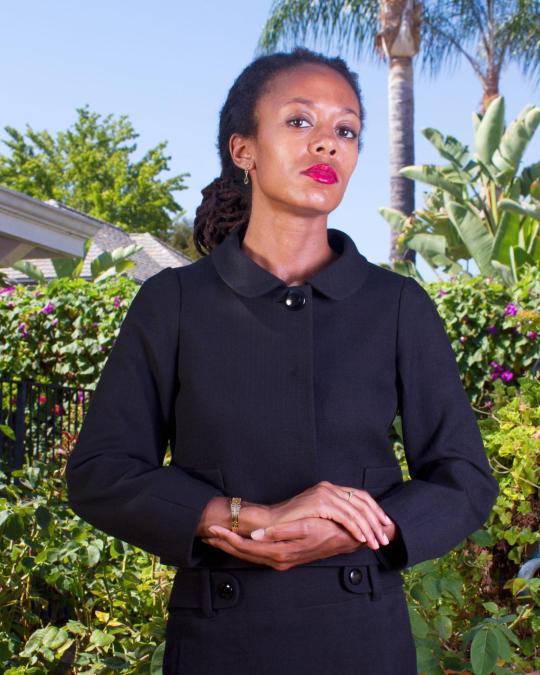
Janna Ireland, “The Black Suit” from The Spotless Mirror, 2012
MS: I don't see any writings in here about Milk and Honey. Is there an artist statement where you state that awkwardness or confusion that you felt in the transformation?
JI: The statement for Milk and Honey is pretty short. With The Spotless Mirror, because it was my MFA thesis, and I had to generate writing about it. I ended up feeling like I explained too much of it, and I didn't let the work sit on its own. For Milk and Honey, I kind of pulled back in terms of how much I explained to people about what was going on. I want to keep some of that to myself.
MS: Is Milk and Honey done?
JI: It feels done, but it also feels like I could at any time take a picture that fits into it. But maybe that's just the way that I work.
MS: I feel like I'm asking you a question that sometimes annoys me when people ask me. A part of it is also that you are in that adventure yourself– the work is a kind of a call and response. You just never know when you create a piece that might reference itself back to a concept or an idea that you were working on years ago, or maybe, the same piece can find itself in different families sometimes. So I hear you. It's not linear in that way.
JI: What has your dad's experience of the work that you made of your parents been?
MS: It's interesting, because I’ve been taking pictures of my family my whole life. So when he looks at the pictures I made of my parents as my mother progressed through her dementia, I think he maybe recognizes that I'm trying to capture this intimacy between them, but I don't know if he sees it from my perspective. Perhaps he understands it from the perspective of the act that he is lost in. One of the things that I cannot get over is how completely absorbed he is in the act of caregiving. Over the years I have found myself just enamored by this little bubble my mom and dad have created in their own slow universe.
Sometimes when I show him the pictures I find that he notices the very thing he was probably doing in that actual moment. He says, “oh look your mother seems like she has really lost weight in this picture.” I can tell he doesn't notice himself in the picture. He's totally conditioned himself to be checking on mother at all times. What I think is really interesting is that while I’m the artist making the work, I am also a daughter making a portrait of her parents. Papa doesn’t have that duality. Maybe when he sees my photograph he's trying to remember what Mom was potentially experiencing? His life has become trying to think for her, and he functions around guessing what she may need or may not be able to communicate for herself. I hope that work is a book one day, and perhaps in the collection of those photographs he will see something different than what he sees when he looks at an individual picture.
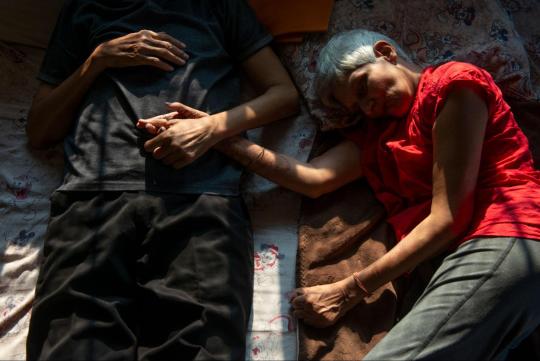
Manjari Sharma, Loss and Resurrection, 2020
JI: It's very difficult to explain to your family what you're doing and what it means when other people are looking at it as art, and what you're going to do with it.
MS: For the longest time when people looked at the work they said, “what are your goals with that work?” I used to find it offensive. I'm not really that type of person who takes offense but I was at odds with trying to look at that work as a “project”. It felt like such a stretch for me to put that work out into the world, and a next level stretch for me to turn it into prints or try to make some aesthetic semblance of the flow. It was a scar that I was willing to share, because I think I was so desperately looking to find a silver lining in that story. And really that whole body of work is my attempt to look for a silver lining, because what's the silver lining in the loss of a parent? All of a sudden my mother’s speech was gone, her mind was gone…. my art helped me make some sense of it. “Mom” has always been my source of inspiration and positive energy, and in some way the work I made of my parents took its place.
JI: What is a family? What are your personal reasons for making that work?
MS: Sometimes the work feels so private and emotional that it feels hard to put it on some kind of a convenient contextual display for the world to interact with. I think work that cripples you in some way, or puts you in a difficult place is where your most meaningful work comes from. So I do think for better or worse, we are like in the business of going towards the very thing that maybe logic wants you to walk away from.
JI: As I've come to know you, I’ve come to know your family, and it has been interesting to look back at your work again, knowing them. For example, look at your shower series and go, “oh, there's Bill,” or I’ll look at pictures that you made when I knew you were pregnant with Nora, and they feel extra special because I know her, too.
MS: Right, as I get to know you, my relationship to your work changes.
JI: Yes. And so much of that is just experiencing your family through your work and then experiencing them as real people.
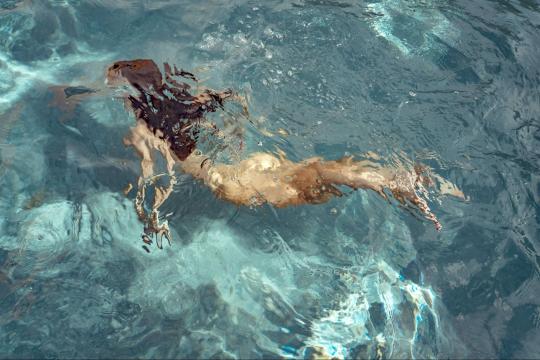
Manjari Sharma, Untitled, Surface Tension, 2017
MS: That's the beauty of it isn’t it that your boundaries are so blurred as an artist, because you're trying to be the very thing that you are, as completely as you can. You know that your honesty comes from not having a departure from the story you're trying to tell in real life and in art life. However, the world sometimes wants to slot it and peg it, and put your work in different categories. But the fact is that I want to be in the very world that I want to write about, sing about, make work about, because it moves me. I want to photograph those people that I want to have a meal with. It feels very natural. I'm sure all of my family and friend circle, at some point or another, has been dragged into my episodes, but hopefully I didn't make it too difficult for them.
JI: Early on, the work with my children was super staged. And now the work it's more casual. As they're getting older and becoming more and more conscious, it feels like the more respectful way to approach them through photographs–not having them perform in any kind of specific way.
MS: Absolutely. It makes me very proud of those moments. There was this shard of little orange light coming from under my living room door, and I was looking at Nora's little toes going in and out of it, and I was thinking to myself, “Oh, I just wanna run and take a picture of it,” and Nora says “Oh, Mama, don't, you want to take a picture of this?” I felt like I unlocked some achievement right then. Does that happen with your kids?
JI: Sometimes. They can tell the difference between a “serious” work picture and a picture just for the family. Sometimes they will not want to participate. Recently, my younger son was just framed perfectly in this window, but he didn’t want me to take a picture, so I didn’t. Later, when my older son was in the same place, I took the picture, and it became part of a little sculpture. My youngest was so offended! I had to say, “Well, you didn't want me to take your picture, and I respected that. I couldn't make you do it, and that's fine, so, now that is a picture of your brother.” I think that really shifted something inside of him in terms of how he thought about my work and his place in it.
I don't want to do too much. I want to protect them from my desire to look at everything and record everything. I want to make sure that I am not putting too much about them and about our relationship out there.
MS: Ah, yeah, I mean, I think that that's a conundrum, right? Because you are predisposed to wanting to record it all. That’s the artist, and then there's the artist who is the mother, and the mother who is the artist. It's definitely a great conundrum. We've talked about this...how to somehow keep the family's sentiment intact while bringing that camera into the picture is definitely a challenge. But I also feel like if you keep your children only a part of the art making, but not in the other parts of the process, maybe they don't get a full circle of your experience, you know? So bringing them to your shows, or having them read your statements. In my case, Siya, my eleven year old, is reading everything even before I get to it. Siya opens the catalog that comes in the mail and reads what they're writing about me.
JI: I can’t even imagine!
MS: Oh, yea It's incredible. I mean she's obviously read the statement for my parents work, which is a letter to her and it can be read on my website. Sometimes she reads my applications or grants and challenges me. They become little coworkers. Siya can give me feedback, or sometimes she can respond to a photograph with a lot of passion because she’s moved by it, and I take serious note of that. I feel like if they're intermingled in different aspects of your journey then they don't detest the process of creation, because they probably see the full range of how that work they are a part of eventually translates.
It probably gives them a deeper respect for its final iteration…or so I hope. They're young now but who they become changes as the projects develop and age.
Can I ask you a question about Night Season?
JI: Oh, sure!
MS: There's a lot of self portraits. Can you tell me a bit more about that, and where you were when you were creating that work?
JI: Night Season was a body of work that I created specifically to apply to grad school with. When I was in college, I had a work study job to keep myself afloat, and I was there so much that I wasn't able to give as much to my work as an artist. When I was ready to apply to grad programs a few years later, I didn't have a body of work that I felt was strong and consistent enough to apply to programs with. I also had these things I wanted to do that I just couldn't seem to get out, so Night Season was the opportunity to do that. It came right before The Spotless Mirror.
When we talked about The Spotless Mirror earlier, you mentioned something about addressing the camera. If you look at Night Season and then look at The Spotless Mirror, you might notice that in Night Season I'm not looking at the camera, or I am often hidden or cut off in some way. I wanted to be making work that I was a part of, but I was also really afraid to be seen in that work. So much of the direct address of the camera, or the confrontational nature of the work in The Spotless Mirror, and then the work that came after, is a direct response to this older work, where I'm making myself small or hiding myself in some way.
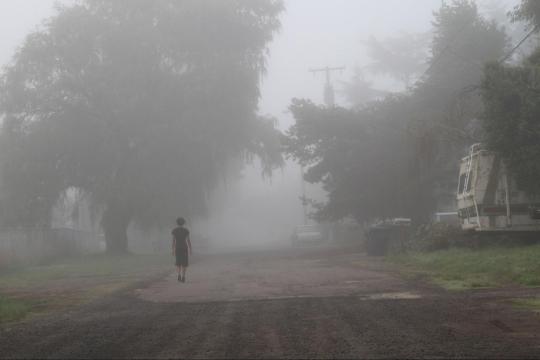
Janna Ireland, untitled from Night Season, 2010
MS: When you look at your bodies of work, do you ever wonder if a particular body of work feels somehow different “visually-speaking” than the previous one?
JI: Your bodies of work feel very distinctive. It feels like mine are messy, or just like, blend and lead into into one another. But with your bodies of work it feels like they are–what's the word I'm looking for? Well, I guess what I want to ask specifically about the Darshan work is how you feel it fits in with the rest of your work because it's so different, visually.
MS: Yeah, I mean it was very central. The stories of those deities, those deities themselves, were very central to my life and my upbringing. I can understand why the subject matter feels different, because Indian gods are a very specific thing. They are iconic in that they have a very strong personality. Like Ganesha, he's a half elephant, half man, traditionally depicted a certain way.
Whether I look at these deities, whose stories I was telling from a very specific lens, or I think of these swimmers from Surface Tension, or the shower work, or even when I was bringing the camera to point back at myself…I'm really thinking of a very crystallized portrait of this moment, or person or story. I see compositionally a lot of parallels in the way I think or create, but in the case of the deities I wanted to bring a certain sanctity to those stories. I wanted to render the work in these very specific colors. Once the first experiment was born, which was the goddess of wealth and fortune, Laxmi, it defined the rest.
For quite a long time I haven't made any more of the deities, but I will be creating a new one coming up in 2024, and that's going to be exciting.
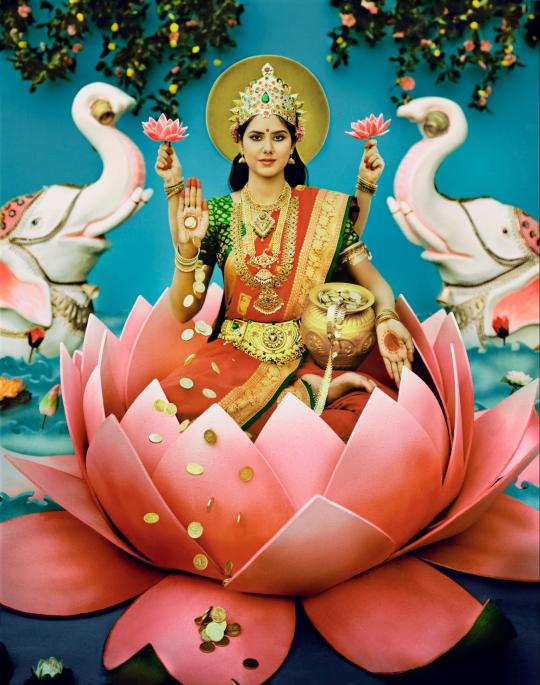
Manjari Sharma, Maa Laxmi, Darshan, 2011
JI: And I am so excited to hear about it!
MS: Yeah, I mean I'm not the same Manjari. So I wonder, what is this one going to look like? I’m starting to see it, and I already see it looking different than the other nine. So what I see in my mind that I have to still crystallize and put into sketch form, and then execute.
For the longest time I said no, I wanted to make these nine, and I made them, and maybe people wanted to see more, or maybe I wanted to see another one, but it wasn't time yet. But I have an institution that's interested in giving me the infrastructure to create the tenth one the way I envision it, and so that's going to be really exciting, and it's slated for 2024. So it's gonna be a minute–thank God–before it's born because it needs some pre-work.
JI: I love thinking about the process of you making those first nine. So it's really fun for me to know that I'll know you when you're making this one. I’ll be able to talk to you about it in real time, and hear what you're thinking. And hear, you know, “this is where I'm getting this costume," and so on. There's just so much that goes into each one. Each one is like a little individual film.
MS: Yeah, it definitely is, and it does have the ability to kind of overwhelm me. Do you feel this way? I mean, I'm curious about your process when you feel like you're completely engulfed by your idea. Do you find yourself in a place of peace, or when you're in production mode, so to speak, which I almost feel sounds like a bad word. But when you find yourself so fully swallowed is it peace or turbulence? Are you destroyed, or are you uplifted? Where are you?
JI: When I am deep into a project, that is when I feel more at peace than any other time. What I have to do is make sure I don't go too deep.
MS: I get that. I feel like it's like a kind of like playing until you arrive at a place where you're flowing. But until the point of peace you're willing to give it every living minute of your day and everything else can evaporate. I love this quote by John Baldessari and he says “You have to be possessed, which you can’t will.”
JI: It has to be genuine.
MS: Yeah, you can't just will it into being. And I think that the voice where you wonder where people would just love it if I made five hundred Darshans for the rest of my life, or the people who love the showers wonder why I’m not doing more. But I cannot stress this enough–because I've had this conversation with other people–if you've signed up for a career where the one thing you're supposed to do is march to the beat of your own drum, and you don't do that, what's the point?
I can tell people are trying to shape their voices based on the voices they hear outside, or they pay too much attention to the noise that's drowning out their own drive to create something unique. I always say, “guard that flame.” You've got that flame that's telling you to do something, and there's all kinds of wind all around you that's going to try to extinguish that. You have to stand by yourself at the cost of maybe losing some “followers,” because if your work has a personality, it's not going to please everybody. But if you're truly making art, and you're willing to claw, and you're willing to go to the next place that your heart wants to take you or your drive wants to take you, then you're a part of that adventure. You can leave the rest to the art historians to figure out.
You're kind of riding a roller coaster of evolution. When Darshan came out of me I was like well…this is not a shower. Darshan turned my life and my very existence upside down. I was pregnant when Darshan began, I birthed a child through it. I thought I was going to get back to doing more work in three months after the baby was born, but that didn't happen. Strangely, while I was still creating Darshan, I also started to create the work on my mom and dad.
JI: I'd love to hear you talk about that. That's something that I like doing, having two bodies of work that are really different going. I didn't realize that you were making those two things at the same time.
MS: People often think making art is neatly buttoned up with a bow on it but it’s not, certainly not for me. I find myself in the act, and then I find myself looking back and studying the act, and finding threads in between them. I probably wouldn't make Darhan if my mom didn't bring the passion she brought to her spirituality, so she’s very intricately tied into it. For her to completely disassemble while my child was coming into the world…I switched to making this very straightforward documentary work of my parents. It was all I could muster up at that moment, and I'm so thankful for it because it became like this shield.
People perhaps wonder how to slot you so they can understand your creative process. Maybe the math doesn't add up in someone else's calculations, but it all makes sense in some mystical way. Maybe that for someone else to find out after I die.
JI: That's something I've been thinking about a lot. I wrote my grandmother's obituary a few months ago. It felt so strange to be interpreting her life and picking out the highlights. I thought, “Should I write my own? Will that make it easier for the people I leave behind?” Or Is it better to not have control over the way people tell your story?
MS: Well, Janna Ireland, don't you go dying on me that’s number one. It’s not allowed. So that's that. And then the second thing is, tell me something you'd want to hear in your obituary. That's a really interesting conversation.
JI: Maybe something like, “she did her best.” What I struggle with, I think, is figuring out how I would balance writing about myself as a person who is a parent and a member of a family, and how to write about my work, because for me they're so intertwined. For the people I'd be leaving behind. I would want to make sure that they felt prioritized in that work, but that it was also true to how I was. I wouldn't want it to read like my CV, but my work is also so important to me that it would have to be a major part of what people talked about when they talked about me.
MS: Oh gosh, I'm having a very feminist response to what you're saying. But, of course your artwork is going to be central to that story and yes, you can be you, and be your art at the same time. I'm getting stronger and stronger about that ownership every day. There are certain things we grapple with, that is not even a question for men. And I don't want to say all of them, but it's not put upon them to make choices between their manhood and their work. But in our case, there's judgment on both sides. And we're both married to pretty modern men who work who equally step up, but still.
JI: At the end of the day, we're still “Mom.”
MS: Oh, absolutely. And maybe sometimes I worry that good men listening to this may not like the way that that sounds. But it's not about what a man imposes, it's also society and culture, and what we as women, from the get go, in subtle or not so subtle ways, are hardwired to take on. Whether it's caregiving for our parents, or the families that we make. Perhaps these conflicts keep us on our toes so we aren’t just drunk on art all the time. I have to say though, discussing or teaching or learning about art is something I can never tire of, ever.
JI: It’s so valuable to have friends who are doing the same thing. That’s what I have in you, as an artist who is around the same age, and also has two children and a ton of ambition and a ton of work that you want to do. Those relationships make it so much better for me.
MS: Absolutely. It was a a breath of relief to be introduced to you and I was, you know, really craving, being around creators who are passionate, and will never stop creating. I love that you have all those same conundrums as a mother of two children trying to navigate that line between how you keep yourself personally satisfied and creatively satisfied. It's hugely comforting that we are not alone. I’m not going to say I always succeed, sometimes I feel regret, like not being able to make my kids play, or not being able to act on a grant deadline.
JI: For me, it's, you know, I can't do the month-long residency. There’s this feeling like I want to be in two places at once, which we've also talked about.
MS: Yes, absolutely. But for all of those roles, the one that brings me the most satisfaction is when I feel like I artistically achieve that which I want to manifest. It has a very individual, independent sense of joy that's free of any other attachment. It's very self-sufficient.
There’s heart bursting joy to see your children do or say things and then you feel that swell, but there's a joint pride in that. You didn't do it alone. That village is definitely important in the shaping of your child. You need that community. You need your spouse if you can manage to have a partner that's cooperative, so it's a shared joy.
JI: But your work is, even when someone is helping you or you're collaborating, an individual pursuit.
MS: Yeah, and that has an unparalleled joy for me, and if I'm too departed from that for too long I will perform poorly in all other aspects. I'm like a bad person when I haven't paid attention to my art. In the last two months I was definitely, completely enmeshed with family, as you know and now I'm back and just starting to pay attention to all of these other aspects of my life. But I haven't seen you for a while, so I can't wait to go out with you and see art whenever that's going to happen next.
JI: We have to make a date.
MS: One question for you before we end this. You just took on a big role at Occidental. Tell me where that brings you as an artist, or how that makes you feel about your practice and trajectory.
JI: I just started a tenure track teaching job at Occidental, and I will be building up the photography curriculum and introducing a bunch of new photo classes in the Department of Art and Art History. I'm really trying to take everything that I've learned from my time as a student and my time teaching in other programs and figure out how to run a little photo program out of this larger department.
One of the reasons that I went to graduate school was that I knew I wanted to teach, and one of the big draws of UCLA was that it really prioritizes teaching for its MFA students. I began to think of teaching as part of my practice, and after I graduated, I imagined I would adjunct for a while. Instead we moved to New York, where I had this awful job running the photography team at a jewelry company, and I didn't start teaching until a few years later. By then, we were back in LA, and I was also working full time in an office at USC. I wanted to teach so badly that I was completely overburdening myself, working full time and commuting and caring for two children, and then teaching classes twice a week from 7-10:30 at night, which, when I think about it now, is ridiculous. That's no way to live.
For so long, I wanted a full-time teaching job, but those are so few and far between. I was at the point where I just thought it would never happen for me, so to not only have that now, but to have the opportunity to shape what the program looks like, and to also have resources at the school to make my own work, like studio space, and the ability to purchase equipment that will help me in my work. I’m kind of overwhelmed with not only having it, but how much more it is than I ever imagined for myself.
So that's kind of where I am–which is all over the place with it. Now the trick will be balancing it and making sure that I’m making enough of my own work to be fulfilled, and making sure that I am paying enough attention to my children and to what they need and really listening to them as they're becoming more and more their own people.
MS: Well, it's a divine problem to have, and I am so excited for you. It's such a great chapter to land on where you're able to solidify these different slots in your life that you have to strike a balance between. I know that that's hard. But a lot of people don't even get to that point where they have achieved so much in these different spaces and have to harmonize. So It’s such an exciting new chapter and I'm here for you on all counts.
JI: I'm here from you and I'm so excited about your classes at Art Center, and I can't wait to have conversations about the work that you want to do with your students.
MS: I'm really looking forward to that.

Janna Ireland is an assistant professor in the Department of Art and Art History at Occidental College. Her photographic work is primarily concerned with the themes of family, home, and the expression of Black identity in American culture. In 2016, she began photographing structures designed by legendary Black architect Paul R. Williams. A collection of 250 of these photographs was published in a monograph entitled Regarding Paul R. Williams: A Photographer's View, in 2020.
Ireland’s photographs are held in the permanent collections of institutions including LACMA, the Nevada Museum of Art, the California African American Museum, the Santa Barbara Museum of Art, and the Museum of Contemporary Photography at Columbia College Chicago. Her work has been the subject of articles in publications including The New York Times, the Los Angeles Times, Harvard Design Magazine, and Aperture.
www.jannaireland.com @jannaireland
Manjari Sharma is born and raised in Mumbai, India and now calls Los Angeles her home. Sharma is a visual artist and art educator that makes work addressing the issues of memory, family, identity, multiculturalism, and personal mythology. Manjari's project 'Darshan,' a photographic re-imagining of deities, garnered her wide critical acclaim and was published as a part of a limited edition book series with Nazaraeli Press in 2021. In 2017 the Metropolitan Museum of Art commissioned Manjari to create a collaborative series favorably reviewed in the New York Times by Art critic Roberta Smith and has traveled to the Louisiana Museum of Art in Denmark and Kunsthalle Mannheim in Germany. Her works have benn recognized by The New York Times, Vice Magazine, CNN, LA Times, The Huffington Post, and can be found in the permanent collections of the Metropolitan Museum of Art, Museum of Fine Arts, Houston, Carlos Museum, Emory University, and Birmingham Museum of Art amongst various private collections.
www.manjarisharma.com @manjee
0 notes
Text
26. Nuveen Barwari & Marlos E'van
Nuveen Barwari & Marlos E’van discuss their shared sense of immediacy and trust in the materials in their work, abstracting the figure, and the myriad influences that inform their art practices.

Nuveen Barwari (NB): Alright, where do we start? I guess I'll start by saying thanks for agreeing to do this with me. We have worked with each other for about five years on multiple projects and I think this is a great opportunity for us to really reflect on the common threads that both of our art practices share.
Marlos E’van (ME): I was really energized when you asked me to join you in this discussion, and I def want to thank you as well. It’s true, we have worked on multiple projects together and also personal work where we pass a piece back and forth over time, making a different move with each pass. Out of all the conversations we’ve had based on our work, this feels like the first time we’ve formally talked in public about the intersections our practices share both formally and conceptually!
NB: I think about the figures in your paintings, the way you handle paint, materials and multiplicity.… These are a few things that I would like to discuss with you in relation to my work…Maybe we can start off with this sense of “urgency” that I believe is present in both of our works. I want to say there is this sense of urgency in our work but our work is anything but that… I think the process actually involves a lot of research, conversations, and dwelling.. Maybe the execution feels quick… but the lead up to that initial mark making isn't quick at all.
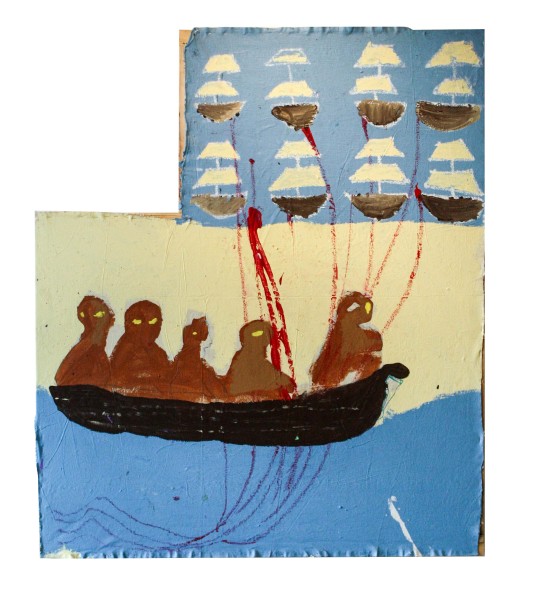
Marlos E’van, Next Great Migration, 2020, oil, latex, oil stick on canvas, 50.5 x 50.75 inches
ME: That’s a good place to start. It’s true that sometimes our work has this feeling of immediacy to it which some might call “fast paced”, however, I agree that we both take our time to really dig in and think about our subjects and work it out in our heads through conversations, sketches, and reading articles/books. Once that research is done, we’ve pretty much worked out the piece in our head and go all in on the attempt which usually results in that fast pace. It feels like this urgency we share is reflective of the urgency involved in our subject matter.
NB: Yes, I agree with all of the above… also at the same time I feel like we are such “Makers'' with a capital M that even if we don't have a plan we are still making and trusting the process… that sounds cliche but its true sometimes i'll be in the studio surrounded by all of my materials and i have so much conviction in all of these materials that i have collected over the years that i know that regardless of a “plan”. Hmm how do I put this.. For example I can close my eyes and just pick out random materials in the studio and sew them together and trust that it will all come together later… I have definitely connected this sense of “urgency” in the past to protest and the subject matter so I'm glad you brought that up… I have also connected it with my use of the sewing machine and screen printing you know?
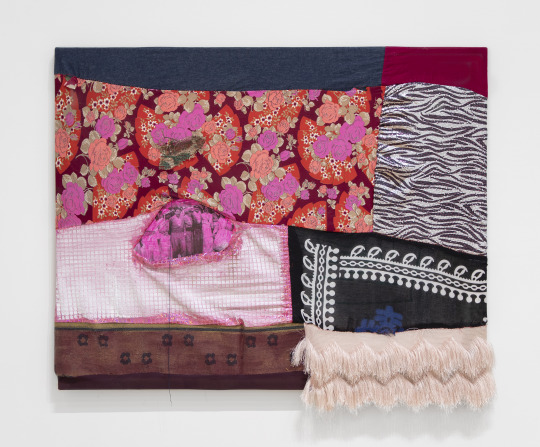
Nuveen Barwari, Landscape, denim, found fabric, deconstructed Kurdish dress, acrylic paint, fabric paint, thread, canvas, xerox paper, 32 x 40 inches, 2022
ME: Wow I like the way you put that! I think it’s important for people to know that there are situations where we take our time and research, sketch, etc, yet there are other times where we go with our instincts and go in without a “plan”. Moments like that allow us room to explore and let a piece guide us to its final composition. I feel like we both achieve this sort of “freestyle” by taking into account the materials, the natural and un-natural movements in the materials, and daily mark making on the piece. Sometimes in my work I just sit and stare at a canvas, noticing the shadows and marks that already exist. These observations help guide me into what moves I wanna make next. Kinda like playing chess.
NB: So I also see a connection between the way you abstract figures in your paintings and the way I abstract figures in my paintings. I think the way we both handle paint is very similar and some would even say is not very “traditional” for example some of my favorite moments in your work is when I see the paint on the raw canvas.
ME: You know, when it comes down to making figures, I never wanted to paint something exactly how you see it in life, that's boring for me. Therefore, I chose to make figures that allow us to make abstracted discoveries in the work. Moving body parts out of place and using my line work brings an element of fun to the creations which I feel your work does also. Speaking of paintings and abstract figures, I noticed that some people label your work as textile based paintings. However, both you and I refer to them as Paintings. You just showed me a new piece in your studio and it def reads as a huge painting although there’s no “paint” applied, yet you move around the material like a painter would. What are your thoughts on this and how do you actually see your work as far as being textile or paintings?
NB: I often tell people I am not a poet, I only hang out with them. I do call myself a painter though and almost everything I make is a painting. You see, I come from an academic painting background, everything I've learned from painting I've applied it to everything else I do in the studio whether that be installations, textiles,video work, performance, and even fashion.
To look at painting beyond the medium itself, to paint without paint is something I think about on a daily basis. I think it's really interesting how many associate the rectangle to painting while I associate it to rugs. And then I take the rug and connect it to a door which in the past has been literally utilized as a door and then I circle back and connect it to painting and it goes on and on. It involves a lot of contradictions that aren't always bad. I'm not gonna lie tho sometimes do insert my work into the painting realm very abruptly.
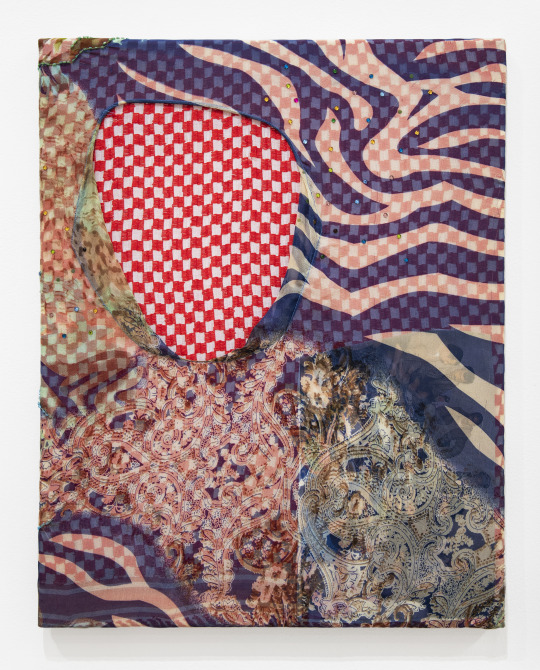
Nuveen Barwari, Cooking for the peshmergas, thread, deconstructed Kurdish dress, Xerox paper, 16 x 20 inches, 2022
ME: That's really interesting! I love that line where you say “to paint without paint”. In my own practice, I see myself as a sculptor or a filmmaker sometimes even if I'm making a painting. I also see myself as a musician at the same time; making these compositions that move in time like a musical arrangement. Sometimes the music goes from Jazz, Punk, Rap, and Goth, etc. However, I don't feel beholden to categorize anything I do as just one thing. I feel like that is another similarity we share.
NB: Yes I agree with you… both of our works involve multiplicity. I like that you mentioned music because that is definitely something I think about in the studio. Like I will listen to alot of Kurdish music and sometimes even pretend that I am making album covers for some of the greats or that I am hanging out with them in the studio… I also think about translation alot and connect that to multiplicity …I have always been mesmerized with the many ways Kurdish poets and musicians have employed language as a tool for resistance. The term “Gulistan” is a common motif in a lot of Kurdish songs and poetry. The flower of a rose is known as a "gul." All flowers are referred to as "gul" in conversation, however the correct word in Kurdish is "kulik." the complexities of using floral themes and metaphors to both reveal and conceal their ethnic identity. I'm really interested in the shapes and sounds that are found through translation rather than focusing on the stuff that is lost, you know? But I would love to talk to you more about the sculptural element in painting, since so many painters I know absolutely dread stretching their own canvases… and to me that is the best part.
ME: I feel you on that!
When it comes to the sculptural elements, I can remember one of my mentors, Terry Thacker, always talking about the act of pushing paint around on the surface. Before art school, I grew up on a farm and helped one of my uncles do home improvement jobs for people in our community back in Mississippi. We would always have to invent tools and improvise with materials. This almost always came in the form of a sculpture in some way. This carried over into my art making from how I use paint and materials, and how I build stretcher bars. I try to break from the traditional rectangle forms, something I'm aware that you do as well; and create alternative structures that challenge how we present and observe a work of art. This goes back to the note changes in music, while also incorporating a sculpture that holds a painting in place.
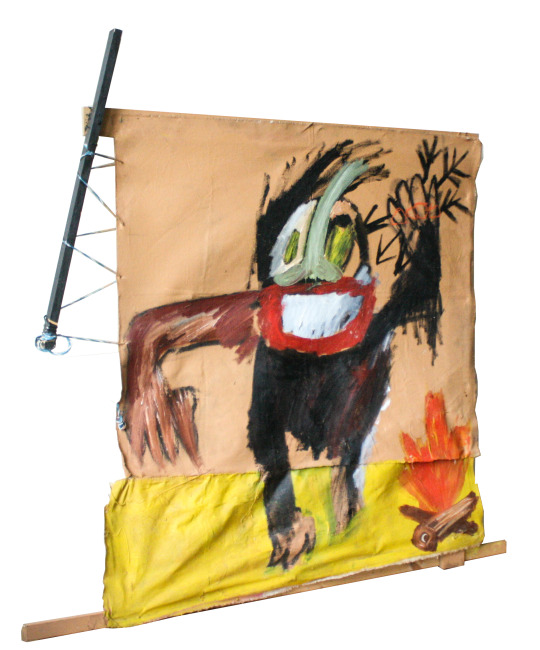
Marlos E’van, Fire and Spears, 2020, rope, oil, latex and oil sticks on canvas, found wood frame, 54 x 43.5 inches
NB: Ok cool. Oh wow yeah i like that… “the act of pushing paint” that even becomes performative as well. I'm glad you mentioned how growing up on the farm has informed alot of your art making because it has me thinking of growing up in Duhok, Kurdistan and being in awe of the colorful bazaars, fabric stores, and the landscapes. For instance, being part of a diasporic community entails this transcontinental exchange of materials from the homeland (home country) and host land (host country). Being a member of diaspora necessitates this almost constant exchange of materials from the homeland and the host land. This exchange consists of family from the homeland sending anything from photographs with written messages and dates on the back to honey, spices, and beautiful fabrics or the family in the host land sending photographs, clothes, medication, and in my case bags of hot Cheetos to the homeland. I've always been fascinated by the little things, like how much space would be added to the suitcase when a needle is used to poke tiny holes in hot Cheeto bags when traveling back home. I grew up watching elders in diaspora transplanting fig trees and rose bushes from the homeland into this new soil, making Kurdish dresses out of the fabrics that were available to them in the host land, and most importantly I witnessed the longing, the act of making a home away from home and the grief that comes with it.
ME: Wowow, I think this is a really important/intimate view into your artmaking and thought process. Very beautifully said! I know we can talk longer but folks will have to wait on our memoirs for more. Until then they can stay tuned in to what we’re making.
NB: Haha yeah i think this is a good stopping point. Thanks for the conversation.
ME: No prob and thank you! Now I'm about to go find something to eat! Talk 2 U Later!!

Nuveen Barwari was born in Nashville, TN (1995). Barwari received a Bachelor of Science in Studio Art from Tennessee State University in 2019 and a Master’s in Fine Arts from the University of Tennessee, Knoxville in 2022. Employing collage, painting, textiles, and installation, Barwari studies the intricacies within conditions of assimilation, material culture, and contradictions within diasporic identities. Barwari’s work has been featured in national and international publications including the Nashville Scene, New American Painting, Yahoo Nachrichten Deutschland, Gazete Duvar, and Botan Times. She has exhibited in numerous locations such as, Sugar Gallery (2019) in Fayetteville, Arkansas, Zg Gallery (2020) in Chicago, NGBK Gallery in Berlin Germany (2021), Duhok Gallery (2021) in Duhok, Kurdistan, and Ortega y Gasset Projects, in Brooklyn, NY (2022). Barwari is represented by The Red Arrow Gallery in Nashville, TN and is currently working and living in Albany, NY.
nuveenbarwari.com @nuveenbarwari
Marlos E'van (b. 1988 Tupelo, MS) Nashville-based artist, E'van interweaves different mediums such as painting, performance, and filmmaking to create worlds in which their art recollects black histories: joy, pain, celebration, sorrow, and complex emotions from reenacted scenes of American histories. A subtle vernacular in expression has caught recognition from such publications such as Hyperallergic and New Art Examiner. In addition to their work as an artist, E'van co-founded/co-designs M-SPAR, McGruder Social Practice Artist Residency out of the McGruder Center in North Nashville. Working as an educator in a hard-hit redlined Nashville neighborhood, E'van actively listens to their pupils, gathering stories that also inform E'van's paintings. Their own life creates first-person narratives in paintings targeting marginalization, stemming from a queer black history rooted in their home state of Mississippi. Marlos E'van's work is included in International collections, has been shown in VA, TN, GA, MS and NY.
@marlosevan
0 notes
Text
25. Shaunté Gates, Leah Lewis, & Katherine Tzu-Lan Mann
Shaunté Gates, Leah Lewis, and Katherine Tzu-Lan Mann speak with each other about personal and communal mythologies, games and labyrinths, and breaking down elements in order to create new worlds.

Katherine Tzu-Lan Mann (KM): Our work has a lot of commonalities, we all work in the same physical space and there are a lot of ideas that bounce around this studio that we each deal with in very different ways. The first idea that I wanted to ask you both about is mythology. Te, you create these portholes into fantastical worlds, you’re a myth maker, and the spaces you make feel broad and sweeping. And Leah, it seems like you are also making a mythology, building your own world even though that world feels much more claustrophobic. I’m also trying to work with an alternate universe, a place to feel at home or a place to feel comfort or belonging, and I thought we could talk about that concept.
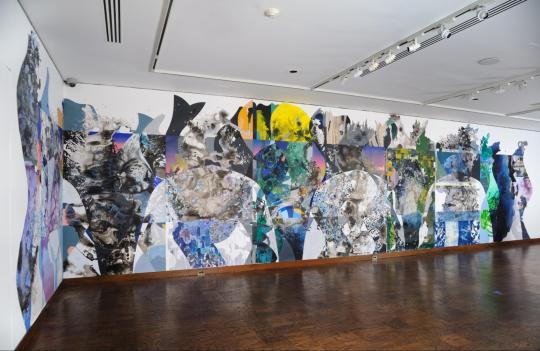
Katherine Tzu-Lan Mann, Salamander Room, 2020, Acrylic, sumi ink, collage on cut paper, 15 x 60 x 10 ft
Shaunté Gates (SG): That’s a great common thing that we have, whether it’s intentional or not, it’s in there. For me, it’s about finding and taking, like finding a clip from a piece of cinema. One of the movies I watched growing up was the Ten Commandments. I was watching these white cats playing as Egyptians, but I loved the movie. How do you break down and come through some of those things that have shaped your perception of the world?
Leah Lewis (LL): The opening scene of that movie had such an impact on your work. Just the perspective.
KM: Can you describe that opening scene?
LL: Rumbling clouds, this vast sky and this extreme dynamic perspective. I can’t remember if it’s the opening scene but it’s a scene in there.
SG: It had an impact on my life aesthetically and conceptually. It’s almost like Santa Claus in a sense, it’s not real but at the same time it’s a part of my life and how I was brought up. Thinking of that mixed with the environments I grew up in as a kid, for instance the war on drugs, and these myths that came from residential segregation… I’m taking different pieces of myths, and when they come back together, what new story can there be, what’s the story that we don’t know? All myths are based off of something real. I’m trying to find that thing, that unconscious truth. A lot of times when I make the work, I’m not even exactly sure what it is, I don’t need to know. If I know too much of what it is, I’ll fuck it up. I’ll alter it to make it so I don’t understand it. Just trying to find something that I don’t know.
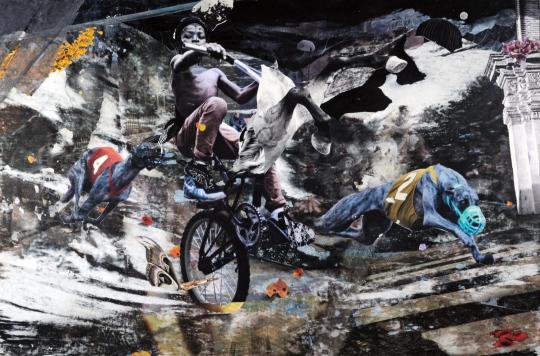
Shaunté Gates, Land of Myth II, 2021, Acrylic, photo, pulled paper, collage on wood panel, 48 × 72 in
KM: I love that idea of scouring the world that we live in for the myths that are woven into the fabric of our lives, drawing them out and resetting them together to make a whole new language.
SG: What’s crazy is when I start putting those pieces together I take them to sleep with me. Literally, I’ll put them into my head, start thinking about them and moving pieces around. Sometimes I don’t sleep well because I’m constantly moving shit. But that’s what it is, a conscious exchange with the subconscious, where I’m like, OK I’ll put this there, and then pull it out, so that when I come to the studio today, I can’t remember exactly what it was that I dreamt about these pieces, but they’re there.
KM: Leah, do you feel like you’re doing that too? You’re pulling from your life and you’re resetting elements into alien places?
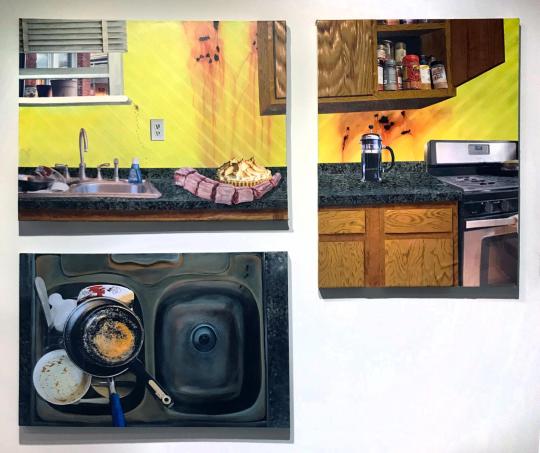
Leah Lewis, A Cautionary Tale, 2019; acrylic, oil, photo collage on canvas
LL: Yes, it was something I started doing the last time I went to art school, when I was trying to understand the idea of sculpture because I had never done three dimensional work. I started with a title, and I made a sentence, and I tried to literally translate that sentence, like code, with objects. That’s still what I’m trying to do. It’s the whole idea of still life—I don’t want to use figures—I just want to use objects. If figures are in there it’s because they’re on a label or on a picture. It’s like a rebus puzzle. It’s deeply personal for now, but at the same time I think anyone could pull something out of it. It’s got a psychoanalytic element to it. For example, the kitchen piece, that comes from some shit that happened where we lived, and the way I was feeling at the time.
KM: And you’re taking that experience and coding it.
LL: Yes, I’m taking objects and using them as a code. So it’s a story, or maybe you’ll just feel the vibe. I’m making myths with things.
KM: The vibe is a really anxiety inducing one.
LL: It is. Huge anxiety.
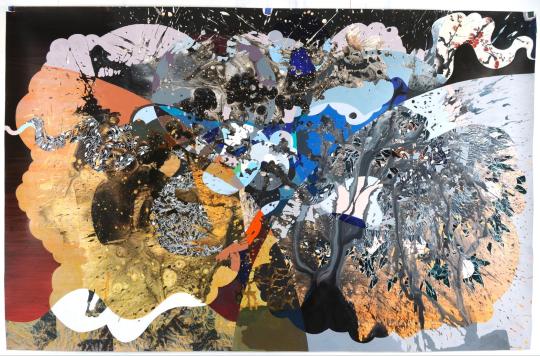
Katherine Tzu-Lan Mann, Fog, 2021, Acrylic, sumi ink and collage on paper, 60 x 80 in
KM: You both have a real interest in texture and incongruity, cobbling things together that don’t belong. Te, you’re literally smashing animals together. Leah, you’re placing objects that are so out of place and therefore are grotesque in their new contexts. You’re both interested in hybrids.
LL: We both do similar things. And this is how we’ve been since we met. And that’s the cool thing, that’s why we gel.
SG: And we’ve been hanging out ever since. We’ve got a kid, that’s who we are.
LL: We’re inspired by the same things, we have a spawn. A hybrid of ourselves. We could always have a conversation, take that conversation and put it in our work, but we both would do it in fiercely different ways. Part of is that our neuroses reflect so differently. He’s like a cyclone; even his studio environment is a cyclone, but he would never let a cup grow mold in it. While I would let that cup sit there and grow mold and take pictures of it so I could use it in my work. I have great moldy photos I used to take.
KM: That love of incongruity seems to manifest in an interest in mazes for each of us. I’m creating spaces that have a sense of passage but also a sense of entrapment, and I feel like both of you have that too. Leah, in your work it feels like you’re trapped, everything you do is really cropped and tight. And Te, your work is more expansive and explosive but it also feels like a labyrinth.
SG: I call them labyrinths of social constructs. Psychologically and physically. The actual structures, buildings and architecture in the work house and perpetuate the constructs. How do you find your way through a labyrinth of psychological and spiritual warfare.
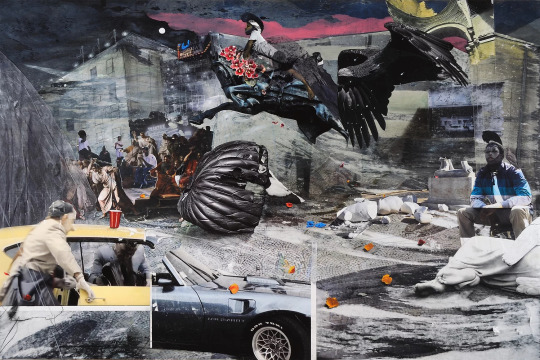
Shaunté Gates, The Great Escape Sometimes, 2021, Acrylic, photo, pulled paper, collage, charcoal on wood panel, 48 × 72 in
KM: But at the same time, your work also has a sense of pleasure, escapism and playfulness.
LL: You got flowers blowing like Disney flowers.
KM: And both of you also have humor in your work.
SG: I’ve always had a little slice of humor, even with shit that seems really serious. I had one joint where there were statues, and a chariot driver, steering horses that are stone. In a sense, I’m saying, take control of your own destiny, make them move, but it’s still a fucking statue. There’s a sense of social immobility.
KM: That’s interesting because you do so much transportation! You’re making mazes that you can’t escape, and then you’re placing galloping horses with their manes flowing, motorcycles and cars. So there’s a sense of breaking through, but to where, and is it even possible?
SG: There’s always a person that I know in the pieces. They could be anywhere in the works. The narrative is escape, but some of the characters are going towards the center of the labyrinth. The labyrinth is the self. Think about all of the stories that have been taught to us about who we are and what we are—how do you come out of them? So that’s how I think about these characters. Some of them have gone to the center of the maze, like the woman who has transformed into an owl, she’s seen it, so she’s on her way out, but some of the other people might be trying to find their way in.
KM: Leah, do you feel like it’s too much of a stretch to think about your work in terms of a maze? What you’re describing, the sense of attempt at escape, but also embrace, that seems like that’s happening in your work as well—attempts at passage but instead of a clear linear narrative you’re entrapping us in layered domestic picture planes.
LL: A house, rooms, that’s a maze.
SG: It reminds me of that, especially your kitchen painting, because it depicts a house that I lived in for 20 years. Batteries in the drawers, playing cards, ketchup packets, random things that remind me of when I was 12.
KM: And you’re inserting these really grotesque elements into that environment.
LL: This was another thing that started at my last attempt at art school, finding the beauty in corrosion. We as a society think we can control this earth, but at the end of the day we have no control. I made these pieces from tile in a bathroom in my old apartment, they’re cracked, they’re getting mildew and mold in the cracks. Little tiny microscopic organisms are going to destroy this tile. There are all these things that are breaking down the building that I lived in and no matter how much everybody tries, at the end of the day it’s going to get swallowed up by the earth and destroyed.
KM: What you’re describing feels to me like a battleground, or a ballet perhaps, between control and chaos.
LL: Not a ballet, I like to think of it as rebellion. The fight against the idea of order.
KM: We’re all dealing with the fight against order, I like that a lot.
LL: Even though we’re neurotic.
KM: Right, like a game, playing with the concept of control but constantly going back and forth.
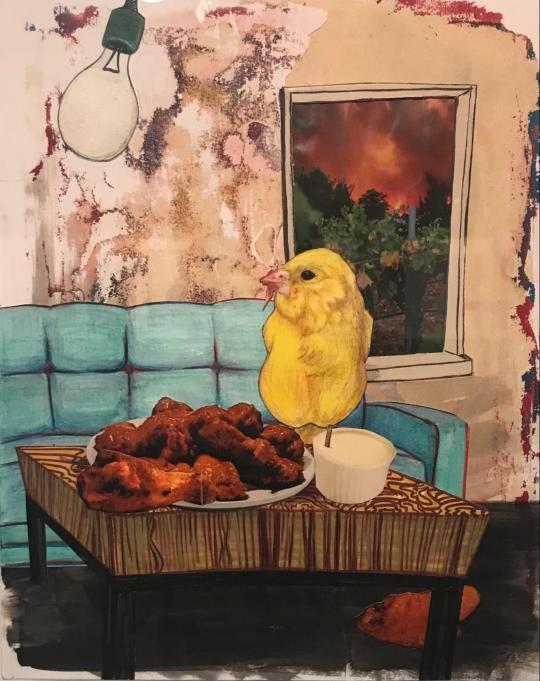
Leah Lewis, Bless your Heart, 2022; acrylic, colored pencil, marker, photo collage on Bristol paper
SG: Then you think about the game. I use architectural columns in my work that suggest power structures, but I make them out of playing cards. The games you play in controlling people, I’m thinking about that. There’s levels to it. And, how do you lose enough control, because as artists we need to.
KM: And we’re all in the business of building worlds which is this ridiculous god-like stance.
SG: Like who the fuck do you think you are? But it’s world breaking and building. Breaking down one world and building another. So it’s not creating your own world out of thin air. It’s breaking with something that’s there, rebellion, pushing it down and taking the pieces.
LL: That’s why I use flies and maggots in my work, celebrating the idea of the process of death and the process of breaking down.
SG: There you go.

Shaunté Gates is based in Washington, D.C., where he was born and raised. Gates works across mixed media collage and video subvert landscapes with architecture embedded with cultural symbologies and caste categorizations. He produces dreamscape-like compositions rife with cinematic moments of beauty, chaos and glory depicting the labyrinth of social constructs we are all wading through. The works may be most succinctly described as psychogeography, an intersection of psychology and geography. They focus our psychological experiences of the city and reveal forgotten, discarded, or marginalized aspects of the urban environment.
He is a participating artist in Smithsonian Institution’s “Men of Change” four-year (2019-2022) traveling exhibition, spanning ten museums including California African American Museum, Cincinnati Underground Railroad Museum, and Washington State History Museum.
His work has been acquired by the Studio Museum in Harlem’s Collection, the Howard University School of Law, and public schools throughout Washington, DC.
shauntegates.com @studio.gates
Leah Lewis is an artist and mother from Beaver Falls, Pennsylvania who is currently based in Washington, DC. She is a past participant of The Artist’s Mother’s studio at the Washington Project for the Arts and has been commissioned for public art projects through DC’s Department of General Services. She is a current resident of Stable Arts.
@leahleww
Katherine Tzu-Lan Mann examines landscape painting, environment, mythology and cultural estrangement by building luxuriant, cinematically scaled paper paintings and installations. She is the recipient of the Sustainable Arts Foundation grant, a Fulbright grant, the AIR Gallery and Lower East Side Printshop Keyholder Fellowships, and the Mayor’s Award and Hamiltonian Fellowship in Washington, DC. Some of the venues where Mann has shown her work include the Kreeger Museum, Tides Museum, Academy Art Museum, Walters Art Museum, American University Museum, Corcoran Gallery of Art, Rawls Museum, the US consulate in Dubai, UAE, and the US embassy in Yaounde, Cameroon.
www.katherinemann.net @ktzulan
0 notes
Text
21. Meena Hasan & Sharmistha Ray
Sharmistha Ray and Meena Hasan meet one-on-one for the first time on a July summer morning for a Zoom studio visit and exchange about painting, abstraction and how their shared Bengali heritage across borders informs their work, particularly as it relates to language and textiles.

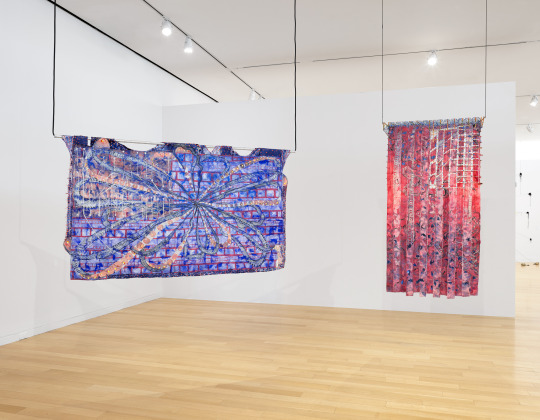
Meena Hasan, Installation View, New England Triennial, deCordova Museum and Sculpture Park, Lincoln MA, April-September 2022
Sharmistha Ray (SR): I’ve seen some images of your work and read a little bit about it; but I would love to use this opportunity to have a mini studio visit with you. First of all, I’d love to know why you thought of me in terms of a connection…
Meena Hasan (MH): I think my work is shaped by an innate desire to share a specific immersive experience that abstraction can offer, and I have been trying to do this through methods of figuration and depiction; I love playing within that tension between the unnameable and the nameable, puzzling through recognition and legibility. I want to see if I can offer an experience beyond language through language. For example, I’ve been making first-person perspective point-of-view paintings since 2013, in order to complicate the role of the subject, the artist and the viewer, to compress those positions and meddle in the painting’s social function and power dynamics. I think of abstraction as a space where the viewer is inside the subject, rather than one that asks the viewer to read an experience outside of themselves, through the surrogacy of an illustrated subject. Abstraction asks you to step right into the subject, to see and feel through the artist, placing you inside the mind of the painting, the painting becomes the figure. When I was considering an artist to interview, I wanted to talk to someone, and hopefully more specifically a Bengali artist working in America, for whom abstraction is central as a language and mode of expression, so I was so absolutely thrilled when you accepted my invitation.
Let me pull up some images of my recent works and process shots to help – these are of two pieces I currently have up in the New England Triennial at the deCordova Museum in Lincoln MA. These large paper pieces start as meditative drawings, without an idea of how they will end up. With this (Guan Chauper, Join or Die, 2021), I wanted to make work that directly addresses New England, given that I’ve been teaching there for the last 3 years and it’s been a really intense cultural exchange for me. I was looking at snakes and ladders board games and Ben Franklin’s political cartoon calling for the unity of the 13 American colonies against the British, it is of this broken snake form. This piece is one of the most political works I have made in some time. These works started with me just drawing snakes, volumistic lines that curl and coil. I drew a ton of snakes over Covid, the snake is a form that has been dwelling comfortably and consistently in my subconscious for quite some time now...
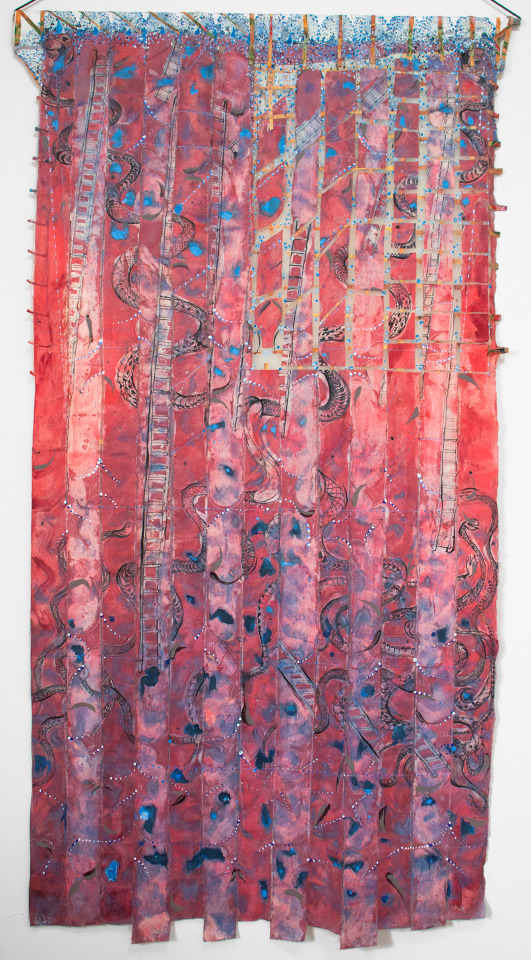
Meena Hasan, Join or Die, Gyuan Chauper, acrylic and Flashe on paper. 93 x 49 inches, 2022
SR: Is this the verso of the piece?
MH: Yes, this is the verso
SR: That’s beautiful. It kind of reminds me of a deconstructed flag, you know?
MH: Yes exactly, these two pieces follow the exact dimensions of the flag, 3:5. This one is made in 13 strips that are cut out and held together with clear acrylic medium used like skin collagen. I’m about to move back into my old studio in Greenpoint and will have the time to play with these large-scale paper works again, and especially to play with their installation which is hard to do in my current home studio. The thing I love about these, is how they hang in the room…
SR: I love the spatial relationships they create…
MH: Yes! I want to offer a phenomenological kind of experience when walking around these paintings. When seen from the side, they disappear, you can’t see them, they become as thin and invisible as a sheet of paper and then, they expand and reveal themselves as you continue to move around them, they become immersive spaces and narrative compositions in motion. They are really very social, they flirt with you, they’ll perform and show off but they are also shy and autonomous. The backs, I like to think of the backs like the guts of them, their insides, how they are made, what makes their blood pump and nerves react, some of their internal secrets revealed.
SR: It’s interesting to see how this elemental form of figuration morphs into an abstract form. I think it’s pretty fascinating when that happens. The figuration forms a ghost layer in a way. It’s present, but also hidden which creates a sense of mystery; kind of like a secret that’s held within the layers of the work. Tell me about the one on the left, those look like painted strips…
MH: Yes, they are on Japanese Kozo papers, and are like fabric in a lot of ways, very strong and durable. There’s a lot of displacement, dislocation and relocation of form in these, that’s healed and sutured in a way with acrylic medium – they’re very skin-like. They start with bamboo pen ink drawing, like a stick and poke tattoo, scratched into the layers of paper, the way ink can sit under layers of skin for a lifetime. After that initial drawing, they go through many phases of acrylic application and dying. I studied Batik when I studied abroad, so I use acrylic somewhat like how wax is used in Batik…
SR: I am really responding to the rawness they communicate through their surfaces. I am into that kind of viscerality when approaching painting. I also love that style of (Indian) painting…
MH: It’s maybe even more akin to Kalamkari dying and painting – although not nearly as exquisitely laborious.
SR: Yeah, I see that.
MH: I welcome chaos in my process, the surfaces hold a lot of time and evolution within them, they are meditative spaces. I try to use material in a way that honors the material’s qualities themselves, its viscosity, sheen, resistance etc, rather than controlling material purely as a means towards an end. The work is self aware in this way, of its own making, it declares its construction. I set up a system, a criteria of catalyzing activity that usually has to do with a photographic reference and I spend time looking and waiting before making a move. For every successful painting there are at least 3 that don’t work, that end up becoming collaged parts of other works years down the line. They are like bodies in the way their surfaces hold history and lived affect like skin, and they are also like a pattern or design that gets produced, sold and worn across economies and continents and decades. To me, textiles, pattern and decoration are part of my cellular structure, part of being a person, and especially a South Asian American person in the world as an aesthetic being, that my subjectivity constitutes complex dynamics between personhood and objecthood. Anne Cheng in her book Ornamentalism talks about a fusion between a synthetic objecthood and organic personhood that resonates with me. For these reasons, I love to use paint in ways that parallel textile methods and traditions like Kalamkari, Jamdani weaving, Kantha stitching and, probably most consistently, Batik.
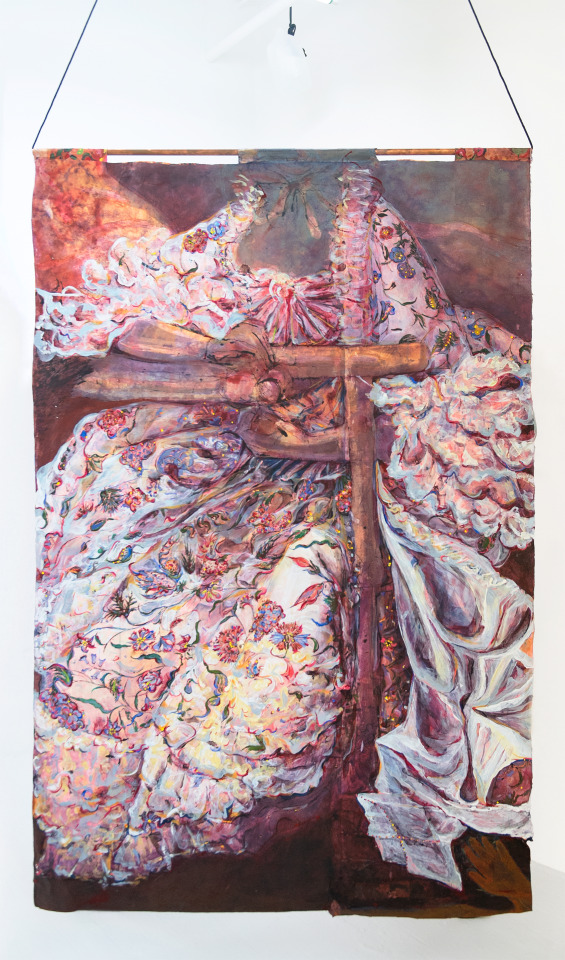
Meena Hasan, The Empress (from Drouais’ Madame de Pompadour at her Tambour Frame, 1764), acrylic and Flashe on paper. 76 x 47 1/2 inches, 2021
SR: What is your own relationship to that particular style of batik painting?
MH: I studied Batik in college when I studied abroad in Florence, I made many silk paintings and fell in love with the process as a way of thinking through constructing an image - the way images are imbedded into a surface and become structural, the physicality and objecthood of Batik as both image and object really resonated with me, I love the way wax sits, cracks and holds pigment and try to make my acrylic do the same. Batik also helped me access textiles as central to my practice, as my first visual language, my visual DNA and first artistic genealogy as grounded in pattern and decoration. My mom’s always been interested in textiles…
SR: My mother was a fashion designer. She has the best collection of sarees. I grew up around textiles too. There’s this one Jamini Roy saree she has which I love and am secretly coveting. I’m more likely to frame it than wear it though!
MH: Amazing. Do you feel that influenced your work at all?
SR: Oh well yeah, it definitely did! But I don’t want to interrupt you…
MH: Well, please, this is a conversation! I am supposed to be interviewing you…
SR: (laughter) Well, I see it as a conversation. I mean that’s always more interesting right? A mutual inquiry shall we say?
MH: (laughter) Yes okay…
SR: My mother’s work absolutely did influence me. I was born in Calcutta* and we went back every other summer from Kuwait, where I grew up. Patterned textiles are a way of life in Indian homes. Most of my family is pretty ‘middle-class’ and the aesthetics in most of these homes are pretty chaotic. Color and patterns are everywhere: things just clash and blend. The idea of selecting and curating a space doesn’t exist. That kind of maximalism resides within me. I don’t really understand negative space. I mean, theoretically I do, but in practice, I want to fill it all up. When I lived in India a few years ago, I visited some of the leading textile collections, like the Calico Museum in Ahmedabad which was founded by the Sarabhais. There’s also the Tapi Collection in Surat, which I didn’t have an opportunity to visit but I saw museum exhibitions in Mumbai, where I lived. I also engaged with some pretty amazing textile arts in Jaisalmer in Rajasthan, where incidentally, most abstract Tantra work comes from. I love the collective nature of the way these women work. They’re cooking, cleaning, nursing their young, they do everything. And then they make these large tapestries. And one woman will come, or two and three, it’s their social time, they’re just talking and working. They create these collaborative pieces that are just incredible. It’s a melding of the unconscious. It makes you wonder why we need so many cognitive structures (laughter)! I’ve seen this way of working in South East Asia as well. Communities work together. It was probably the same in some African American quilting traditions, but I am not completely sure…
MH: Like Alabama’s Gee’s Bend quilting tradition maybe, yes…
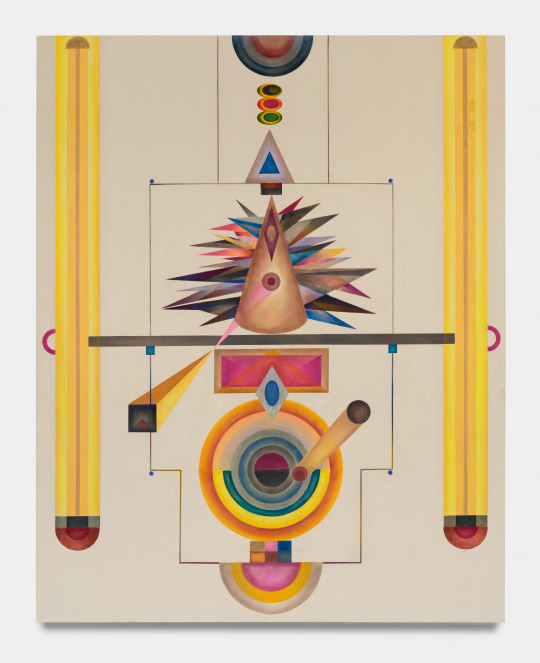
Hilma’s Ghost (Sharmistha Ray + Dannielle Tegeder), Automatic Theorem Painting #1, 60 x 48 inches. Oil stained on cotton velveteen mounted on wood panel, 2022
SR: It’s really the patterning, the repetition, the color schemas, the symmetry, those things that have come into my work from textiles. It’s interesting, with [my collective] Hilma’s Ghost, you see the influence of the Bauhaus and Constructivism in our collaborative work that comes through my collaborator, Dannielle [Tegeder] and there’s this interesting friction with my esthetics, which are mostly South Asian. You see it physically in the work through the differences in composition, color, structures. I’m also interested in these cultural fusions in abstraction. It’s also historical. Do you know that Kala Bhavan, the famous art school in Santiniketan, West Bengal, was founded by Rabindranath Tagore in the same year as the Bauhaus, in 1919? I always find that parallel fascinating…
MH: Wow wild!
SR: Yes! It’s just wild – for so long the ‘west’ wrote this story about Modern art in which the ‘east’ made derivative work. The truth is it was more of an exchange.
MH: In terms of your distinctly South Asian aesthetics, when I think of your works, I think that there is something very powerful built into the way you approach process that feels urgent, intuitive and meditative, that maybe comes out of your study of tantric art practices. Do you feel like you’ve been practicing this kind of process-based making? That one might even call divinatory? I’m also curious about the kinds of parallel practices you might be engaging in, if there are processes you engage with that go beyond creating an art object in and of itself, but become methods for self exploration, expression, attention and maybe care? I just started taking Bengali lessons, I’ve been looking for a Bangla tutor for years, and I finally found an incredible teacher who Skypes with me twice a week from Dhaka, and these lessons feel crucial, as a parallel practice that I am absolutely committed to. I’m feeling so fed and nourished by studying Bangla, I am absolutely in love with the language and giddy like I’m crushing all the time now. And I’m taking some ownership over the shame I have about how much I’ve forgotten, it’s really powerful to take a few hours each week to play with Bangla and build it into my psyche again, into the rhythm of my inner monologue, it feels so fundamental to who I am.
SR: Bengali script is so visual. It’s so beautiful.
MH: So beautiful. I learned Bengali as a kid, and not entirely from my parents. Because of my school in New York and the fact that I had issues with my speech as a child, my parents kind of stopped speaking Bangla with me at home. So the Bangla that I did speak was learned from different kinds of people outside of my immediate family, class and region. My grammar, pronunciation and word choice in terms of dialects are all over the place and it's been really fun to have someone who will sit with me and go through all the different ways I say a thing, and why I might have learned to say something in a specific way and what the different contexts for different kinds of cadence might be. Before, it was just a jumbled mess in my head and I would just hope for the best. And now I know I’ve been very rude and inappropriate in my grammar or tone, very often, and those were moments that I picked up on socially without really understanding why someone was reacting, even just with their bodies, in the way they might have been reacting. And in terms of making visual art and thinking about what an art practice can offer, this idea of translation is so central, I think, to sharing experiences and meeting people and audiences beyond my own experience and thinking about all the different levels of dialogue that one can engage with in a painting, that is a major aspect of painting that makes the medium so important to me; it can be such a generous mode of communication. I’ve always studied a language other than English, and that's been a very important parallel practice.
SR: Yeah, Bengali, it’s interesting because it’s the first language that I learned. I once had a German language teacher who said “if you don't use it, you lose it.” I grew up in Kuwait, but my parents did actually make an effort to speak Bengali around us and we would go to India every other summer where I only spoke in Bengali with my relatives –so I was pretty fluent and comfortable with it. But coming to America and being so far away from the spoken language, I started forgetting. But the moment I was back in Calcutta, it all came back to me so quickly and before I knew it I was speaking fairly fluently. It’s like all these words and expressions just live dormant in your brain waiting to be activated!
MH: I’m so jealous of that fluency! I hope I get there someday! But apologies, because I seem to have hijacked my own question about your parallel practices by talking about my Bengali lessons. I’m curious about your relationship to ritual, to an idea of “practice”, to repetition in action in other words. For me it has a lot to do with the spaces I am in. I’m very much a studio junkie, forgive the phrase, I go through withdrawal if I take a week off or something. I like being in my studio. It has become more and more true, probably a product of Covid. I’m really jealous of people who can fold up their surfaces and work anywhere and everywhere. I hope to manage to figure out how to do that someday for myself. But right now I’ve become very into nesting: maintaining my spaces, cooking, meditation, physical practices like running and yoga.
SR: I used to be someone who depended on having a daily studio practice, but I have a more flexible relationship with that now. I have a home studio for my own work and, until recently, had a joint studio with Hilma’s Ghost. Both the collective and I are looking for independent studio spaces! Not easy in New York…
MH: Of course, it's such a privilege to have a studio space here…
SR: I go through intense bouts of really working a lot, but then I can go through intense bouts of doing other things, like being more involved in my art criticism and seeing shows, or reading more and pursuing other curiosities. I really got into hot yoga once and that became a parallel practice. Now it’s mostly writing and teaching. I’m really not a purist, but I do think being nonlinear nourishes my studio life.
MH: Speaking and writing seem to have always been such a big part of your practice, have those modes of expression always been comfortable for you?
SR: I had terrible stage fright when I was a kid. I dealt with that by doing theater. Theater, writing, speaking, art…essentially they are all modes of communicating. It’s been nice to have a wider toolbox, but the speaking really came about because of queer activism, which overlaps for me with BIPOC activism. Creating spaces for oneself and others to thrive in.
MH: Beautiful. I love your commitment to communication as a way to make space. This resonates for me in thinking about your studio practice, where mark making and physicality are so generously offered. Some of your works even use language and writing as marks I think right? Tell me more about that process…
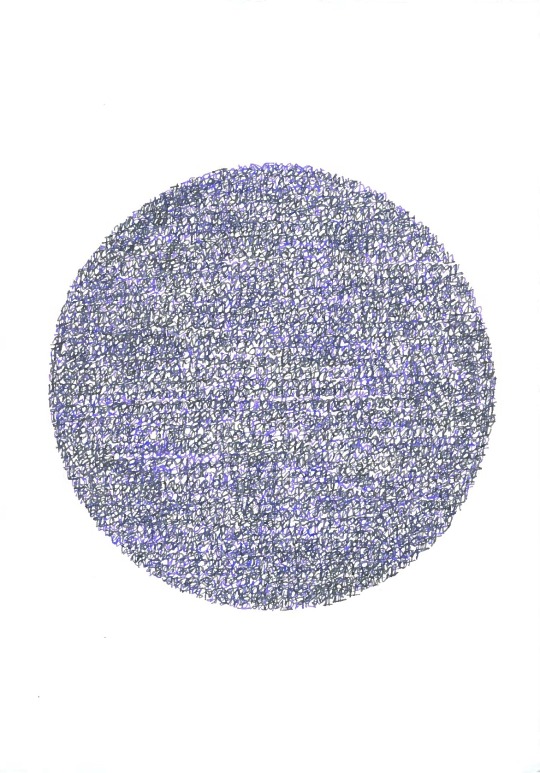
Sharmistha Ray, Blindspot #16, 11.75 x 8.25 inches. Automatic writing with colored pens on archival sketchbook paper, 2018-ongoing
SR: I started the Blind Spot series when I came back from India. It was like starting all over again. So I gave myself a blank slate and made the simplest shape that felt whole to me - a circle - and I started writing in the circle. It became a stream of consciousness, but I also wanted to bring my image-making and writing practices together and hold them in the same space. I also started to fantasize about making work that I could just roll up and travel with. I had just shipped a 40 foot container back to New York with all the stuff that I had accumulated in India. Much of it was large paintings and heavy parts of installations. I imagine just being able to carry my work with me wherever I go.
MH: That’s the dream!
SR: The Blind Spot works were about coming back to this culture and feeling invisibilized again. I like that the cursive gets all tangled up and becomes a hybrid script. It could be English or Bangla or Arabic. I didn't want people to be able to read what I was writing. I wanted them to be like protective shields for my messy outpourings. As I built in time and endurance, it activated my unconscious more and became a form of automatic writing, which I did in guided settings with a healer in India. That was more a way to tap the unconscious, but I’ve also used automatic writing in a seance in my recent Hilma’s Ghost project. Different kinds of channeling. I’m a real believing skeptic. There’s this book called the Red Book by Jung which is a record through illustrations of his departure from ‘a rational state.’ I like to think all these alternative methods are connected to understanding the mind. The Blind Spot series eventually morphed into more Tantric compositions. I am interested in narrative in abstraction, one that is implied rather than depicted. Becoming more compositional was a way to explore that tendency. I wish I could just work on all these different series in parallel, but it becomes about time and capacity.
MH: Someday!
SR: Yes someday I’ll have different studios within a studio for drawing, painting, installations, everything! I’m definitely not linear at all.
MH: Me neither.
SR: Have you had instances of returning to bodies of work you've made in the past?
MH: I’ve got these four or five different bodies of work going. The first person perspective paintings, the paper works that represent and unpack historic textiles and a series of works that I call “from life” and are actually dealing with notions of memory through the photograph and immediate observational painting among others, they come in and out when the time is right. Each body of work functions like a check in for me to align with a certain way of seeing, a speed of mark making, a method of applying color - a logic in approach. They are different from each other, even though it all comes from me, they ultimately present themselves with different kinds of physicality. And in terms of visibility in the art world, I think it can be confusing for people. Whereas for me, striving for a singularity feels so dishonest, I’m just way more complex than that. I have different moods and want to work in a certain way sometimes and in another way other times. It can even be seasonal honestly, I love getting wet in dye baths in the summer for example. I really love giving myself freedom to do that. I think part of the benefit of teaching is that it is a way to be able to continue to experiment, to maintain curiosity and a questioning stance, I feel like it gives me that permission, teaching is such a privilege in that way.
SR: Walt Whitman said ‘I contain multitudes.’ It’s interesting that he was queer too. Not to limit it to the queer experience, but I do think there’s something in the queer condition that requires multitides. David Getsy has written that too [through the lens of queer abstraction]. I also think people who embody different cultures at the same time or at different intersections also think in terms of plurality. I find it very alien to my being to consider just one path.
MH: Me too.
SR: I think how you hold that plurality or a sense of multitudes is tricky in the art world. There’s still a dogma around the singularity of style that overrides the spirit of exploration. I agree that teaching keeps me honest too. I learn a lot from my students. For my own work, I’ve been trying to hold the formal and the sacred together in one space. Practicing divination openly through Hilma’s Ghost has been interesting. I always thought of my spirituality as something private. And now of course, I am doing seances and I said I drew the line at mediumship!
MH: Oh yes, (laughter) I know, I was going to ask, are you ever scared?
SR: Of ghosts? Well, I am from South Asia. We definitely believe in ghosts! I grew up with stories of ghosts that the elders would tell us and it was quite normal. I’ve had to keep an open mind though. Part of why the spiritual and the sacred has been exiled from western thinking is that it exists in this non-descriptive abstract space. I’m reading a book on magic right now and it's interesting that malign magic, which is the malevolent form of magic, is actually a very small aspect of witchcraft; but it’s what has received the most amount of attention. You have to think they were just going after women who were independent. It threatened and still threatens patriarchy. Hilma’s Ghost is a feminist project so it’s about undoing conditional ways of thinking for myself first. I do tend to get cognitive when I am in an unknown space; it’s balancing that cognition with going with the flow.
MH: I mean. It’s such a good and powerful tool, yes.
SR: It can be helpful. There’s so much we don't know. It’s kind of wild how the dots connected for us [in the Hill-Stead project]. Artists are also magicians in a way. We undergo these subtle transformations while we do our work. I’d love to have a parallel practice again to explore that through a different space, like kundalini, but again, it’s time and capacity. I also tend to go with my curiosities. I envy people who stick to one practice for 20 years. I’m a creature of change.
MH: You’re teaching at Parsons and Carnegie Mellon, right? Is that true?
SR: Yeah, teaching helps to clarify my own thoughts. I have been teaching a critical theory class for the past few years which privileges identity politics with respect to race, ethnic orientation, sexuality, gender, all the intersections! Being in the space of identity politics for two decades I’ve also moved closer to a sense of self and reclaiming joy. I also want to reclaim culture and feminist labor, so I do that through my titles now as a way to continue creating disruptions in the way that we are seen as BIPOC people. I used to get frustrated by the westernization of references that happens when someone looks at your work here. There are so many ways of recovering the way that we are seen and how our work is regarded. I’m not interested in being misrepresented through the fallacy of open interpretation of our work. We have so much to learn from the Black and Indigenous movements in this country. In the Blind Spot works as well as the more built up works I did on vellum later on, like The Night Is Dark and Full of Rainbows and the Cosmic Earth works in which I communicate labor through the process of automatic writing for 50 to 60 hours. I like the idea of endurance communicated through density…
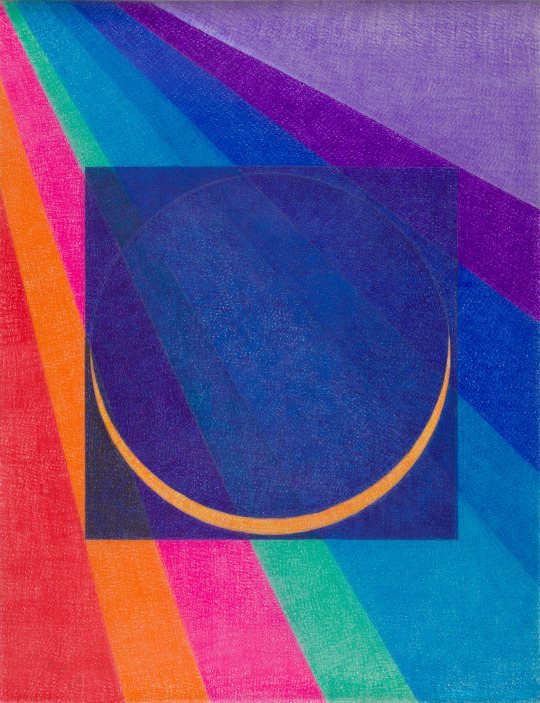
Sharmistha Ray, The Night Is Dark and Full of Rainbows, 25 x 19 inches. 60 hours of automatic writing with colored pens on vellum, 2019
MH: I really appreciate the level of density that you arrive at and you kind of let it sit in the space where it's vibrating in a wholeness of form built through individual marks, or it can kind of shift depending on something like the time of day perhaps. I love your willingness to let everything in, it is not easy and I have huge admiration for your courage and diligent commitment to the way you contextualize your work on your own terms. How big are these?
SR: These are 19 by 25 inches so not very large. They're like sheets of paper and I like that idea of the illuminated manuscript, something that relates to the scale of my body. There’s 7 works in the Cosmic Earth series which required 350 hours of writing. I worked for 8 hours a day to finish them. It was a very meditative and distilled process. It helps to clarify thinking. I showed them during Asia Art Week a few years ago. It was Leeza Ahmady who is the founder and curator of Asia Art Week who encouraged me to think in a more nonwestern context about how to frame these through the use of titles. So if you look at the titles, there’s the presence of bhakt poetry and moments of Bengali script as well as taking for the form of a musical raga. I grew up learning classical music and the ragas are just a beautiful musical form, so connected to lived experience and times of day. It also allowed me to work sequentially, thinking about the movement from day to night. Wow, we have talked for so long as I haven’t even started talking about Hilma’s Ghost…
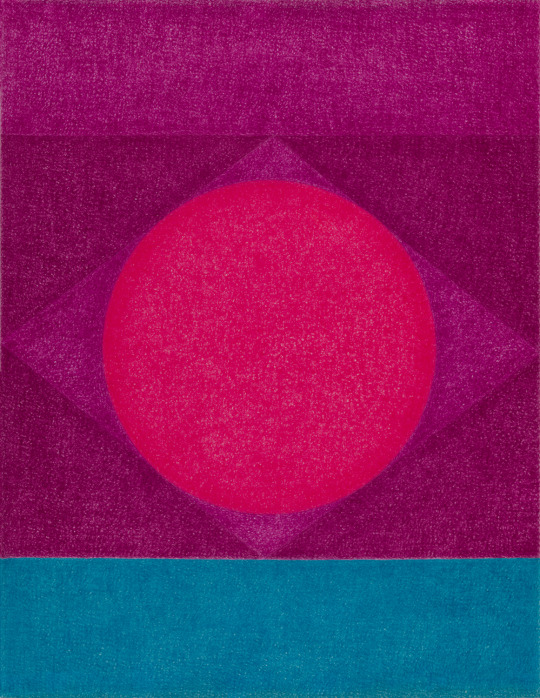
Sharmistha Ray, Cosmic Earth No. 3/7 (Chapters of the Day): Raag Asaveri (Late Morning), "Your skin as warm as pebbles on the beach / Noon-high sun/Manipura / Yellow-Pink" teen taal: 5'52, 25 x 19 inches. 50 hours of automatic writing with colored pens on vellum, 2018
MH: I know! I mean that’s Okay, that can happen in Part 2! It’s been such a pleasure to revisit your older works which I have long admired and to discuss your influences and roots, it’s all related. The Hilma’s Ghost project is incredible and has so much momentum, I’ve loved all the programming you are doing around the project, the collaborative nature of it. Maybe we can continue this conversation on our road trip with friend and artist Fariba [Alam] this fall, to the Hill-Stead Museum to see your Hilma’s Ghost show!
[*Sharmistha uses the birth name of their city, Calcutta, also known as Kolkata]

Meena Hasan (born 1987, NYC) received her B.A. in Studio Art from Oberlin College in 2009 and her MFA in Painting and Printmaking from Yale School of Art in 2013, where she won the Carol Schlosberg Memorial Prize for Painting. In 2010, she was awarded the Terna Prize Affiliated Fellowship at the American Academy in Rome. She has participated in numerous group exhibitions domestically and internationally including the 'Bosch Young Talent Show' at The Stedelijk Museum, Den Bosch, The Netherlands, 'Good Pictures', curated by Austin Lee, at Deitch Projects, NYC, and the 2022 New England Triennial at the deCordova Sculpture Park and Museum and Fruitlands Museum. Recent solo exhibitions include 'Mangiferin Chintz' at LAUNCHF18, NYC and 'Covering as much of the sky' at RISD's Memorial Hall Gallery, Providence, RI. Meena is currently Assistant Professor in Painting at RISD and lives and works in NYC.
www.meenahasan.com @I_meen_ah
Sharmistha Ray (they/them) is a Brooklyn-based artist, art critic, and educator. They use interdisciplinary methods and make paintings, drawings, sculptures, and installations to explore themes of intimacy and connection through the lens of queerness and abstraction. In 2020, they co-founded Hilma’s Ghost, a feminist artist collective that engages in collaborative research, exhibitions, and pedagogy. They have participated in 50+ exhibitions internationally, including the solo exhibitions (both independently and with the collective) RADICAL SPIRITS: Tarot, Automatism, and Feminist Histories at Hill-Stead Museum, Farmington, CT (2022); ABSTRACT FUTURES TAROT at The Armory Show, New York, NY (2021); and we are all islands I and II in Mumbai and Kochi (2016-2017). Ray is the recipient of notable awards including a Joan Mitchell MFA Grant (2004) and their work has been reviewed in The New York Times, Artnet, and Hyperallergic, amongst others. Their writings have appeared in notable publications including Where Is Art?: Space, Time, and Location in Contemporary Art (Routledge, 2022). Currently, they teach at Parsons School of Design and Carnegie Mellon University. Ray received a dual degree M.F.A. in Painting and M.S. in Theory, Criticism, and History of Art, Design, and Architecture from Pratt Institute.
www.sharmistharay.com, www.hilmasghost.com @sharmistharay, @hilmasghost
0 notes
Text
19. Melissa Joseph & Anya Paintsil
Melissa Joseph and Anya Paintsil discuss the connections between textiles and their personal and cultural histories, their material choices, and the openness and vulnerability of their respective art practices.

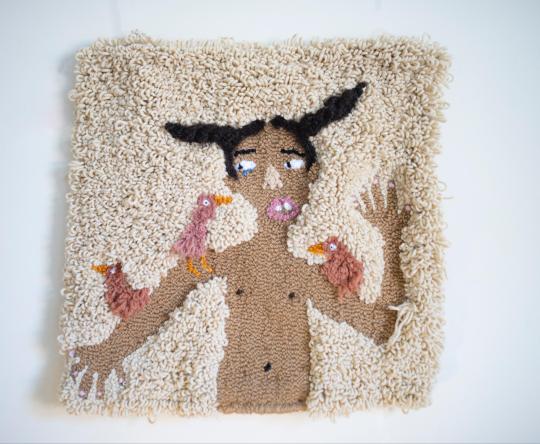
Anya Paintsil, Adar Mair 2022, Punch needled acrylic, wool, and alpaca, human and synthetic hair, twisted and felted, on hessian. 21 x 21 inches
Melissa Joseph (MJ): Hi Anya! I remember seeing your work for the first time and being blown away. It spoke to the core of my being. I didn't know anything about you yet, but I just knew the work was captivating and that I wanted to see more.
What do textiles mean to you in a broad sense and then more specifically? For me broadly, having an Indian father, my formative years included a lot of colors, textures, and materials in my immediate environment. My mom being a crafter meant that the materials I had access to most readily were often fiber or fiber adjacent.
More specifically, I view felting as a native language. Everything about the process mirrors how my brain works. There's organized chaos, an element of chance and an opportunity to be in conversation with the material. Also it feels like painting.
Anya Paintsil (AP): Hi Melissa! The feeling is totally mutual! I am totally enthralled by your work and I’m so excited to have an opportunity to link up for this discussion.
I think, similarly to you, my formative years heavily influenced my interest and ideas about textile. I’m Welsh and Ghanaian and grew up in North Wales in a household with a lot of Ghanaian influence. Historically and contemporarily cloth and textile are pretty significant on both sides of my heritage and in my childhood home we always just had tons of random fabric someone was planning to do *something* with one day - African Wax Print, Adinkra cloth and Kente Cloth, as well as a couple of Carthenni - Welsh woolen tapestry blankets that had been handed down through my family.
I think in the broadest sense, I view textiles as a form of communication, sometimes communicating a direct message to the viewer through visual language, other times they communicate a creative lineage, social history, or the cultural or social background of the maker. I feel like textile as an art form is a very politically loaded medium.
More specifically again I think I’m the same as you! Textile, but more specifically rug hooking for me is natural and intuitive. It’s like drawing to me... I think the work I make couldn’t exist in anything but textile.
In regards to your work, how did you arrive at figurative textiles?
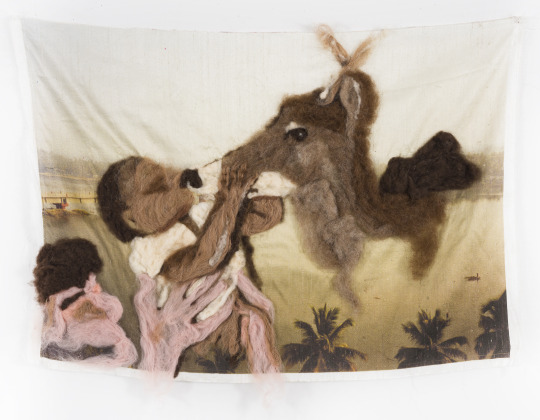
Melissa Joseph, Rural Roots, Needle felted wool on inkjet printed Indian silk, 20 x 28 inches, 2020
MJ: Maybe we saw ourselves in each other’s work! I am Indian and Irish, raised in America so we are like the bizarro versions of one another! I love your phrase “creative lineage.” I am going to chew on that for a long time. I arrived at figurative textiles the long way. I was trained as a textile/surface designer in my 20s and worked in the industry for a few years. But then I took a detour and taught high school art for 10 years. When I finally pursued my own practice full time, I started by making work to honor victims of violence I read about in the news. However it soon became apparent that it was not really my content. It didn’t make sense for me to be meditating on the lives of these folks I didn’t know, and so I turned to my own life for subject matter. There is so much to mine in the way of the human connection from unassuming everyday moments. I think especially because, like you, I have two different cultures coming together in my home, mind and body, there is this constant comparison that allows for an even closer reading. I am interested in the emotional power of the imagery and the objectness or presence of textiles coming together in a way that blurs lines in the way that my labels are blurry. Things like fine art, craft, identity, object, painting, function, narrative, fiction, memory, and even truth are all tangled (literally, this is a terrible dad joke of a word to use) up in our works. Beyond that, it is a way to connect with my father, who passed away in 2015. Each time I render him, he comes back for a second, and then disappears again. I also live far away from many of my family and friends, so this is a way to be present with them.
Do you have thoughts about how conversations about labor and textiles overlap? Can you talk about the origins of the materials you use? Your color palette is just beautiful, by the way.
AP: Your thinking around connection and emotional power really resonates with me - I usually depict family and friends in my work too, I wonder if it’s something about the soft materials and the familiarity of textile that adds some sort of comfort? Particularly when making work of a loved one who has passed.
I think labour intensity was a big part of my practice conceptually to begin with, my decision to work with only traditional hand tools as opposed to new motorised tools was very significant to my work as well as buying loose braiding hair and twisting and plaiting or locking it myself instead of buying pre or twisted, braided, loc’ed crochet hair.
I wanted to challenge archaic preconceived notions of textiles and hairstyling that are often rooted in misogyny and racism due to their associations with femininity and women of colour.
Textiles- being dainty, or a mindless past time or in the case of afro hairstyling an act of vanity, pursuits that should be relegated to the domestic, with both requiring little strenuous effort or skill - this is of course not true in any incidence, but my choice to work at a large scale, entirely with non electronic tools, and with a type of textile -rugs- that is most associated with utility as opposed to the decorative was a conscious decision for me. I like the labour to be evident in my work.
As time has gone on I’ve had to find ways to make my work less intense and laborious though - I’m autistic and I often get hyper fixated when developing an new body of work and literally spend 12-13 hours a day working on a piece which led to a lot of burnout and not looking after myself, but also because of my autism I have trouble with figuring out what’s going on in my body sometimes - and wouldn’t be able to really register the pain in my wrists until they were stiff and uncooperative!
I’ve recently moved away from working completely with a punch needle and I’m using some other non-electronic tools, I sourced a 1970s Danish egg beater rug making tool and I just got my hands on a 1950s Airlyne rug maker, a tool developed in Abergele, in North Wales close to where I grew up. which is powered by foot, sort of like a vintage non-electronic sewing machine.
As for my materials - I started off really buying what I could afford while at university, and reusing a lot of materials because they were so expensive! You can find a lot of yarn in second hand shops in the UK, so I’d grab whatever fit the colour palette I had in mind - the colour palettes and textures of yarns of my work denote a loose sort of series - or at least works made in the same vein so I tend to use the same ones.
The human hair in my work is usually my own - I have used small amounts of my sister and brother’s hair in work depicted them but using my own hair is really significant to me - I’m very interested in ideas of agency in relation afro hair - like all black and mixed black people with textured hair I’ve had a lot of experiences with people asking to touch my hair, or sometimes putting their hands in my hair without asking permission and several incidents where people become affronted or even angry when I’ve declined to let them touch my hair - but something changes when it’s no longer part of my body. When my hair is removed from me and placed in a gallery context, it is suddenly understood that it can’t be touched under any circumstances. I actually find it really troubling that my artworks somehow have more agency and rights to bodily integrity than my actual body - but I hope it’s something people will consider.
I’m really interested in hearing more about the materials you use and the ways you hang your work I also love your usage of frames, and would love to hear more about they become part of your work?
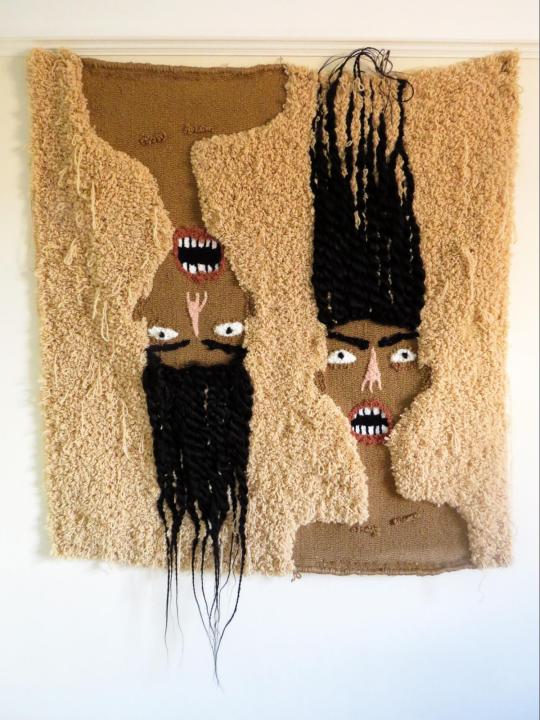
Anya Paintsil, No Bonnet, 2021, Punch needled acrylic and wool, twisted synthetic hair on hessian, 52 x 54 inchesMJ:
Everything you say resonates with me so much! I think it’s amazing that even before having this conversation we recognized this in each other’s work. It makes me so happy. I often think about what it is exactly that draws people to specific artists or artworks. I know the answer isn’t simple, but it can be something impossible to name or identify. I appreciate your openness and sharing these vulnerable parts of being an artist that essentially makes our insides visible on the outside. I spent so much of my life trying to make the outside look like I had everything “together” while the inside was a bit messy. In my art practice I can let the inside be a mess, but also let it be seen. What a relief! It is such a powerful thing, and feels honest. I am so glad you mentioned the hand tools, also, because it is a constant battle. Listening to the body, or trying to, but also when the body fails us in pursuit of something greater. I do my felting by hand as well. I also carve stone, and much prefer to use chisels than angle grinders (though with some stones, it is not possible for me to do.) Finally, I am so affected by your last comment on hair being attached vs. hair being unattached and its impact on the entitlement of others. I will never not think of that perspective now.
To answer your question about framing, I think I have a natural inclination to hold things. I really feel like a holder of things. I hold stories, feelings (mine and others), histories, objects, I am a cradler. I used to make vessels before I started felting. I still do, but other times I find things to act as surrogate holders for me. They are often found objects that speak to me. That part I can’t explain really, just some objects say “Pick me” and others don’t. Once I have the containers, either made by me with things like ceramic or paper, or found, they sit with me for some time. It can be months or even years before I know what image it should hold. The objects carry their own histories and stories and then those just get added into the story that I am bringing. It feels like a natural thing that happens as we bounce off of people, places and things in this world. We pick up some of them and leave traces of ourselves on the things we come into contact with.
2 questions for you :) I am curious about how you title your work. What are your thoughts on this? Also, I have been following your work for a few years now and you seem to have really solidified your visual language in the last year in a way that is so tight and clear. Do you feel this happening?
Do you have any thoughts about Legacy and do you think about the work living on after you are gone?
AP: I think I understand what you mean about being a bit messy! ! I don’t find the direct processes of working with textile particularly therapeutic or cathartic - I find it pretty chaotic - but there is something about organising that chaos and making something with the mess - taking my ideas and my thoughts and feelings and all of the pieces of yarn and hair and manipulating them into something new and different. It gives me a weird sense of calm, or at least it is kind of break from the chaos.
It often feels like I’m releasing something or letting go of something.
Most of my works are inspired by my experiences and memories, my practice is quite autobiographical - the people I depict are usually people I know - of the works below - ‘No Bonnet’ is me, ‘Adar Mair’ and ‘Bolognese’ are two of my siblings. A lot of the titles come from the memories, usually something that sounds quite funny or strange out of context or or something that’s just stuck with me.
I also title a lot of my works in Welsh, my first language, I tend to do this most with works that are inspired by memories or photographs from my early childhood, a time where I spoke Welsh more than I did English.
The decision to use the Welsh language is an assertation of my identity, as a Welsh person of colour, and a Welsh speaking person of colour - as these facets of my identity are often seen as juxtapositions.
In regards to my visual language, I’m not sure if it was something I was really conscious of. I graduated from my BA in 2020 so a lot of the earlier work of mine you will have seen was made while I was a student - what and how I was making was dictated by deadlines, and there were tons of other distractions. I don’t think I was taking it as seriously either, I come from a working class background, I left school at 17, I worked in a series of random jobs until I went to university at 23. Being a working artist didn’t seem like an at all realistic goal to me right up until I got gallery representation in my final year at university and I started selling work. This was all the beginning of covid -
As awful and selfish as it sounds, my last year of university being cut short because of the lockdowns, and the whole world stopping was kind of good for my practice? Obviously covid hasn’t been a particularly great time for anyone, my grandma died from covid at the beginning of the pandemic, I have some health issues that make me quite vulnerable so I spent the majority of the last two years cooped up at home.
I didn’t see anyone but my boyfriend, I rarely left the house and I spent all of my time thinking, reading and making work on our kitchen floor. I think the breathing space away from the rest of the world really helped me focus and grow as an artist.
I don’t really think about legacy and I don’t have hopes for what will happen to my work.
I have different relationships to each of my works - there’s some I’d be happy to never see again, others I really regret letting go, some I will never sell and will never share with anyone. Same with my sketchbooks.
If I live to an old age I think I’ll destroy them before I die. If I die suddenly of some kind of freak accident then I don’t know, I should make a will really.
MJ: I am so sorry to hear about your grandmother. Thank you for your openness and willing to be vulnerable in this conversation. I have really enjoyed this exchange! xo
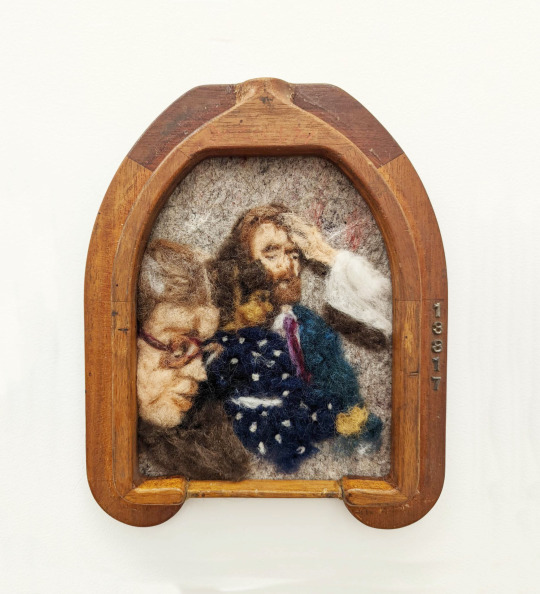
Melissa Joseph, Baptismal Blessing, Needle felted wool on industrial felt with found wooden frame, 10 x 8 inches, 2022

Melissa Joseph is a Brooklyn-based multimedia artist. Her work addresses themes of memory, family history, and the politics of how we occupy spaces. She intentionally alludes to the labor of women as well as experiences as a first generation American and the unique juxtapositions of diasporic life.
melissajoseph.net @melissajoseph_art
Anya Paintsil is a Welsh Ghanaian artist based in Northern England, Anya seeks to centre her practice around skills learnt outside formal education settings. Her work combines traditional hand rug making methods with afro hair styling techniques to create wall based portraits. Drawing from personal narratives, Paintsil’s work frequently focus on the significance of race and black identity outside of urban areas, feminism, memory, storytelling and fantasy.
@anyapaintsil
0 notes
Text
18. Raghvi Bhatia & Nadia Haji Omar
Raghvi Bhatia & Nadia Haji Omar discuss their shared interests in language, craft, and abstraction, the ways that the specific layered histories of the South Asian cities they grew up in influenced their work, and the influence of the spiritual in their practices.

Raghvi Bhatia (RB): Hi Nadia! I'm so excited to have this exchange with you. Although we have never met, I feel a deep sense of kinship with you, in part due to similar life experiences and in part due to our several shared interests - such as language, craft, and abstraction. I first came across your work on display at the RISD Museum while I was an undergraduate student. I was immediately captivated by how each mark you make is simultaneously precise and free, individual yet part of a whole. In our conversations, you mentioned that you "See (your) work as the most basic of forms- line and circle/dot and (you are) really interested in how to push that to its limit." A contemplation of the line and the circle/dot in your work reveals hidden stories of cultures, new and old, in which you are embedded. Can you talk more about what these two basic forms mean to you? How and when did you start working with them?
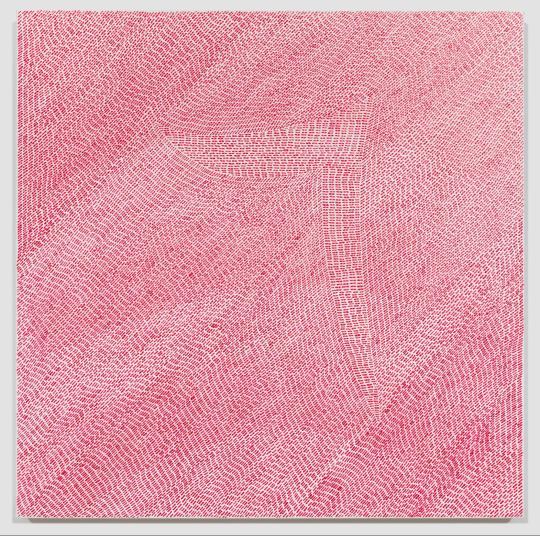
Nadia Haji Omar, ٦ (sitta), Acrylic and dye on canvas, 24 x 24 inches, 2019. Photo by Etienne Frossard. Courtesy of the artist and Kristen Lorello, NY
Nadia Haji Omar (NH): Hi Raghvi! I am so happy to have this conversation with you. Thank you for your kind words and observations about my work. I first saw your art on instagram and was instantly drawn to it. I love what you have shared with me since then. The aspects of your work that spoke to me the most are its' spiritual and tactile qualities. I think we share a similar sensibility, touch, and attention to detail. Even though we work in different mediums we are dealing with similar ideas and content.
I first started to incorporate the circle and dash/line motif into my work in 2015. My paintings in 2016 included them to a greater extent and by 2018 the entire surface of my paintings were covered in these marks. My intention was strictly technical yet my choice of mark was intuitive. I was interested in the concept of "Simultaneous Contrast" as developed by the French chemist Michel Eugène Chevreul. Simultaneous contrast refers to the way in which two different colors affect each other. The theory is that one color can change the way we perceive the tone and hue of another color when the two are placed side by side. The actual colors don't change but we see them as altered.
By using these simple tiny shapes I was able to experiment with color changes across the surface of my paintings. The "background" is often dyed over which hundreds or thousands of these smaller marks are overlaid. The circles and lines themselves are always centrally "dotted" with a different color. Therefore I was able to have three different colors be present simultaneously in a very small space, and to observe how they affect one another.
Over time the repetitive and meditative process inherent in making this kind of work won me over. I have since explored other optical effects and visual territories that are afforded by this type of mark making. It is worth mentioning that the circle and line lend themselves to repetition and if I had to I could trace my first use of the repeated short line/dash back to etching or intaglio in printmaking.
Could you please tell me about some of your material choices, especially the glass seed beads. When did you start working with them and why? Generally which types of materials do you find yourself gravitating towards?
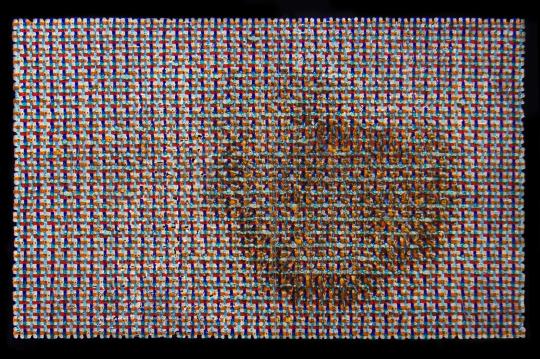
Raghvi Bhatia, Stained, 2021; Fused Glass Seed Beads
RB: I grew up in Delhi, a city that was razed and rebuilt multiple times over, where each of its successive conquerors left traces of art, architecture, language, food and religion when they were conquered. I have always been intrigued by the way that the victors incorporated remnants of the cultures they vanquished, creating a polychromatic blend of cultures by building not over, but with, the material left behind. This catalyzed my interest in loan-words - words adopted from a donor language that are seamlessly incorporated into another language without translation - but also, in a similar vein, loan-patterns and loan-craft objects.
I would say I generally find myself gravitating to working with elements that have a rich history of being loaned and leased, due to changes in human geography caused by migration, invasion, or globalization. The glass seed beads are one such ‘loan-craft object’. In 2019, I was deeply invested in studying craft histories as well as glass processes. Through either chance or fate, I successively came across multiple objects from vastly different cultures and time that all incorporated glass seed beads in a multitude of differing ways, that culminated in a visit to the location (in south India) where the first glass seed beads were made, over 3000 years ago.
A deep dive into the history of the beads revealed how once the beads made their way to Europe, the Italian glass industry perfected the art of making them en masse. During European colonial endeavors, the beads spread to large swaths of the Americas, Africa and Asia, as they are practically indestructible despite being made of glass. Often used as currency, the beads became a vehicle for colonization, while indigenous communities adopted and seamlessly incorporated the bead into existing religious and craft traditions, using the beads to adorn the objects of foremost importance.
I think there is a certain violence, beauty and gravity embedded in each bead. At the same time, there is something intuitive about working with the beads for image-making, as singular units that make up a whole - like pixels or stitches (or dots!). The process of working with the beads is extremely labor intensive, but this sort of devotional labor is pivotal to my exploration of the beads as a unit of time, labor, and faith. In my work, I fuse the beads together, creating delicate glass tapestries, subverting the resilience of the beads that made them ubiquitous.
How about you? I know you have been working with gemstone inclusions in some of your new work, how did you start working with those new materials? Has working with the gemstones been similar or different to your intuitive way of working with the line and circle/dot?
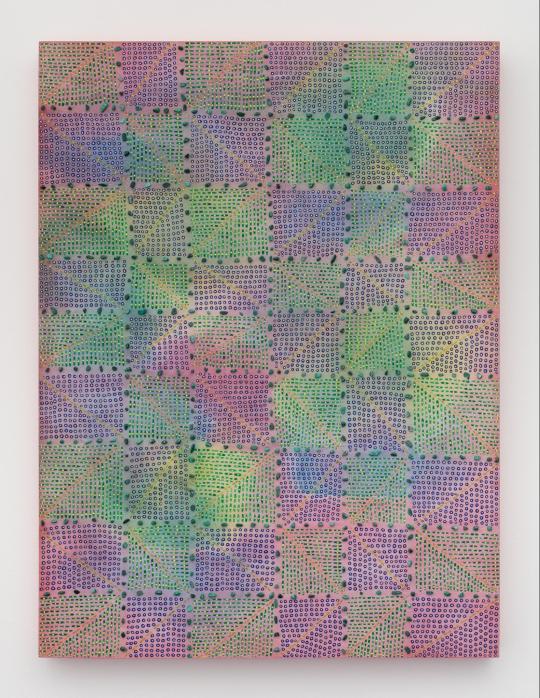
Nadia Haji Omar, Pink Grid, Acrylic, dye and malachite on panel, 24 x 18 inches, 2020. Photo by Charles Benton. Courtesy of the artist and Kristen Lorello, NY
NH: That is fascinating! I mentioned to you that I recently started a new body of work using glass seed beads and it is wonderful to learn so much about the history of this material. The way you work with the beads is even more meaningful and beautiful within this context. It is also interesting that beads are one of the first craft materials a child gets to play with (beads on wire toys etc). The act of stringing beads on a thread feels like both an instinctive and ancient activity.
I can relate to a lot of what you describe about living in Delhi. I grew up in Colombo, Sri Lanka and it has a similar history of colonization as India (Dutch, Portuguese and British). Certainly I absorbed the traces left behind by the blending and merging of these cultures. The vivid colors and cacophony of multilingual text (Sinhalese, Tamil and English) and images on road side signs are deeply embedded in my mind. This has found its way into my work and has been a recurring theme for several years now.
Living in many different places makes you more aware of the distinct visual characteristics of each location. There is less time for the familiar to set in and be taken for granted. Every time I am living in a new place it takes a long time for the imagery around me to feel familiar. The sensation of being a stranger in a foreign place can be inspiring as much as it is bewildering.
The gemstones are a recent addition to my paintings, I have been including them in my work since 2019. I have always had an affinity for multiples of little things, like pebbles, beads, grains etc. I wanted to include a relief aspect in my paintings and decided to try some semi-precious gemstones in beautiful naturally occurring colors. They all have different spiritual meanings and properties.
I treat them like a drawing tool, usually arranged in lines or grids. I enjoy adding an irregular shaped element to these paintings with their otherwise rigid uniformity of lines and circles. Yet the pieces are so small that they (hopefully) don't overpower the rest of the painted surface. I am still exploring this new material. I love having a piece of the natural world present, active and preserved in my work.
This leads to my next question for you which is about spirituality, religion and devotion. Could you speak about your personal beliefs, systems or any related interests? How do these manifest in or influence your work?
RB: First off - I cannot tell you how much I relate to your “affinity for multiples of little things”! I think it definitely makes sense considering our mutual proclivity for drawing inspiration from language, textiles and patterns. I wonder if this has something to do with what you said about being a stranger in a new place? Perhaps seeking and finding patterns (even in the littlest things) offers a sense of solace in the bewilderment of new surroundings.
To answer your question, I think no matter one’s age, geography, ethnicity or culture, everyone’s life (diet, calendars, working hours, education systems, clothing, etc.) is heavily influenced by religion, despite what one’s personal beliefs may be. At the same time, I also believe that in some parts of the world this can be observed more clearly, and I think South Asia is one such part of the world. This palpable importance of religion in daily life combined with the rigidity with which a lot of people (theists and atheists) approach religion is one of the reasons why I am so interested in working with the concept of religion. In the art world and in the real world, we lack a vocabulary to talk about religion unless it is with people who have similar beliefs as us. This leads to either a complete lack of conversations around the subject, or conversations wherein we tiptoe around subjects that should be approached head on. That is the reason why I frame my artistic practice as a religious sect - when I first say this to people, everyone thinks it is amusing. But I do not say it ironically, and the amusement often turns into discomfort. It has definitely been equal parts rewarding and challenging for me to work in this way while avoiding all of the tropes of being an Indian artist making work about religion, spirituality or craft. Do you also face the challenge of avoiding tropes, or being boxed into creating the work that is expected of you because of your gender/racial/ethnic/religious identity?
Personally, my beliefs are fluid and regularly shift, but I think I would say that I am an atheist, in a narrow sense - I do not believe in a theistic God. In a broader sense I would say I am agnostic - I have neither a belief nor a disbelief in the existence of any/all divine beings. However, I grew up in a family where almost everyone was a practicing, upper-caste Hindu, my education and socialization happened in largely the same context as well. So my religious sensibilities were informed through that lens. It has taken a huge amount of conscious effort for me to be able to even begin unlearning the harmful ideas of purity, morality, absolution and hierarchies that I absorbed. At the same time, I am acutely aware of the power of symbols, stories and rituals, especially when combined with the power of belief. I use these elements in my work to create my practice-as-sect, to upend conventional conceptions of religion and art, and create a coherent worldview to organize my practice and govern my work. This happens in a myriad of different ways - I have constructed new rituals for my sect, developed a new craft of working with the glass seed beads by fusing them, and created a new sacred language. The language is based on the Moorish mosaic craft of Zellige, has a radial sentence structure, and is heavily influenced by local dialects. In many ways, it is a manifestation of the tenets of my religion - non-linear, rooted in material histories, local, stemming from nature and the body.
How about you? Do you have any belief systems that inform your work?
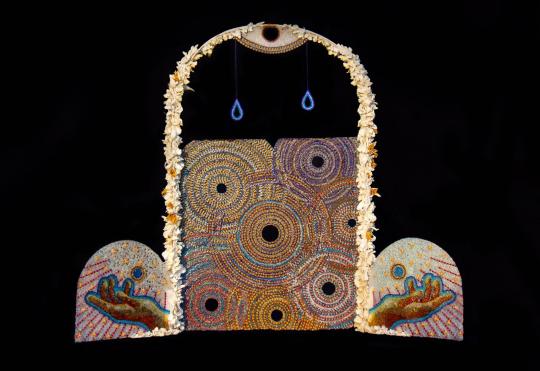
Raghvi Bhatia, Altar for Collective Mourning, 2021; Fused Glass Seed Beads, Steel, Porcelain
NH: Very interesting, I agree most people aren't aware how much of our lives are shaped by religion despite (a lack of) personal beliefs. I also agree that the spiritual aspect of life is so much more visible in Asia. Even the other life processes such as birth, aging and death are more widely acknowledged and exposed than in Western society.
I asked this question because as you mentioned I find myself hesitant to speak to people about this aspect of my work. Although my belief systems can be very obvious in some of my work, I have kept this part of myself mostly private. It is difficult to find the right language to speak about it. I greatly admire that you frame your art practice as a "religious sect" and I hope that it will help to open up this topic for other artists like myself.
I was raised in a household split between Islam and Christianity, with attention and observances given to both. When I was old enough to understand it the focus of my faith was in Islam and I identified as a Muslim. However, the backdrop or context for this was Sri Lanka, a country which is 70% Buddhist and 12% Hindu, with other religions making up the minority. I was fortunate to have friends who spoke openly about their beliefs. I was also able to witness various types of religious rituals and festivals that were celebrated publicly around the country. As I grew older my interest in all major religions expanded and my interest remains strong.
My art practice has always felt like a deep meditation, a way to be silent, connect with myself and a larger entity, energy or force. Both art and religion are concerned with the ideas of peace, compassion and unity. I wonder if perhaps many of us subconsciously frame our "practices-as-sect", we just don't have the courage or vocabulary to express it as you so powerfully do.
I do think that I have found one way, a small way, to subvert some of the tropes about myself as a "multicultural" artist and that is through the process of asemic writing. When I first decided to include text based elements in my work through the use of other languages (Sinhalese, Tamil, Arabic etc) I also wanted to include an abstract, non-referential language of my own. I saw a way to do this through the use of asemic writing. Asemic writing is a wordless open semantic form of writing. The word asemic means "having no specific semantic content", or "without the smallest unit of meaning".
This was wonderful and I learned so much, thank you!

Raghvi Bhatia is an artist who considers the artistic experience as analogous to rituals: of searching for the sacred, of visiting religious institutions, and of questioning existence. Bhatia earned a BFA in Glass from the Rhode Island School of Design where she developed her artistic practice as a religious sect. Her ascetic and aesthetic philosophy explores similarities between glass, skin, and water–materials that are at once enduring and fragile.
raghvi.work @raghvib
Nadia Haji Omar's paintings and works on paper explore the intersection of language and abstract painting. Inspired by an ongoing research of scripts that include Sinhalese, Tamil, Arabic, and French, her intricate imagery combines inventive linguistic characters with references to landscape, mapping, and textile patterning. Haji Omar received a MFA from the School of Visual Arts in 2014 and a BA from Bard College. Her works have been discussed in New York Magazine/Vulture, and Hyperallergic, among other publications, and are included in the collections of the RISD Museum, Providence, RI, and the Hallmark Art Collection, Kansas City, MO, among others.
www.nadiahajiomar.com @nadiahajiomar
0 notes
Text
17. Jane Kang & Francesca Tamse
Jane Kang and Francesca Tamse discuss their work in the context of increased anti-Asian attacks, their recent collaborative project, the relationship between their bodies and their work, and the way their personal histories and cultures play into their practices.

Francesca Tamse (FT): Hi Jane, how are you? I wanted to start out by revisiting our first collaboration nearly a year ago. It was in the Spring of 2021. This was around the time there were several Asian American related attacks taking place across the country. I remember it was a bit of a raw feeling, becoming hyper aware of my body, my identity. We collaborated and took photos of your ceramics, and in retrospect, there was a connection connecting our identities as Asian Americans and our ancestral pasts. Could you reflect more on this time? Also, when constructing your ceramics, one specific piece that comes to mind is the ship and of the mother and child. I found this piece moving.
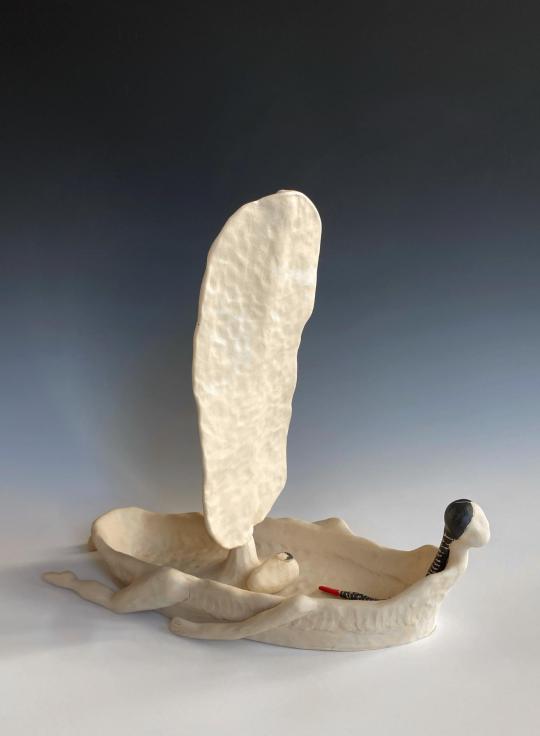
Jane Kang, Body Voyage
Jane Kang (JK): Thank you! I am well, I hope you are too.
I remember that time period vividly. It was a difficult time…between the escalation of attacks on AAPI, along with the extensive quarantine, it was (and sometimes still is) very difficult. Working with another Asian American woman was so special and needed at that time. I remember feeling a tenseness at the beach, quietly worried and feeling a bit exposed. Especially amidst the pandemic, I think you were the first artist I collaborated with in over a year.
As an artist working in the medium of clay, I often contemplate the idea of relics and the mysterious nature of antiquity. Relics are typically construed as quantifying a person’s life or providing contextual evidence of the times.
I developed a strong interest in researching myths and folktales from an early age—maybe because I found the whole cultural schism as an Asian American totally surreal. I also enjoy the notion of myths and folktales being universal, traversing either part of my identity as an Asian or a first generation American.
The world my parents grew up in has always been mysterious and will continue to be. In many ways, the Korea that they knew no longer exists. Their memories and experiences are relics I was raised by, but I didn’t understand why. And so began my ever-evolving theories, my own piecemealed definition of myself and my heritage while living in the contemporary world.
In my work, I implement many of these sentiments, especially matrilineal inheritances. The particular piece you are referring to, Body Voyage, which is loosely based on Goryeo era fishing boats and constructed directly after the shooting in Atlanta, Georgia, I was thinking of chimeras. The word itself means an illusory hope that is nearly impossible to achieve. It is also a Greek mythological female monster with a lion’s head, a goat’s body, and a serpent’s tail. In this piece, I was contemplating the deaths of these women in Atlanta, in particular a woman who strikingly resembled my mother. I imagined a new chimera, a woman who no longer had skin but naked bone in the shape of a boat. She can no longer physically return as the woman who gave birth. Instead, she is only able to look forward as she carries her child, an omniscient, calcified presence with the inability to speak. Much like how many immigrant women may have difficulty communicating with their children or being trapped in a form, finding it nearly impossible to realize their own hopes in exchange for survival.
In regards to your work, what themes do you find recurring? I admire your work with eggs and how much of your work seems to reflect that smooth, delicate texture to the surfaces in your images.
FT: Yes! My obsession with eggs. It became more of a study in my studio one day that cascaded into many iterations of its usage. In relation to surfaces, they photograph so beautifully. Sculpturally smooth, perfected, and requires careful handling. In my practice, I am interested in documenting the masculine body and performing masculinity under a feminine gaze. There is a tension I feel in particular looking back at the Warm Navel photograph. Here, an egg rests on a torso’s belly button.
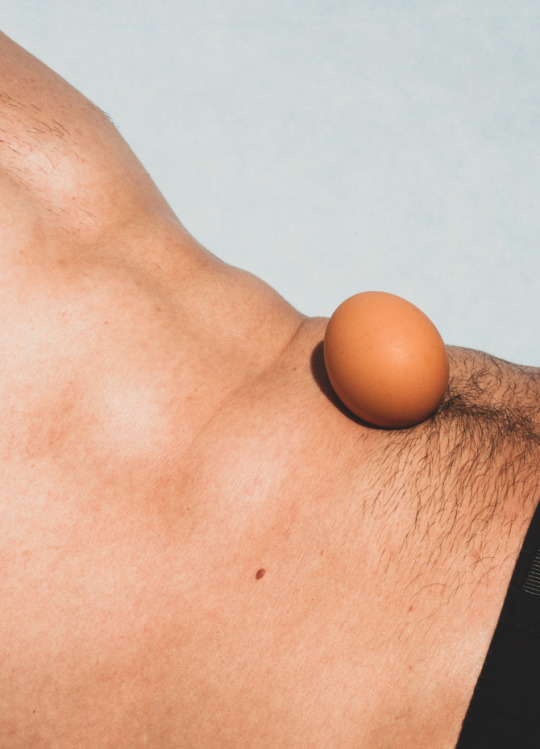
Francesca Tamse, Warm Navel
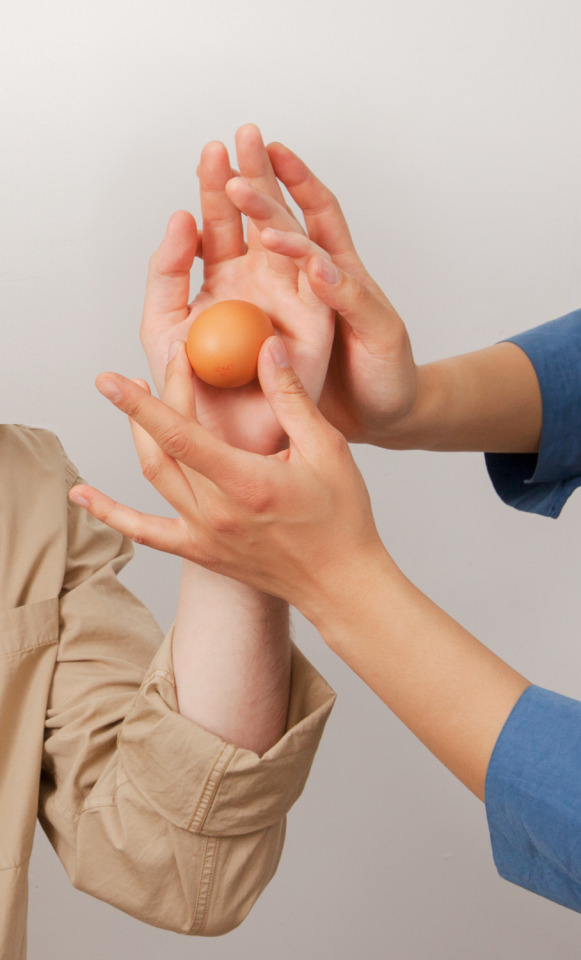
Francesca Tamse
FT: It goes back to the relationship of the uterus and the egg between mother and fetus. Strangely, hands fall into the same category as eggs iconographically. Together, contain power, graceful and spiritual as I hoped to portray in the image.
Egg rituals came into play while working on this subject. The spiritual and healing came into play with these masculine bodies, where I placed my subject into the performance of attempting to ‘heal’ rid of their ‘evils’. This project Spiritualised touches again on violence and bodies which was a reaction to violence and patriarchal systems that exist in society. I liked playing with the pseudoscience of egg rituals as well as poking fun at wellness industry (ahem- Goop’s jade egg); essentially one wants to heal and purify oneself so to speak and have the desire for self care.
Going back to your work, it seemed like such a valuable experience when we did that shoot together, photographing your pieces along the coast. That day felt very solemn, the day looked bleak, but I found it very comforting especially during that time period.
You went into the cold water by impulse, almost ritualistically with your pieces. What was that like for you? What I also enjoyed when photographing was thinking about the materials and components to make your ceramics in relation to the sand, the ocean, the fauna. The photo essay meditates on these feelings.
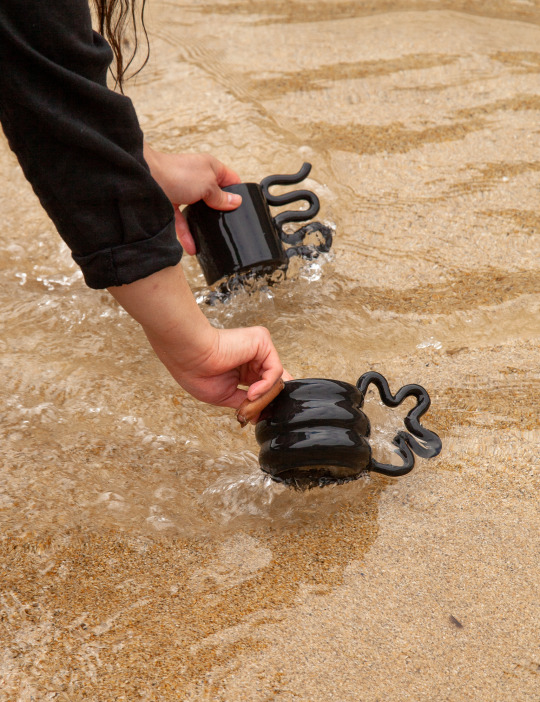
JK: Oh, yeah! The water was very cold, but exhilarating. There was an image from earlier in our shoot that reminded me of The Star tarot card, which depicts a person with one foot on land and another in a pool of water while pouring water onto both. As the cups were being washed over with the water and sand, it did have a hypnotic, rhythmic quality to it. The cups would momentarily be obscured by the oncoming current and reappear with a wet, glossy look. As the wave pulled back, gritty particles of sand fluidly washed over. Then the cycle would repeat.
My pieces felt at home at the shoot. I touched on this in the photo essay, but I’m attracted to liminal spaces, like eclipses and estuaries. Considering ceramics are the culmination of water and earth being blasted by heat that is nearly equivalent to a cremation, it reminds of this quote I love by Pat Barker:
“Cut a chrysalis open, and you will find a rotting caterpillar. What you will never find is that mythical creature, half caterpillar, half butterfly, a fit emblem of the human soul, for those whose cast of mind leads them to seek such emblems. No, the process of transformation consists almost entirely of decay.”
I also loved seeing the final stage of my work framed amongst the factored sum of its own materials. Yet there’s a quiet void that is not acknowledged, the unobservable time when the pieces are in its chrysalis kiln. Finding a living, changing space like a shore line felt like the perfect place for our photo essay.
Additionally, I also find it interesting how the sensation of being cold can be adjacent to pain. There’s a discomfort, a panic to relieve yourself from that feeling. While I was in the water, I found it curious that I was so focused, I didn’t even notice. Normally, I’m actually quite sensitive to the cold.
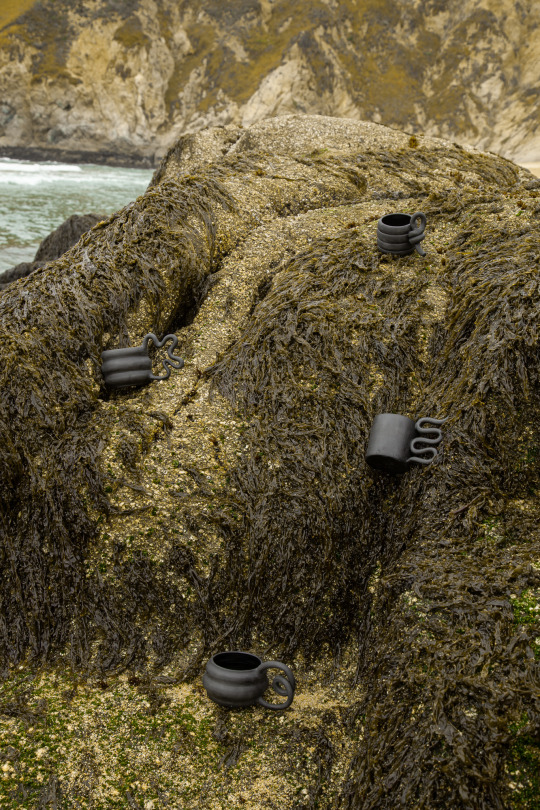
JK: I find that I forget about my own body while I’m working, despite the fact that I depict analogous representations of bodies and faces in sculpture or as vessels. How do you feel about your own body in relation to your work?
FT: With the exception of the latter image where my hands are actually in frame I feel that my body and gaze is implied in the work I make. I usually work with men and offer a prompt or brief to interpret.
I do find myself conscientious of directing their bodies into what may be a vulnerable state. I think there is an understanding in both parties that the work has an irony. That the objectification of the masculine body under a lens was and is dominated by its own gaze unto female bodies historically.
JK: It takes a lot of trust to create the space to make that happen. What do your briefs or prompts typically consist of?
FT: For Spiritualized, I prompted a performance artist, Charlie Ford to create movements that had him carry a sort of burden and weight to the egg. Here you have this object, you are trying to heal yourself of all these toxic events that have existed, almost a self flagellation. I prompted the atrocities of incel attacks as well as a time when a lot of celebrated men were being canceled for their abuse against women.
Separately, warm navel had a close artist friend of mine become comfortable with his own body and not be afraid to get messy around my photographing him. (There were a lot of broken eggs.)
JK: Your reference to egg healing reminds me of Santería—did you have traditions like that in your culture growing up?
FT: Yes, the early research was based on folk medicine and rituals. One in particular was the removal of disease through the navel done in the Philippines through a psychic surgery called “hilot”. Hilot, or massage in this context, refers to searching for disease or illness within a body. I remember the first time I saw this was in “Man On the Moon,”( with Jim Carey as Andy Kaufman) as a child. The depiction of the “witch doctor” performing a ritual onto Kaufman where they were pulling intestines and blood out of his navel, which I found shocking and fantastical.
I would later find out from my parents that this was a recorded hoax. It came out to be a hoax after many of these results ended up being false and took advantage of the vulnerable and those that came to that option as a last resort. It touches again on the wellness industry’s attempt to market what women should do to create mental, spiritual, or physical perfection for themselves. I find that there is a connection between how that controls female bodies to find some kind of solution to a “problem.” This advertising is created under a male gaze which still perpetuates and lingers in this world, while still using feminine bodies.
The egg symbolizes a lot of these thoughts. Images I create based on the egg concept embodies an experience where the spiritual and ritual is assumed to be a transformational healing result. It is a play on these ideas but also attempts to use the egg as an object to “heal” my relationship to the men in my life. Growing up, I’ve had instances where my race and gender were often magnified, being looked at, undermined and see as passive, silent, and sexualized.
Going back to the Pat Barker quote, to think about the in-between latent state of these lamentive pieces that could collapse or flourish in the kiln at any moment. But the pieces feel so alive, almost a memoriam. What do you hope your work communicates to viewers?
JK: My work can currently be categorized in two: my functional pottery and sculpture.
With my functional pottery, I enjoy experimenting with texture and form while maintaining a minimal, simple design style. By quietly focusing on igniting intimacy to everyday objects in the home, the act of nourishing ourselves can become a point of meditation.
Through my sculptural work, I hope to communicate a universal sentiment from the lens of my own personal narrative. There are different thematic elements that reappear such as the role that matriarchs serve in our lives. As a woman, how is this an inheritance that is unintentionally trained in us? How do we love, sacrifice, or survive?
As a Korean-American, I hope viewers can also understand and learn more about the immigrant experience and Korean culture and history. It is a way of connecting to my heritage while expounding on it as a gyopo, which refers to ethnic Koreans who permanently live outside of Korea. By culling elements of folk art, indigenous Korean shamanism, and relics, I hope to achieve a personally established codex that expresses my experience in contemporary environs.
We are still discovering ancient pottery, now monuments to a distant past. Some have survived over 25,000 years. I hope in my practice that my work can offer symbolic perspectives that feel of their time, but also reveal themselves as offerings beyond.

Jane Kang is a ceramicist living and working in San Francisco, California.
www.jane-kang.com www.kang-ceramics.com @kangceramics
Francesca Tamse is an artist and photographer in the San Francisco Bay Area. She received her Masters at the Royal College of Art, London, UK in Photography and BFA Photography at the School of Visual Arts in New York.
tamse.co francescatamse.com @francescatamse
0 notes
Text
16. Benz Amataya & Soumya Netrabile
Benz Amataya & Soumya Netrabile discuss their paths to and continued commitment to painting, how they think about getting outside feedback about the work, and their deep relationships to nature.

Benz Amataya (BA): Hi Soumya! I’m so happy to be collaborating with you on this project. I’ve been admiring your paintings on Instagram for a long time and now that I know that we live so close to each other, I can’t wait to see your paintings in real life. I’d like to start our conversation by talking about the practice of painting since we are both committed painters. Can you talk about how you’ve decided to become a painter and what keeps you going?
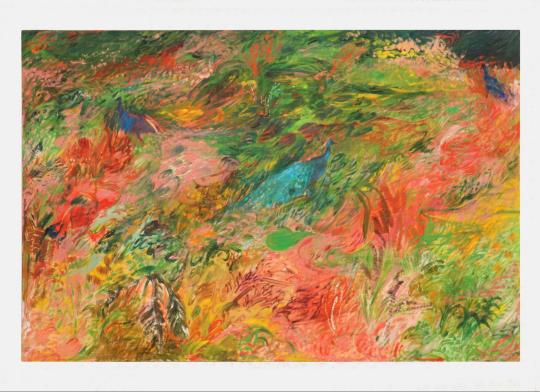
Soumya Netrabile, The Turning, 2021, oil on canvas, 24”x36”
Soumya Netrabile (SN): I’m so pleased to be doing this with you as well.
I love that you ask when I specifically decided to become a painter, and not when I started to identify as an artist. The question drew me back into my memories to pinpoint when I discovered the magic in painting, because it really came down to attraction. I definitely felt an intuitive call to the material. When I was 12, my Aunt Jayashree moved to NYC to begin a medical residency, and on Saturdays, she’d come hang out with us at my home in New Jersey. She and I quickly bonded, and on her suggestion, I soon began spending my weekends with her in the city. She used to come pick me up on Friday evenings to take me back to the city with her. She loved art and I think she saw me as a kindred companion who’d enjoy visiting museums and galleries. I credit her for giving me my first experience of art, painting and culture. She was always hungry to learn about painting and we’d spend hours looking at and talking about the works. I still vividly remember those very first paintings I saw and revisited frequently—they spoke to me in ways I could not articulate then, but I knew I was hooked. I was 13 when I got my first oil paints, and within just the first days of working with them pretty much sealed the deal. My first oil painting was a giant still life of a Lenox crystal bowl of lemons on my mother’s flower printed tablecloth. It was so crudely done and just a mess of pattern and color. Early in my journey it was about the thrill of being able to create an image with some colorful goop. Even when I started at SAIC, I was more keen on the image making aspect of it and this attitude severely limited me. I was really frustrated during most of my time at school. But during my last semester, I started painting more messily, and that’s when I realized that there was so much about paint that I had yet to explore.
BA: Thank you for sharing this! Such a beautiful story about your aunt. I started painting when I was 34 years old, quite a bit later than you, but I’m glad that the paint materials kept calling me and waited so patiently for me.
SN: You never know when that pull might happen! It’s great that you connected to it.
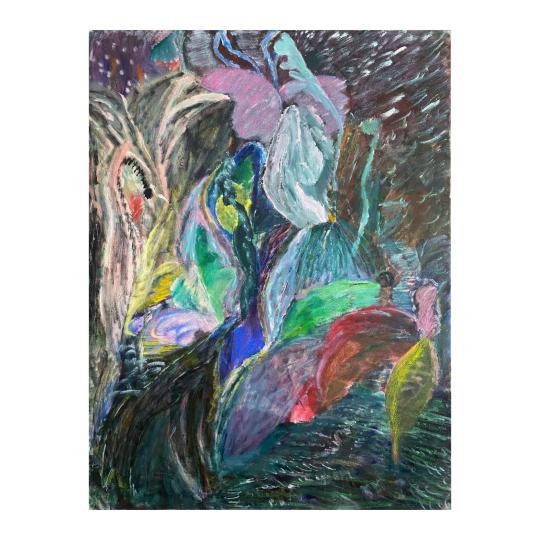
Benz Amataya, We are only scratching the surface here, 30”x40”, 2021
BA: I read one of your interviews where you mentioned that in art school a lot of your peers chose installation art or conceptual art believing that painting was dying, but you still chose to paint. It reminded me of my conversation with my mom a few weeks ago. My mom was asking me if I knew about NFT and digital art. She told me she heard that digital art will make painting obsolete. She was probably wondering how much longer I plan to be a painter :)
SN: I don’t know if I or my SAIC peers necessarily came in believing that painting was dying, but rather that was the message being relayed to us by certain teachers and also in articles we were reading in the current magazines. This was the mid 1990’s, where installation and time arts were starting to boom. Many artists were utilizing painting more as a component for some larger project. I remember going to a show where an artist had done portraits of friends eating certain foods and had that particular food item rotting on small shelves installed right below each work. So, you know, there were exhibitions like that going on. The school’s program was assertively pushing students to explore other mediums in addition to painting and I think students were basically joining the trend. I started art school a bit older than most of my peers, and went in with a stubborn attachment to learning as much as I could about painting. In retrospect, I probably should have explored some other areas, like ceramics, while I was there. I think it would have been good for me.
Do you believe that painting will eventually fade? I don’t think the craft of painting will ever die, but I wonder about how painting will be affected by digital technology. Because we’ve all become so attached to looking at everything on our phones, and navigating the world through a little screen. Our relationship to the materiality of paint is sure to change (it already has) with so many of us feeding ourselves on flat images. I recently met with MFA students at SAIC, and a couple students indicated that they don’t go to the museum as much as they should. They just use their phones to find an image.
BA: I have been noticing that in younger generations too. A while ago my boys (8 and 11) were asking me if I liked a “real” book more than a kindle. I said Yes. I love the touch and the smell of a real book. I love that real books don’t have to be powered by batteries or electricity. But I can also see some advantages of electronic books.
SN: I also prefer real books, but I do like using my tablet for reading and occasionally researching images online. I also use my tablet as a digital sketchbook while I’m traveling. Technology is great because it gives us new tools to add to our toolbox. But the worry I mentioned is also there. The further we step away from making a physical connection to the material object, meaning the painting, the more we lose touch with that kind of experience. There is a lot lost in a digital image–not just material information, but also spatial, color and light sensations that are triggered in our brains only when we stand in front of a painting. Much of my recent practice is concerned about engaging the gaze. In the last two years, especially during my time in the woods, I’ve been trying to look at what’s around me with a certain internal concentration–like with all my senses engaged–and I try to bring these sensations I experience back into the paintings.
BA: That makes so much sense. I can totally feel that heightened awareness in your painting. I do think that eventually the way the audience receives art will change. But I believe painters will keep painting, ceramicists will keep making ceramics, photographers will keep taking photographs for as long as we can because we know the magic we are receiving from the process of making. Personally, I’m not concerned about the future of painting because I think of painting as a process rather than a product and a process is much less affected by the market than a product.
I believe painting (and every form of art) exists primarily to help artists transform. If artists don’t lose sight of this, the art they create will be the most powerful and transformational for both themselves and the audiences.
SN: Can you clarify what you mean about how painting helps artists transform?
BA: Thank you for asking this question. The transformative quality of art is one of my most favorite things to talk about. I had struggled for many years trying to make art to please myself and other people, not realizing that art was there primarily to heal and change me. I’ve always had a strong urge to create, but for many years I let my expectations get in the way and my art making didn’t go anywhere. I tried almost everything, drawing, printmaking, photography, even painting, but I wasn’t able to create art that could satisfy me, and I gave up. When I found a small experimental art studio in Evanston, IL everything changed for me. At that studio I was encouraged to create anything I wanted while the studio facilitator reassured me that I didn’t have to think about the result or how people would receive it. It was one of the most liberating experiences in my life. I didn’t know it at the time, but I really needed that safe space. I needed that gentle permission to connect with the deeper parts of myself and release everything else.
To put it simply, making art this way transformed me because it taught me to free myself from expectations and connect with the parts of myself that I didn’t know how to connect with before. When I’m connected with this energy, a lot of great things happen; questions, breakthroughs, insights. I still paint this way to this day. When I paint I don’t think too much, if at all, about how it will be received by others.
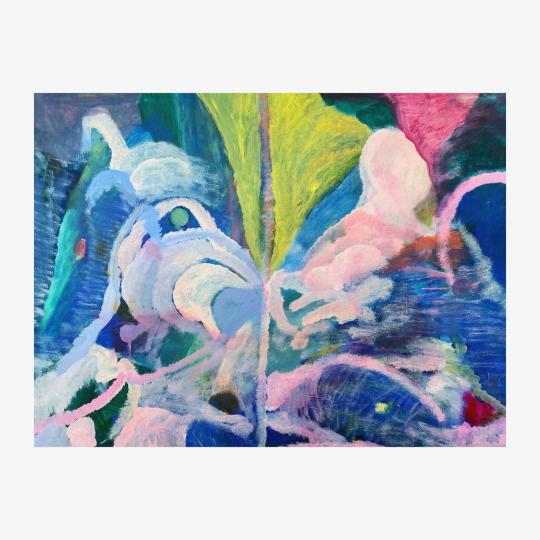
Benz Amataya, Do we have to choose, 36”x48”, 2021
SN: I enjoy that painting creates questions when I am completely immersed and present in the act of it. It happens to me while I’m engaged in playing with the substances and the tools that I need to create a painting. I like exploring paint’s qualities in terms of viscosity, translucency, stickiness, crustiness, etc… The tools are the elements that help bring me into a more nuanced experience of the craft. Using them, and learning as much about them as I can helps me understand them, my relationship to them and the craft. This is an important consideration in my practice. When I think of painting as a transformative experience, I think of it in terms of the engagement with the tools, and that it is the tools that connect the physical and psychological me to the painting. It strikes me as funny that this engagement is tied to a certain detachment.
It took me a while to understand and accept that what I do in the studio is really only relevant to me and that I have no control whether it might be relevant to anybody else. It was quite liberating when I realized this, but it’s a nice gift when someone responds to what I’m making. I guess I make art because I just live with this monstrous urge to do it. Painting is also the most comfortable way for me to communicate with the world. I’ve always felt awkward at expressing myself verbally. My parents told me that for the first two years of my life I didn’t really speak more than one or two-word phrases, so maybe I was meant to communicate through visual art?
BA: I can relate to that. As an immigrant and a non-native English speaker, I’ve always felt that I communicate better through paint than words. I also understand what it feels like to carry that monstrous creative urge. For the first few years of my art making, I really created just to let out the suppressed urges that I have been carrying for 30+ years. I wasn’t looking for any feedback at the time.
SN: But how do you feel about feedback? It’s nice to get it once in a while to kind of keep yourself moving. It’s tricky to navigate, though, because there are nuances to it. Like, social media emoji feedback is pleasant, but it’s like eating lettuce. Feedback from someone you deeply respect is a gift from god and can totally motivate and energize you.
BA: I have mixed feelings about feedback. I started my art career thanks to the practice that shielded me from all forms of criticism. I still love being in that safe space. I feel like I create my best work when the fear of being judged is removed. But as I’m growing in my practice, I also appreciate feedback. I like hearing how people connect with my work and the questions that my work brings forth for them. I would say I’m getting better at listening to others while remaining true to my values and not forgetting why I started painting in the first place. For the most part, my work is driven from within and I’d like to keep it this way for as long as I can.
SN: It seems you come to painting through a deep emotional place. Which makes sense as I look at your work. There’s a raw tenderness and honesty to it, especially in how you lay down your paint.
BA: Thank you so much. Honesty is key in my work. I love that you picked that up.
Here is my last question for you. I really admire how deeply connected you are with nature. It seems to me that nature is the entry point that connects you with something greater than yourself. Can you tell me more about your relationship with nature both in your art practice and in your everyday life?
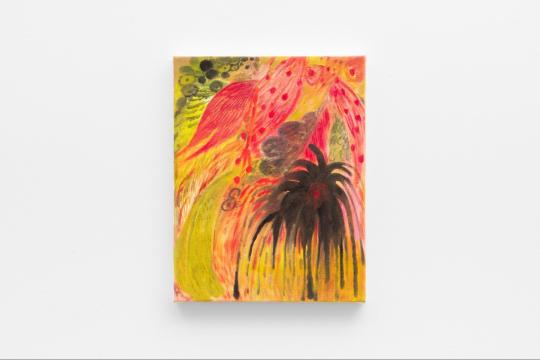
Soumya Netrabile, The Spell, 2021, oil on canvas, 11”x14”
SN: I grew up in the middle of Mumbai, as far away from any natural beauty as you can get, so sometimes I find it odd that I have connected so deeply to nature. Most of my interactions in nature have been short sojourns, but they occurred regularly since I was a young child. The longest I’ve ever immersed myself in nature is during a three week hiking trip through the northeastern states. I’ve never lived in a wild place. For most of my life I took for granted even these short experiences in terms of artmaking. It was only 7 years ago, after I decided to quit working and get back to art full-time, that I began to see certain forms and compositional quirks keep emerging in the work. I started to question their origin and that’s when I realized that perhaps those many years spent hiking, backpacking, climbing were subconsciously embedded inside me. At that point, I began to consciously engage with the natural world on each subsequent trip. I started regularly keeping a sketchbook on those trips, something I had really not done before, if you can believe it! I started to take notes about light, color and forms, the quality of atmosphere, how the air tasted, how objects in the environment felt. Every time I came back from a hiking trip, I’d consolidate the notes and sketches, and sometimes make a book of monoprints to remember certain terrain and earth formations. I did all this just to build some conscious memory, not really for use as source material in the studio (although that has begun to happen more recently). Like you, I try not to think when I paint, I just go with instinct and urge. During this time of consciously engaging with the natural environments, my father’s health was deteriorating rapidly, which made me more aware of how precious memory is. I suppose all the note taking was just my way of reinforcing those trips into my head and heart. Since late 2019, with my hiking trips halted due to pandemic travel restrictions, my main source of nature became the forest near my home. I began to include a couple miles of forest into my daily walks and started recording the experiences with note taking, just as I did on the long trekking trips. This daily conscious interaction had a profound effect, especially in the studio. When I now paint, I try to recall the energy I feel in the forest. I try to engage memory of not just what I saw, but also sensations I feel in the space. The forest has become sort of a catalyst that releases memories and imagination. This is basically how I start painting now and it’s the process origin for all the newer work. The paintings, soon after they’re started, develop their own momentum, and I just ride that wave until I feel like I need to move on. Being in nature has changed my practice to become much more practical and experiential. This feels honest to me.
BA: I look forward to meeting with you in person and hiking in the forest with you sometime! I feel like I’m still early in my relationship with nature. I grew up in the middle of Bangkok with not much access to greenspace. I did have a beautiful backyard and my school was nested in nature so I have fond memories of popping ruellia pods in the water, eating native fruits straight from the trees, and reading under a big tall tree. After I grew out of my childhood, I sort of took nature for granted and lost my relationship with nature. It wasn’t until these last few years that I started practicing mindfulness meditation regularly that I started to really understand the interconnectedness of all things and how generous mother nature has been to us. We as a species have so much work to do. I love how you mentioned that you consciously engaged with nature and then brought that energy into the studio. I can totally sense the depth, the mystery, the beauty, and sometimes even pain in all of your paintings.
SN: The mechanics of meditation have always fascinated me, and there’s so much about how it actually works that is still a mystery. Intrinsic to the practice I believe is a certain investment of faith. In this way, I feel it is very similar to making art alone in the studio every day and also to the act of painting.
BA: This has been really great, Soumya. Thank you again for taking the time to have this conversation with me.
SN: I’m so glad to have had the opportunity to chat with you. Thank you so much, Benz!

Sirimas Benz Amatayakul (b. Bangkok, Thailand) is a painter, mindfulness meditation teacher, and community builder currently based in Oak Park, IL.
Benz received a Master’s Degree in Integrated Communications from Medill School of Journalism, Northwestern University in 2007 and a Certification in Expressive Art Facilitation from Open Studio Project in 2015. She received Mindfulness Training from Magnolia Grove Monastery, in the lineage of Thich Nhat Hanh in 2020. She currently practices Thai Vipassana Meditation with the The Young Buddhists Association of Thailand.
Benz is a founder of Dear Artists Project, a platform with a mission to create more dialogues around mental health in the art community and provide mental health resources and support for artists. Dear Artists Project facilitates online artist residency called Dear Artists With Anxiety and offers online classes throughout the year to help artists become mentally healthy and holistically well.
www.amatayastudio.com @amatayastudio
Soumya Netrabile was born in Bangalore, India and emigrated to the U.S. with her parents when she was 7 years old. She first studied at Rutgers University, College of Engineering and then later at the School of the Art Institute of Chicago. Playing with different painting techniques, she explores relationships between the body, terrain, and the natural world. Recently her work has been leading into meditations on the ecosystems of the forest and garden. She has most recently shown work at Andrew Rafacz Gallery in Chicago, Part 2 Gallery and Anat Ebgi Gallery in California, and Karma Gallery in NYC. Her work is included in national and international collections.
soumyanetrabile.com @netrabile
1 note
·
View note
Text
15. Furen Dai & Julia Kwon
Furen Dai and Julia Kwon discuss their recent projects and how they challenge ideas of racial and aesthetic categorization. They also speak about the erasure and devaluation of labor, especially the labor of marginalized individuals.

Julia Kwon (JK): It’s a huge pleasure to be in conversation with you. I have always appreciated your friendship and criticality towards artmaking throughout the years ever since meeting you in grad school.
Furen Dai (FD): I always enjoy sitting down to spend time with you. Thank you for inviting me to have this conversation. I would love to learn about your newest project.
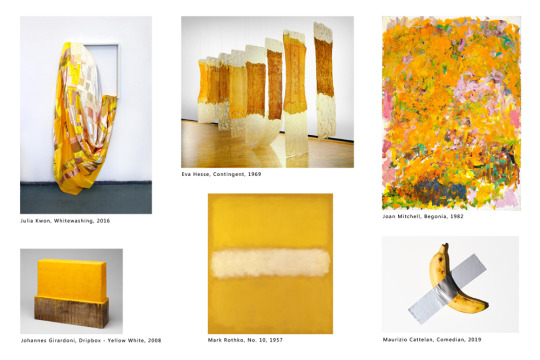
Julia Kwon, Exultant Divergence, 2021, digital photo collage
JK: I have been working on a digital photo collage series titled Exultant Divergence where I curate my own work alongside the various works from contemporary art and art history. Inspired by Alpesh Kantilal Patel's deliberate 'productive failure' to write new transnational art histories as well as Édouard Glissant's notions on opacity, creolization, and rhizomatic identity, I intentionally confound expectations and make connections between my work to the works of various artists, including those who are not Korean, women, textile artists, or artists investigating identity through their work.
The project argues for the multiple histories of art that are constantly in flux. I present alternative ways of understanding my work to encourage viewers to make expansive recontextualizations of the work especially beyond the fixed and often essentializing lens of genealogy. I am interested in challenging existing power dynamics, categorizations, and the canon of art history as well as considering what it means to create transnational art histories.
I know that you are also interested in challenging institutional frameworks and systems of categorization especially in the context of art museums. Can you discuss how you do that through your recent project?
FD: Your new project prompts me to ask these questions: Can art history be transnational? Will the reception be the same when we share our history in different cultures? How can we translate a history from one culture to another?
In my recent body of work, I am looking at the racial categorizations in the United States and the museum categorization within encyclopedia museums. I started this project in the year 2019 when I was aware of the discussion around the questions included in the census form. After looking at all the census forms since 1790, I became aware of how language has changed and adapted to the times, and that a lot of words have already lost their function and have been preserved on paper. One question in the census form really stood out to me: what is the color of the person / what is the race of the person? I started to question who brought up the idea of race and who sets the definition of different racial categories. Then I started to see the aesthetics for beauty that underlies the racial theory and how those standards are being adapted in art history.
When I started to see a clear parallel between the racial theory and the aesthetics for beauty in art museums, I started to ask: where did the value of the art come from? Who and what contributes to the value of the work? All the invisible laborers in the museum space emerged, and I started to shift my attention to the pedestal and create work in various mediums that documents numerous pedestals I encounter in museums. I am currently working on a 3D rendered video work that is based on a ruin of a museum to question what the future of the encyclopedia museum looks like and whether we still need to keep this form of display of histories.
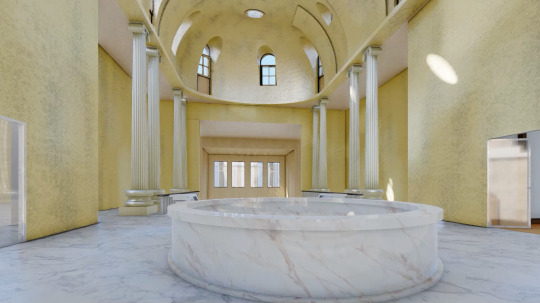
Furen Dai, On the Future Ruin, 2021, 3D rendered digital video, 8 mins 12 sec
JK: It’s so illuminating to hear your thought process. I really appreciate that you discuss the devaluation of labor and especially the labor of contemporary artists and art workers that often goes unseen or unacknowledged.
FD: Emerging artists are often wearing multiple hats and juggling different roles. It’s challenging but sometimes it’s also beneficial because it pushes us to perceive art from different angles. We get to look at the existing system from both within and afar.
JK: Your project leads me to think about the various work by artists that often goes underrecognized whether it is reading, writing, ideation, museum visits, studio visits, administrative work, teaching, or any other work completed within different institutions. There are so many activities that are necessary for sustaining a generative, creative environment but may never get actualized into an art object.
FD: Yes, just think about the amount of time we put into applications and proposals, and all of our unrealized ideas. I remember having a brief conversation with a person who walked by my studio. She saw the pedestal drawings and told me the story of her father who used to be a fabricator and built pedestals for museums. He had spent so much time on this one pedestal but when it was delivered to the museum it was mishandled and got damaged right away. He was rightfully upset and asked why they couldn’t treat his work with the same amount of care given to an artwork. This story led me back to my examination on what contributes to the value of art.
JK: Wow, exactly. I also think about the additional emotional and psychological labor that those from marginalized communities are forced to take on. With the recent rise in anti-AAPI hate during the pandemic, I experienced needing to put in a lot more energy to complete basic tasks and usual amounts of work while trying to counterbalance the weight of racism and structural inequalities. Individual and collective trauma felt from systemic oppression is an overwhelming burden, yet I have also found great support, camaraderie, and solidarity from and for so many others across diverse communities.
FD: Yes, I think these two years also provided us with a chance to pause, slow down, and think about what is truly valuable to us. People and artworks typically travel around the world. Once all the channels had been cut off, we started to ask: what can we do during the time of physical isolation in our homes? What are other possibilities for museums? How can we engage with museums and their collections when we do not have tangible access to the museums’ architectures and artworks?
JK: The limitations on our experience of the site and the physicality of artworks seem to have further emphasized the power of revolutionary ideas and intent, including being mindful of the impact that the engagement will have on the community that it serves. Your work encourages me to imagine a more inclusive and just future by asking questions on many important issues within the art world.
FD: I know that your work also considers the issue of labor. Can you share a bit more about your larger body of textile work that you feature in Exultant Divergence and how the two projects may be related?
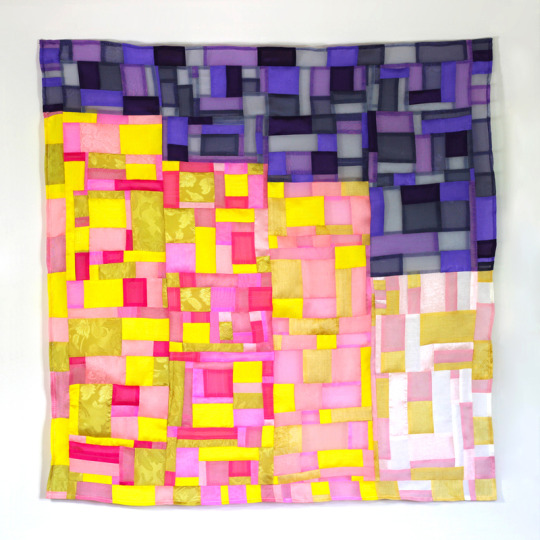
Julia Kwon, AAPI Hate Affects AAPI Mental Health (71.7% of the respondents who experienced hate incidents during the pandemic report anti-Asian discrimination to be their greatest source of stress, much higher than any other pandemic concerns), 2021, Korean silk, sewn in the format of bojagi
JK: I have been creating interpretive Korean textiles in the format of object-wrapping cloth called bojagi to talk about othering experiences as a Korean American woman living in the States. I employ bojagi, which was historically created by women who had limited contact with the outside world since the early Joseon Dynasty (1392–1910), to consider ideas such as tradition, craft, and feminized labor. I sew enlarged Korean object-wrapping cloths to wrap the figures like objects to discuss the objectification of Asianic female bodies.
I also disrupt the textiles in different ways through creating physical ruptures as well as embedding patterns found in contemporary issues. So, although the bojagi may have an aura of authenticity at first glance, the work contests the notion of cultural purity through the inclusion of various data, maps, charts, and graphs from current sociopolitical events. I aim to challenge the notion of authenticity and discuss the complexities of constructing identity within the context of globalism, capitalism, cultural hybridity, intersectionality, and the collective struggle for social justice.
I focus on exposing and challenging people’s preconceptions based on my gender and ethnicity in hopes that each and everyone of us may be seen as multifaceted, full human beings. The digital photo collage series shares the same aim as my textile work but more specifically discusses how works created by artists from marginalized communities should be included in multiple art histories and understood beyond the lens of genealogy. Exultant Divergence is political not only because I insert myself into the canon of art history as an emerging woman artist of color, but also because I invite everyone to actively partake in art and art history making. I believe that everyone should feel empowered to make their own interpretations of art using their unique set of knowledge and experiences.
FD: Is this an ongoing project for you? Will you be adding more collages to the series every time you create a new work? Are you creating your own archive through this project?
JK: It takes a while to make unexpected connections, compile images, and design the layout of the pieces but I am interested in continuing the project moving forward. By curating and recording my work and the various connections that I make to other artists’ work, I am definitely creating an archive for myself, which is extremely valuable and empowering. More importantly, I want the project to serve as an example to show what is possible for everyone—we do not have to solely rely on the dominant narrative but rather can create multiple art histories based on our own perspectives and experiences.
I believe, as artists, it isn’t difficult for us to envision a different world because we are constantly worldbuilding. We are able to take on different roles through our work to challenge existing systems and structures. I am grateful to you and so many others who continue to use artmaking as a revolutionary tool to help us imagine a better future for all.
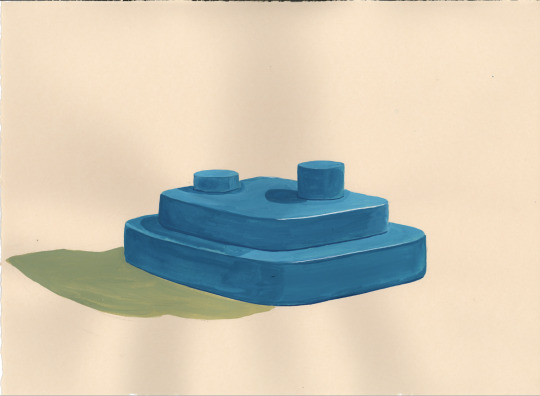
Furen Dai, Museum Pedestal, 2021, Gouache on BFK Rives Printmaking Paper, 11”x13”

Furen Dai is an artist based in Boston and New York. She has presented her work at the National Art Center, Tokyo; Athens Digital Arts Festival, Greece; Art OMI, and Edinburgh Artists’ Moving Image Festival, Scotland, amongst others. She has participated in residencies including International Studio and Curatorial Programs (ISCP), Art OMI, NARS Foundation. She received public art commission from The Art Newspaper for Frieze Art Fair 2019 and Rose Kennedy Greenway in 2020. She is the recipient of The Milton and Sally Avery Arts Foundation Fellowship (2017).
www.furendai.com @furendai
Julia Kwon is an interdisciplinary artist whose work comments on the objectification of Asiatic female bodies, challenges the notion of authenticity, and examines the complexities of constructing identities within the context of globalism, cultural hybridity, intersectionality, and the collective struggle for social justice. Her work is in the permanent collection of Smithsonian American Art Museum and Renwick Gallery (Washington, DC), Cooper Hewitt, Smithsonian Design Museum (New York, NY), Museum of International Folk Art (Santa Fe, NM), and The New York Public Library (New York, NY).
www.juliakwon.com @artistjuliakwon
0 notes
Text
11. Paolo Arao & Alex Paik
Paolo Arao & Alex Paik discuss Paolo’s work and his relationship to abstraction, classical music, and color.

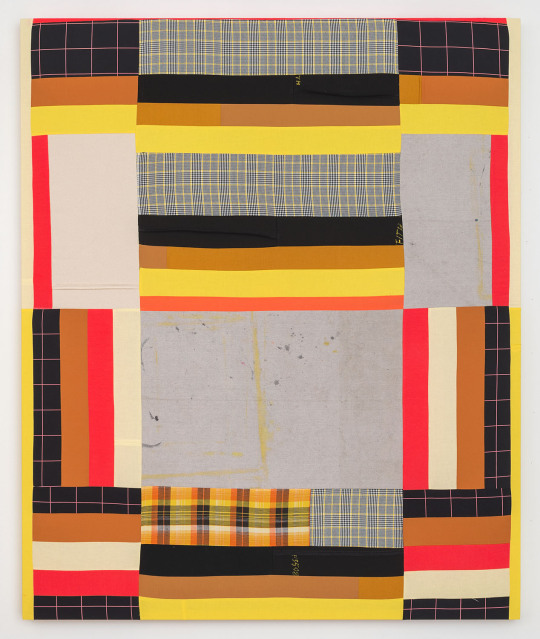
Paolo Arao, Divisoria, 2020, sewn cotton, acrylic, canvas, hand woven fibers, felt, denim, 54 x 45 x 1.5 inches. photo: Cary Whittier
Alex Paik (AP): I’ve admired your work for such a long time, it’s great to be able to talk to you about it! I see your work not so much as expanding the language of the traditions of Euro-American painting but more that it’s coming from the traditions of improvisational quiltmaking like the Gee’s Bend quilts or Korean bojagi. How do you think about your relationship to painting?
Paolo Arao (PA): I’m happy that we’re able to have this dialogue, as I’ve admired your work as well! I appreciate your thoughtful observations about my work, and all that you’ve mentioned is true. When it comes to painting, I’m pretty restless. My relationship to painting is always shifting.
AP: A related question: how do you think about your relationship to abstraction? What traditions of abstraction do you see your work coming from?
PA: Great question! Early on in my practice I was making figurative graphite and charcoal drawings and it eventually felt limiting (partly because of the explicitly queer content/imagery as well as the lack of color.) I wanted to return to making paintings. Abstraction presented an opportunity to create work that was more open to layered interpretations and also to revisit color again. While my current work is rooted in geometric abstraction, I’m still continuing to address the queer content as well as my Filipino heritage through textile-based processes. Working with textiles, I’ve been able to interweave my interests in color, labor, materiality and identity. Aesthetically, my work is in conversation with (and against) Modernism, the Bauhaus, Hard Edge and Color Field Painting, Pattern + Decoration, and Op Art.
AP: I would love to hear your thoughts on how you see your practice as working against those traditions you just mentioned.
PA: I think of my work as mending these histories of Hard Edge, Color Field and Op Art traditions through the use of textiles. My deliberate decision to use fabric in lieu of paint, softens the rigidity inherent in these traditions.
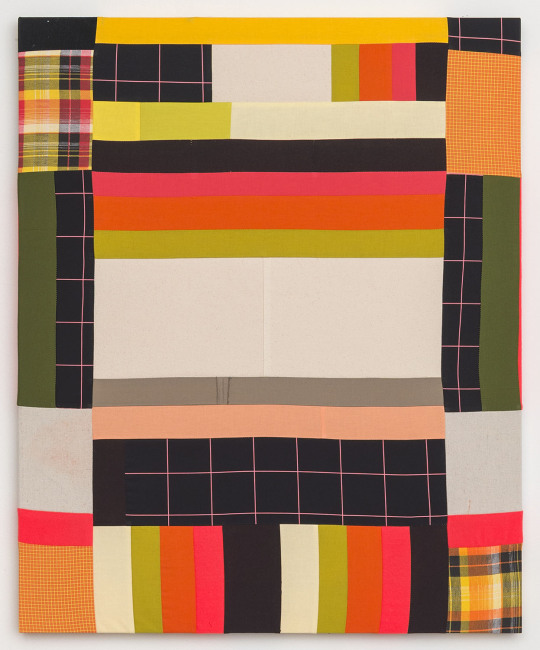
Paolo Arao, Graphic Score, 2020, Sewn cotton, canvas, acrylic, felt, denim, nylon, 33 x 27 x 1.25 inches. Photo: Cary Whittier
AP: How are these works composed? Are they planned out in advance or do the pieces grow somewhat improvisationally as one shape is attached to the next?
PA: I often work in series and I prefer taking varied approaches with each new body of work. I like to think of the studio as a laboratory where I can test various solutions to the questions that I’m posing. I keep a sketchbook for rough ideas and to map out composition or color relationships. Sometimes my paintings are the result of composites from those sketches. At the same time, I like to work in a space of inquisitive experimentation, leaving room for discovery. What the work is “about” and what it “means” comes belatedly – usually after I’ve had some time to reflect on the pieces.
AP: How do you think about color and color relationships in your work?
PA: Before I studied painting in art school, I was a classical pianist. I started playing the piano at a very early age and I was accepted to Virginia Commonwealth University as a music performance and composition major. To this day, music still plays an important role in how I think about and work with color and composition. Sometimes, I’ll begin a new painting by sewing strips of color together to create a chord of color, establishing the “key” of the piece. The way I compose a painting establishes its structure and rhythm. It’s both classical and jazz improvisation.
AP: I also studied classical violin as a kid so I like you I feel like the qualities/attributes of music influenced my eventual visual language. During the past year I’ve been really drawn to solo piano music and have been working through some of the easier Philip Glass Etudes. Do you know those works? There is a clarity about the structure and the color relationships that I can see you being drawn to.
PA: We should start a chamber music ensemble! I always wanted to play the violin, but the piano was my first love. I am a fan of Philip Glass and the Etudes you mentioned are wonderful. I often listen to his music when I’m working in the studio. The rhythmic syncopation and repetition in his work is captivating. These are qualities that have definitely shaped my visual aesthetic.
Color is both material and content and it is vital to my work. My relationship to color is not passive. It is political, it’s personal, it’s emotional, it is felt and it is in my very being.
AP: Can you expand on this? In particular, how do you feel your relationship to color is political?
PA: Politics is synonymous with power. Color is both expansive and powerful. My color choices aren’t always purely aesthetic. I’m also interested in the social and political implications that can be alluded to through a specific use of color and/or chromatic relationships. The behavior of a certain color and its capacity to transform, enhance, or subdue other colors in a given context continually fascinates me.
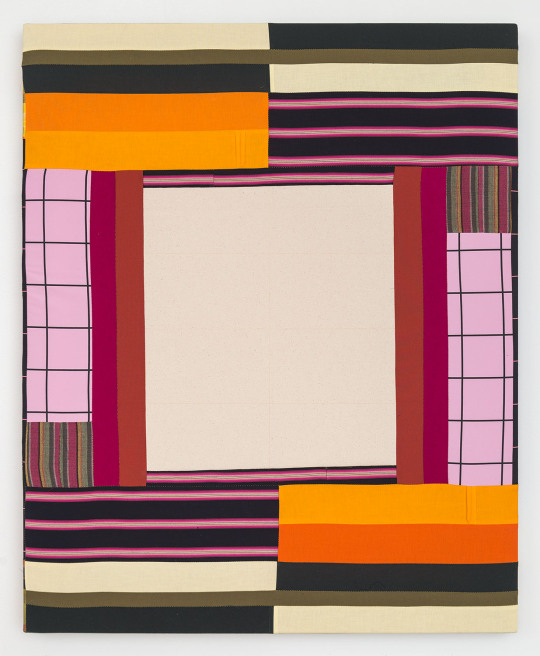
Paolo Arao, Natural Rhythm, 2020, sewn cotton, handwoven fibers, canvas, colored pencil, 33 x 27 x 1.5 inches

Paolo Arao (b. Manila, Philippines) is a Brooklyn-based, Filipino-American artist working with textiles. He received his BFA from Virginia Commonwealth University and attended the Skowhegan School of Painting and Sculpture. Arao has shown his work widely and has presented solo exhibitions at David B. Smith Gallery (Denver). Western Exhibitions (Chicago), Jeff Bailey Gallery and Morgan Lehman Gallery (NYC.)
Residencies include: Bemis Center for Contemporary Arts, The Museum of Arts and Design (NYC), the Millay Colony, the Studios at MASS MoCA, Vermont Studio Center, Lower East Side Printshop Keyholder Residency, NARS Foundation, Wassaic Project, BRIC Workspace, and the Fire Island Artist Residency. He is a recipient of an Artist Fellowship from The New York Foundation for the Arts. Arao’s work has been published in New American Paintings, Maake Magazine, Artmaze, Dovetail and Esopus. His solo exhibition “In Dialogue with Drawing” is on view at The Columbus Museum (Georgia) through August 8th.
www.paoloarao.com @paolo_arao
Alex Paik is an artist living and working in Los Angeles. His modular, paper-based wall installations explore perception, interdependence, and improvisation within structure while engaging with the complexities of social dynamics. He has exhibited in the U.S. and internationally, with notable solo projects at Praxis New York, Art on Paper 2016, and Gallery Joe. His work has also been featured in group exhibitions at BravinLee Projects, Lesley Heller Workspace, and MONO Practice, among others.
Paik is Founder and Director of Tiger Strikes Asteroid, a non-profit network of artist-run spaces and serves on the Advisory Board at Trestle Gallery, where he formerly worked as Gallery Director.
www.alexpaik.com @alexpaik
1 note
·
View note
Text
7. Valery Jung Estabrook & Corey Escoto
Valery Jung Estabrook and Corey Escoto discuss their use of humor in their work to reveal uncomfortable truths, where they find joy in their lives, growing up/living in rural America, and navigating internal and external pressures to make identity-based art.

Valery Jung Estabrook (VJE): So I guess I’ll start off by saying that I’ve been thinking about your recent paintings, and how you deal with death and fear in your work. Because these are such universal subjects, I find it challenging to make work about them in a way that doesn’t feel redundant. I’ve noticed that we both use humor, which makes difficult topics easier to swallow, manage, approach. The challenge for me is trying to find the right amount of “joke” when talking about really serious things, like death, trauma, etc. Do you struggle at all with finding a good balance between darkness and humor? There’s definitely a confidence in your execution, especially in your paintings - does striking that balance come naturally to you or if you find yourself going back and forth on if an idea is too disturbing/not serious enough?
Another topic I’ve been thinking a lot about is capitalism, currency, and how we decide what things/people have value. It’s been on my mind for a few years, but 2020 made it a topic that I couldn’t turn away from - both from seeing the obvious fatal consequences of wealth inequality, but also at home managing my wavering personal finances. [I think] I hold some very anticapitalist values for an American, but also struggle with functioning in a currency-based system where basic necessities are things that need to be purchased. (Certainly there are ways to consume less, buy less, and be more “off the grid” but it could also be argued that being able to transcend consumerism is a kind of privileged existence, and requires money anyway.) Meanwhile I also feel that capitalism is diametrically opposed to the purpose of art, yet a huge aspect of our being able to have an art practice is dictated by access to financial resources. Could you talk a little bit about your thoughts on capitalism and wealth? What’s your relationship with money?
Corey Escoto (CE): Let me say first, thanks for getting us moving forward on this discussion, as well as asking me (also thank you Alex) to be involved in this dialogue. I find it supremely important as a document of the ideas of our time as well as a chance to organize my own thoughts. Unfortunately, as with so many complicated human dilemmas, I’m not so sure I have very many, if any, answers, but I hope what I’m feeling is accurately expressed and felt by others, and with that knowledge hopefully some solidarity is found.
I think the idea of recording this exchange sprouts from an impromptu studio visit where I was somewhat excited-nervous (but really more nervous and completely un-confident) in showing you and talk truthfully about this new work that I haven’t really shared with anyone yet. My memory of that visit is marked by a passionate expressing (verbally) of my deep disappointment over and over in various way, with various systems, contradictions, actual people in my life (that reflect a broader political pattern), as well as uncertainty in my own position in a way. It is a bit atypical for me to have been on such as roll as that evening that you stopped by. Perhaps this uncertainty also manifests itself on multiple levels, uncertainty in what this work is about exactly, or not wanting to believe that I was making work that pointed toward or reflected institutions and ideas that were so flimsy and meaningless to me.
I felt like I didn’t really have anything positive to say, and perhaps I felt close enough in your presence to let it all out and in the process acknowledge to myself where the ideas were coming from.
You reference the ideas of capitalism, currency, death, and tone, in your thoughtful opening to this correspondence and I think it's important to get back to the details of the conversation for the sake of building a context and grounding the ideas in lived experience. One of my deepest disappointments expressed during the conversation was the idea of “Life, Health, and Death vs. All Things Capitalism.” The dissonance between the feelings brought forth from death and uncertainty during a global health crisis, coupled with my feeling that not since 2008 have I heard so many people so excited and talking about the stock market. At the particular moment of the studio visit, I think only medical professionals and the like are being vaccinated, so the threat and continued fear of the virus is still very much very real, and in a year mostly without sports I found it alarming to observe that discussions about stocks, cryptocurrency, and investments, had displaced talk about sports, or movies, or even the weather. Even people that had never expressed any interest in such financial subjects, were suddenly everywhere and seemingly unavoidable. I just couldn’t care to hold the two simultaneous realities in my mind, or rather it felt so disrespectful to the dead and dying and immoral in a kind of way. I think maybe from a further distance now, maybe I took this observation of capitalistic euphoria, from a political level of “reopening the economy at any cost”, as well as at a personal level -- seeing friends enthusiastic embrace and follow in the ways of the “Church of Capitalism” (as I came to call it) a personal affront in a way. Having had a very tough battle with the virus myself, and having lost two grandparents, having rode my bike past trailers filled with bodies, and having walked beautifully empty streets, watching those with means flee the city, and having tearfully cried “say her name” until the words were only a sound, and recognizing the magnitude of these times unfolding, I suppose I wasn’t all that interested in Gamestop. So it is fitting or ironic that these works are exactly a reflection of this, a leaning into this tension -- abstracted repetitions of gravestones, a swampy landscape, “Big Debt Energy,”a big clock, “tax man”, “das Kapital”, “das Racist.”
On tone and humor, Yes, for me that is so so so so important. Your question is so well thought out it’s sort of an answer in itself. Yes, as you clearly know, its very difficult to feel like you strike the right balance, but especially these days where people are so quick to be offended. Humor is definitely a very effective strategy that is not without risk in terms of aligning your message and your intention. I am always worried that the audience is going to lightly “get the joke” and then not think any deeper. My other worry is that I will make work that people don’t want to see. Maybe too truthful. I go to art fairs or galleries in the city and they are filled with works that are such art-fashion objects, so empty feeling to me. We might as well have Pantone telling us what color paintings they want to see this year. Sometimes I wonder if these artists and arts professionals are living in the same world as I am? So I suppose humor helps me create work and not entirely abandon my audience. I think that humor is closely aligned with truth. It’s wonderful that you can tell a humorous fabrication of a statement and land in a very truthful territory. When someone laughs at a joke, it is a subconscious recognition of something truthful. That’s why comedians are so valuable and so good at getting to the heart of a matter so efficiently. I just watched a tv segment of Jon Stewart on Tucker Carlson’s CNN show Crossfire, from 2004. It is so revealing, so sad, and so truthful. I laughed and cried watching it, and who is there to deliver truthful hints of the future but Jon Stewart. As an artist you are putting images and things into the world and they are messages in bottles in a way. I feel like the calculus that goes into creating a work is quite complicated and thus a result in complex outcomes. A climate of hyper political correctness probably runs counter to good art in my mind. It tends to be moored down in diametrical oppositions, and produces a sort of intellectual fear climate. I do my best to retain some independence of thought, questioning everything, all sides, and imagine perspectives outside of our own.
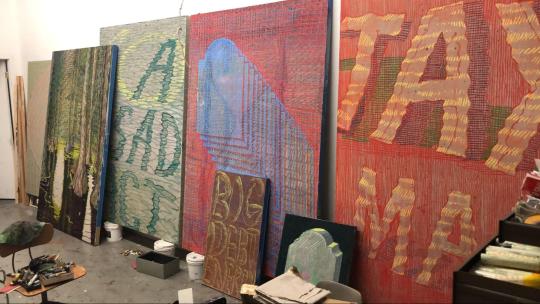
View of Corey’s studio where the conversation began
CE: One thing I love about your work is how well you utilize the tools of capitalism against itself. You make really fantastic satirical sales videos, branding, and seductive display. It’s simultaneously high concept and accessible at the same time. I’m curious to hear your thoughts about how you approach the accessibility of your work.
Addressing your question on Money: I think it’s funny how we are taught in many ways to not talk about money generally. I think we all aspire to hold equal footing on the idealized “level playing field.” But of course this is never true, and being a little better off income wise and running the risk of being out of touch with common person problems, or being poorer and playing catch up, upsets the collective desire for some kind of happy equilibrium. This widely held and well-intentioned desire to inhabit this equal stature reminds me of the flawed concept of race-blindness. While in the last 4 years so much has regressed in terms of race relations, I feel as though the fight, is more rooted now in class and economics, and helping people to understand that, and clearly see their place in it all.
Personally with respect to money, I feel so wrapped up in contradictions with an inability to see a way out of the contradictions. Poor guy making money doing a job that you don’t care about, in order to pay an apartment and studio rent, while selling bronzes and drawing/paintings to rich people that you kind of hate on some level, happy to break even, hoping to make the operation sustainable, all while wishing you had more time to devote to your passions. During the pandemic I did a Zoom art talk for Washington University in St. Louis that was broken up into a jeopardy gameshow format. One of the categories was money, and I pretty much broke down everything about my finances to help them understand how much it can cost to be an artist in a very real way. I hope it was helpful to them, money was something I certainly thought about when I was in school. I suppose this was the reason that I turned down the expensive name brand schools and I am grateful that I graduated debt free instead.
It’s difficult for me to address something as large as Capitalism and wealth. I have to break it down much smaller into small bites of reality that I see and connect to capitalism. I can’t help it, but I have a very strong response bordering on hate when I see stroller after stroller in the Upper East side being pushed by immigrant woman of color. I have a reaction bordering on hate when I see a row of grocery store clerks, or fast food workers, or big box store employees, all people of color checking out long lines of mostly white, more well to do customers. I have a feeling bordering on hate when I observe the L train demographic and how it looks depending on how early you get on or how far from Manhattan you live. It kills me to see how some schools in NY look like prisons and other ones look like art museums. I feel terrible in part for thinking these thoughts, but I think they are rooted in some difficult truth. And I think the hate is directed at the system and not the individual actors but of course it’s difficult to keep the system of injustice and the color-based patterns that seem to emerge as two separate and distinct ideas. This is Capitalism to me. New York is so far into the deep end of Capitalism in my mind. Having grown up in Amarillo TX, and thinking about all of the people who come from nowhere places, I could understand how class issues might not be quite so visible in the same way.
To think about it a different way, a memory comes to mind. I had a student once, a much older woman than I. She was one of my favorites, a lovely presence in class. She had such a long-haired gentle presence, and age-wise she definitely could have fit the counterculture timeline. So one day when talking about the 1960’s I asked her if she was a hippy back in the day to which her response was, “Nah, I was way too poor to be a hippy.” An idealized image of what a hippy was was all of a sudden grounded in a new reality for me, and it made all the sense in the world.
These last couple of years have been interesting and the differences in our particular perspectives come to mind. In the running up to the election of Donald Trump I was living in Pennsylvania and doing lots of cross country roadtripping. I feel like I had a much better idea of the popular sentiment beyond NYC and so when he won, it came as no surprise to me. I saw the enthusiasm hand painted on every barn across the entire state of Pennsylvania, from Pittsburgh to the Delaware river water gap. Now that I have been in the city for the last 4 years or more, I wonder what I’m not seeing in the same way. What do you see?
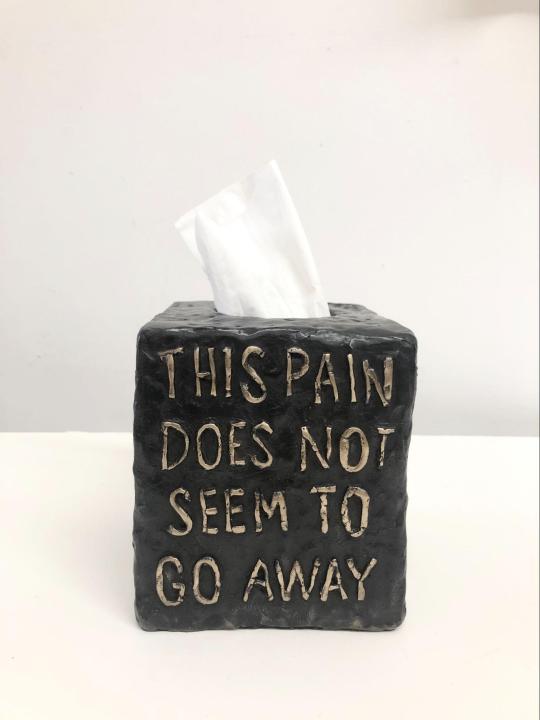
Corey Escoto, This Pain, Cast bronze and tissue paper, 2020
VJE: Having been here in New Mexico since 2016, I have felt both cut off from the rest of the country and also feel like I’m seeing a slice of America that I otherwise would not have known existed. Not in the rural sense - I grew up in a rural area, but demographically the population and culture here is very different from what I grew up around. People are generally “liberal” although that label doesn’t quite fit completely. There’s a big gun culture here, a lot of “stay out of my business and I’ll stay out of yours” mentality. It’s majority minority, with most people some shade of brown, although not many Asian or Black people. Meanwhile there’s also an unfortunate, very visible social strata here, with the very rich white retiree population gating themselves off from the rest of the working population.
I moved here to exit the rat race of New York. The constant struggle of having to work full time just to exist and not much more was wearing me down, and I knew that simply being in a place wasn’t my end goal in life. Living like that feels like a trap. But while living in New York, I would drive down to Virginia (the red part of the state) a few times a year, so was very aware of the political sentiment outside of the city. But it’s also the same political sentiment that I grew up around, so it’s not like that much had changed. I feel like issues get kicked up, and people talk or fight about them for a little bit, but eventually the dust settles and people go back to living as they did before. We’re creatures of habit, and habits don’t break without something that forces you to change (internally or externally driven). There seems to be a cyclical pattern when it comes to social progress - two steps forward, one step back. One step forward, two steps back. Ultimately I do think we are inching forward, but like ants on a branch sometimes it’s hard (impossible?) to see the big picture.
Apologies if it seems I’m jumping around a bit - you brought up a lot of things that I want to make sure I come back to. So let me jump back to your studio visit we had. Aside from three extremely small outdoor meetups, my recent trip to the East coast/New York was actually the first time in over a year that I had really socialized with people outside of work or my pod since the start of the pandemic. When I arrived I was very much in a state of blissfulness, coming off the natural highs of seeing close friends for the first time in a long time. Also a little nervous too - after not socializing for so long, seeing people in person felt awkward and strange; I wasn’t sure the rules of pandemic etiquette. Is it ok to take off our masks? Are people hanging out indoors? Do I stand 6 feet away if we're both vaccinated? So many questions. I guess I was so wrapped up in my own head that I didn’t at all perceive your nervousness or un-confidence you described!
Anyway. So I was excited to see your new bronzes in person. But the paintings ended up being the thing that’s been with me since I’ve left, and with them the conversation we had about finances and the stock market and capitalism. I think the reason why it stuck so hard is because of the feeling of deep shame I felt/feel for being one of the people you were describing who jumped on the stock market wagon. Having not talked to anyone up to that point, I didn’t realize it was a thing that people were talking about in everyday life. But that feeling of disappointment in myself that I felt that night has stuck with me, and I think that’s what makes the work so successful. I’ve found myself really digging internally about my own motivations regarding wealth and survival. It’s like when you watch a movie and you’re not sure if you “like” it because you don’t feel elated at the end of it, but you find yourself still thinking about it days or weeks later, and you realize that it’s because of the long running thoughts it gave you that you love it.
Having had a very tough battle with the virus myself, and having lost two grandparents, having rode my bike past trailers filled with bodies, and having walked beautifully empty streets, watching those with means flee the city, and having tearfully cried “say her name” until the words were only a sound, and recognizing the magnitude of these times unfolding, I suppose I wasn’t all that interested in Gamestop.
Money and death. Yes, it absolutely feels gross to think about money and stocks, to be excited about striking it rich, when there’s a virus still out there killing thousands each day, knowing that there’s death and injustice everywhere. When I let myself think about it, it’s paralyzing. I also know that when I think about it I’m not even grasping the full extent of what’s happening. So how much more suffering is out there that we can never know?
The start of the pandemic was marked by a distinct feeling of “pre-grief” (which was then replaced by actual grief). I had just returned from New York, miraculously unscathed by the virus while almost everyone I knew started to come down with covid symptoms. Two of my friends were in very bad shape, and when I stopped seeing or hearing them online I started to dread the worst. (You were one of these friends. And when you popped back online, alive albeit still recovering, I was so so so relieved and so grateful.) But death, and our proximity to death is something we don’t talk about as a society. I think it’s why people are so easy to forget that there’s still a pandemic going on. Out of sight out of mind. And perhaps that’s why people are able to talk stocks and fantasize about becoming rich. But I also think for many people, it’s a way of coping with everything that happened that hasn’t been processed yet. (For me, during the pandemic I lost all my usual modes of income, so I do truly hope for some financial relief.) Many if not all of us lost friends or family this past year, but even for those of us who lost someone, how many of us have been able to fully grasp the realities of those deaths? I lost an aunt and an uncle, and it still feels surreal to me. My family hasn’t held a funeral yet, so right now their deaths only exist as knowledge, not an absence that I’ve been able to truly feel and process. I believe at some point in the near future there will be a reckoning of each of our individual losses, which will be felt in waves and ripples for everyone.
The deaths of George Floyd, Breonna Taylor, and so many others also hit me hard (as I know it did countless others, including you). Watching or reading about anyone’s murder at the hands of police is disturbing, and should make everyone upset and angry. Then seeing videos and images of police beating protestors, it started to bring up some really horrible memories. With everything going on, there were more than a few occasions last summer where everything felt broken and hopeless. I would get in my car and find myself sobbing in a parking lot, unable to drive or do anything. I think in the face of so much death and suffering, it’s difficult to find purpose as an artist. Or at least it was for me. There would be times when I would stare at a piece of blank paper and just think, what the fuck am I doing? How is this helping?
One thing I love about your work is how well you utilize the tools of capitalism against itself. You make really fantastic satirical sales videos, branding, and seductive display. It’s simultaneously high concept and accessible at the same time. I’m curious to hear your thoughts about how you approach the accessibility of your work.
Well first off, thanks. As far as the consumerist mechanisms within my work, I think all that stems from working in the ad/tv industry for a decade and then getting fed up with it. There was one day that I was working on a video edit for a Gillette pitch, and I felt like I was going to die. I was being asked to chop people’s interviews up and have them say things they didn’t say. I was being asked to make hand drawn animations for CEO retirement parties. My soul was dying. But I learned a lot. Namely, the ways people expect to interact with video, the kinds of images and sounds they expect to see and hear. And how could I not utilize that knowledge in my work now? I don’t know if I successfully manipulate people the way ads do (that’s not my goal), but it is my goal to get and hold people’s attention for as long as they’ll let me. Although, as I get farther and farther away from my “past life” of commercial tv, I am more interested in seeing how far I can push people before they break away. How boring can I make this tv loop? How long will someone stand here and watch this, just because I’m watching them watch it? That’s my own sense of humor, which I don’t know if people get. Half the time I’m waiting for someone to give me a knowing look and share a laugh, but that so rarely happens because people take everything so seriously. And nobody wants to feel like the joke is on them. Anyway, people react to art differently when they don’t see it as art. I would much rather have a show in a space disguised as something else and have people wander in not knowing what it is they’re looking at and letting them discover it on their own terms. Retail settings are perfect for this because the relationship and rules between viewer and object are established. People are supposed to look and browse and decide if they like something, and as such the work is allowed to be touched, picked up, and eventually acquired. I certainly have had some failings though in this respect. Try as I may, the “retail settings” that I’ve created are still obviously modified gallery settings, and so I haven’t fooled anyone. I’ve had the most luck with my coin shop; I think filling the space with obvious crap helped people feel a little more comfortable engaging with me and the work.
Regarding modes of interaction, I think the form and materials often help break those barriers and help artwork be more accessible. If something is functional, or has the ability to be a stand in for something functional, then there's an immediate relationship that someone doesn’t have to learn. And of course, you can then build off that relationship into more complex or unexpected ideas. I think you do this with your kleenex box sculptures.
...while selling bronzes and drawing/paintings to rich people that you kind of hate on some level...
I can definitely relate to the contradictions you talk about. On one hand I want to make works that are conceptually accessible and [actually] affordable, but I don’t just want to make “stuff” to clutter the world. And I don’t want people to buy my stuff just to buy more stuff either. But then I also have people telling me that a higher price tag will help me as an artist and that I need to value my own time and work more. But then who gets to own my work? I’m so much more interested in conversations with people who aren’t collectors or even other artists. It feels weird to sell work to people that you’ve never spoken to while the person standing in front of you holding your work and talking for an hour has to leave it behind. The truth is we’re all trapped in this reality of value being quantified by a dollar price tag. Perhaps the best way forward to looking for ways to mitigate this contradiction, like a giant knot that needs to be untangled slowly. This past year I have been looking and thinking of ways to live a life with more integrity while also figuring out how to have a practice that isn’t so reliant on sales (because I don’t have them lol).
“Nah, I was way too poor to be a hippy.”
It’s interesting that you shared this anecdote because it reminds me of the reason why I left Taos. Taos is and remains one of the most beautiful places I’ve ever lived. But after meeting people from the area, the town started to emerge disjointed demographically. I had mentioned that this state has very visible social strata (and maybe you are aware of this from your travels here), and that divide is obvious in the more well-to-do cities: Taos, Santa Fe, Los Alamos. In these places, a lot of artists and art-adjacent people are self-proclaimed hippies: out on the mesa, drinking beer, joking about how they have no money, yet they would also talk about how they would never visit the south side of town, or how rough and scary Albuquerque was. I don’t know how less to say this but to be blunt about it: everyone who fit this description was white. And they were all afraid of visiting areas where mostly people of Mexican or Hispanic descent lived in poverty. Everyone was talking about everything except race, yet their omissions spoke louder. I couldn’t engage with that kind of community.
What do I see now? Here in Albuquerque my life remains somewhat isolated, with the occasional grocery store visit or open air dining. When I walk around I see a lot of people hurting on the street. I live near the downtown area, and there are a lot of homeless people. There’s been a visible increase in homelessness, and I also suspect a decrease in resources for that community. The modest wave of gentrification was slowed by the pandemic, with lots of businesses and restaurants closed permanently. Downtown is quiet, almost completely abandoned, but a few older establishments have survived: a two story dive bar, a pool hall and a strip club. I’ve had conversations with patients (for those who don’t know, I teach art and cooking workshops at a rehab facility) on both sides of the political spectrum, and it’s always been refreshingly respectful (luckily no Proud Boys, at least that I know of). The few coworkers I have are nurses, so they update me about the horror they see in the local hospitals. That job brings me in contact with a much more diverse group of people than my university job ever did, I think because addiction truly cuts across income levels. It also reminds me of how easy it is for a person’s life to unravel. I feel lucky to have made it this far without losing my footing too much.
This might sound like a veer in the conversation, but I’m curious where you find joy? I can easily fall into a dark hole when I think about what’s going on in the world, and as an empath that scores high as an HSP it’s really important for me to create moments of solace and specifically joy for myself. Do you feel like your sources of joy have changed since the start of the pandemic, or have you found new unexpected ones? I know that you spend a lot of time outdoors, which I imagine is a great source of calm - how much does that inform your work? I was surprised to see the swamp landscape painting, even though it seems so obvious knowing where you usually spend your downtime.
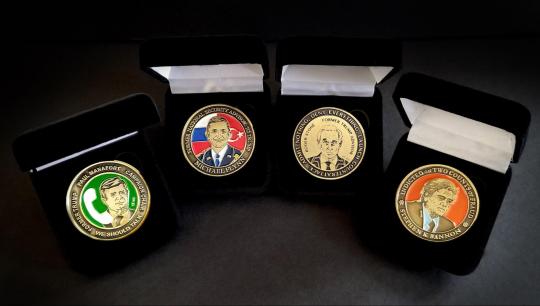
Valery Jung Estabrook, Paul Manafort, 2018; Michael Flynn, 2020; Roger Stone, 2020; Stephen K. Bannon, 2020; die-struck zinc alloy and enamel coins.
CE: I very much appreciate the opportunity to turn toward a brighter direction. I was so worried I was too focused in a negative mindset. Thanks for joining me there for a minute.
The first thing that comes to mind is of course fly fishing, fly-tying, and just being outdoors. I could speak endlessly about this but I won’t go on too long. It’s funny to me that I moved to NY and started fly fishing more than I ever had before. I find it’s all the more necessary to recharge and find myself engaging in an activity that is unburdened by any sort of professional aspirations or lofty humanistic goals. It’s difficult to set that mindset aside when you identify as an artist and see yourself as that primarily, so I fish I suppose. It’s an almost pure pleasure. I say almost because, for me it’s increasing difficult to see and experience the world in an apolitical way, but I think this is also a sort of zeitgeist. It is interesting to think about who is a flyfisherperson? Traditionally, the sport has been one comprised of a more affluent older white male demographic, but that is certainly changing. With instagram accounts such as @brownfolksfishing, or forward-looking retailers like Patagonia spotlighting indigenious peoples in video shorts, or the fact that millennial women are rapidly taking to the sport, it has been interesting to see how the community has had to make room for a wider audience. As someone who has introduced many people to the “way of the fly” as I like to call it, I have firsthand experience of the tension of standing out and defying the expectations of who a flyfisherperson is supposed to be alongside a spectrum of other first time flycasters. I think it’s interesting to think about the countless lines that might divide, urban vs rural, brown vs white, political party affiliation, education, firearms etc. and think about how flyfishing is a common thread that might bridge that divide. This thought was at the forefront of my mind early one morning, after driving deep into rural PA and seeing numerous enthusiastic Trump 2024 displays, when I encountered a fellow fly fisherman, an older scruffy outdoorsy type who was carrying a handgun outside of his waders. I engaged the man in friendly conversation, telling him it was my first time on that particular river and he was nice enough offer some suggestions. The subject of bears came up and he motioned to his holstered handgun; I showed him my dangling red can of bear spray. The man was generous and the interaction was positive. I certainly don’t think a handgun is out of place in this remote area, but the thought definitely plays a role in the overall safety calculus that one must think about when fishing alone in deeply conservative rural areas.
I think I mostly want to keep my art and my fly fishing separate although occasionally I allow for the two worlds to overlap. It’s nice to have a break. One of the big overlaps however is the fact that when I first started making art in a consciously more serious way (in high school) I was making watercolor and pastel landscapes, sometimes from photographs that I had taken while on a fishing trip in colorado, or sometimes en plein air in the nearby canyon that I explored after school and/or work.
How about you, where are your happy places? Music? Food? Antiques? I know we have so many overlapping interests, but you have always impressed me with your sneaky musical ability and kitchen know how.
VJE: Yes, food and singing. I think my love of home cooking and karaoke would also qualify as activities “unburdened by any sort of professional aspirations or lofty humanistic goals.”
Food has always been important to me. My mom held cooking classes in our house when I was really young (“Su’s Oriental Kitchen”). Growing up around that you easily develop a love of eating. And then when my parents decided to start a “Korean pear orchard”, food yet again became embedded in my identity. So of course food holds familial and cultural importance for me. But as far as my serious cooking aspirations, I have to credit two friends completely unrelated to my family background: my best friend from highschool and my roommate after college. These two people introduced to me thinking of cooking as a way to make special moments to share, food as an event in itself. And this ultimately is how I now view cooking: creating something that immediately gives sensory pleasure and also sets a stage for personal connection and shared memory.
And then there’s Karaoke. There’s the aspect of being in the same figurative place with others (that shared sensory experience thing I was mentioning before) but there’s also a dynamic of performance: giving energy to an audience, and having that energy reflected back in the form of applause. And that it isn’t just one person performing, but something that everyone does. So we all take turns being silly and loud and nervous and then being cheered and supported. It’s an amplifying feedback loop of positive energy. And just from a purely physical perspective, singing is really fun to me. Of course karaoke remains one of the most high risk activities during this pandemic, so I haven’t done that in a long time...
I think my pure joys come from 1) connecting with people and 2) discovery. And if you can combine those two, then that’s even better. I imagine each of us as tangents curving into space, separate entities yet constantly intersecting or running parallel alongside each other. When I think about the sheer number of people in the world and the countless factors that influence our moods, our thoughts, our actions, it’s astounding that we are able to share emotional experiences. And when they do happen, regardless of whether they be quiet revelations with a lifelong friend or uninhibited laughter with someone you’ve only known for a few hours, they are still a kind of mutual discovery and therefore special.
This isn’t to say that I don’t enjoy being alone. Throughout the pandemic, quiet solo activities like art making, gardening, or going for a run are when I am able to clear my mind. Lately I’ve really enjoyed ceramics, which I never seriously worked in before. And because gathering in person wasn’t possible, this past year I found myself funneling my energy into “slower” forms of connection: making gifts, testing recipes for future shared meals, writing letters and cards, that sort of thing. And it’s been especially exciting when I receive surprises from friends.
Your story about the flyfisher with the handgun reminds me of a lot of interactions I have with people when I visit my hometown. When I meet new people there I’m simultaneously “on guard” yet still seeking a small connection. And while this is related to just being a friendly person, that kind of interaction feels more like gauging whether or not that person is safe for me to talk to (both as a minority and as a woman).
How do you feel about rural/conservative areas of this country? Earlier you wondered about what you weren’t seeing after having moved to New York. Is the general conservatism of rural America something you feel you are able to/want to co-exist/engage with, or do you notice yourself bypassing contact with people in these areas and just wanting to get out into nature? You mentioned the growing diversity within the flyfishing community but also that you “have firsthand experience of the tension of standing out and defying the expectations of who a flyfisherperson is supposed to be.” I wonder if you could elaborate on that tension, and if you feel that tension shapes who you are or how you see yourself?
CE: Feeling like I standout is a fairly routine experience that has occurred in numerous instances in formative times of my life. Growing up I was never Mexican enough for many in my community (class, language, and education all being a part of this exclusion), and certainly not white where whiteness was the dominant group, so through a form of rejection I suppose I had to ask myself and define for myself an identity that was more true. Even then I could see how, for me at least, the various identity categories and national identities are so inept, especially while moving rapidly toward an age of accelerated information exchange. When I examine the interplay of art and identity now, in galleries and museums etc, it bothers me quite honestly to see such one dimensional displays of identity celebrated and held up under some banner of diversification. I feel as though the risk averse museum world is more likely to reinforce well established stereotypes while artists themselves routinely fall right into the trap of reflecting these internalized stereotypes that society at large has fed to them their whole lives. The lack of imagination and fear of standing outside of the well established identity boxes is disappointing to say the least...and this is before we even talk about the commodification of identity that we are seeing in the artworld right now. While the aforementioned tension has certainly shaped my development and the way I see myself up to a point, it’s something that I recognize and shake off pretty easily now. As a curious person I have often found myself floating between odd groups and maybe found an identity that was more interested in finding a small niche in an odd group than finding comfort among the more like-minded.
To your question of the conservative nature or rural areas, and if I care to interact with people in these areas, I very much see the common interest (nature/fishing etc) as a potential first step toward a genuine connection or some small personal public relations effort in the bringing together of this growing divide. Honestly as a Texan, I can understand, on some basic level, the conservative perspective (despite it moving toward an unprecedented level of bonkers), and can translate in a sense. I am willing to say I like monster trucks, and county fairs, and rodeos, and demolition derbies. Sure, many of these activities are not the most environmentally friendly, or PETA approved, but they are nonetheless a well-established culture. One thing I enjoy about the conservative mindset, is that it is so much more free from the all consuming political correctness judgment game. Rodeos are so fucking cool on so many levels if you allow yourself to overlook the animal cruelty part for a couple of hours. I know it’s a controversial statement for many but the world is so full of contradictions, I have a difficult time understanding where, when, and why people will publically draw and stick closely to certain political lines, other times so loosie goosey. The urban and left-leaning mindset is so internally critical and performative, better suited to utilizing private school educations to cut each other down (while feeling smart), rather than making actual change. And change comes embedded in this tension and the willingness to confront, endure, dialogue, coexist, befriend, and potentially swing a stranger’s disinformed notions. I still want to believe this country is worth saving, but you have to be willing to let your hair down a little and meet somewhere messy and real, outside of a pure ideological comfort zone.
So much of your work actively confronts and operates in this space, I’m sure you have plenty you could add, please jump right in :)
Also, I love that your pure joys are rooted in discovery and building personal connections, it’s a wide philosophy upon which you can find pure joy around any corner. It’s good to keep that at the forefront. And speaking of joy, I’m curious to hear more about the ceramics and where they are going. I have seen images of their delicate leaf-like forms. They are quite stunning and can’t wait to see how they develop. Can you speak about where these are going or where they are coming from?
VJE: Thanks! Before I talk about the leaves I’ll address the subject of rural America.
Specifically about Virginia and the county where I’m from: five years ago I would have told you, I’m never going back. There are so many shitty people there, it was simpler and easier for me to cut it out of my psyche. But after my dad died, I was thrown into a situation where I had to return. He put me in charge of the farm and asked me to look after my mom. So for the past 4 years I spent many months out of each year (alternating with my brother) going back to help out and do whatever needs to be done.
Up to that point I hadn’t lived in Virginia since my late teens, and I realize that the decision I had made to never return was one that I made as an angsty young adult. Having recently spent multiple extended trips there, there’s lots that I love: the mountains, being close to nature, having space to grow things, being away from neighbors. There are people there that obviously love my mom and help look out for her: they drop off groceries, plow the drive when it snows, hunt in the woods behind her house and give her venison. When my dad was really sick, the water heater broke and the guy who fixed it refused to let us pay him. My family was so stressed, worried about money and my dad barely able to walk; that act meant so much to me. Beyond generous, it was compassionate. I haven’t directly talked politics with any of them, although I suspect most (all?) of them voted for Trump. The “all consuming political correctness judgment game” of contemporary liberalism has created societal pressure for us to not only distill our standings on issues into definitive terms, but also to keep/cut out people in our lives. I can understand cutting some people off - toxic relatives and old acquaintances who have become too fringe to hold a conversation with - but that would be the case no matter what’s happening on the national level. Chunking out huge swaths of the country as worthless is only another form of dehumanization (and also ends the conversation before it can start). I don’t think it’s my place to interrogate someone to confirm where they stand politically, especially if they don’t play a huge role in my life. I mean, agreement doesn’t equate to kindness; a person can agree with you and still be an asshole. Maybe it’s my own idealism, but I hope that by reciprocating positive interactions, as someone who maybe they look at and assume didn’t vote for Trump, I’m opening the door for more substantive understanding -- if not with me then maybe someone like me down the road.
In middle school I hung out with slightly older kids. After school we would walk to the cemetery where they would smoke cigarettes and I would watch. Then we’d go to the one pool hall in town, before getting picked up at the library. I felt like that group of friends was very much “mountain misfits”: cool, rural freaks. These friends were very much into 90’s grunge/post-hippie culture (I was too), but also introduced me to bluegrass, which later led me to country music. Bluegrass and country songs are so sad: despair, loss, heartache, jealousy-fueled murders. I mean all the life events that really stick with a person. And I’m not one of those country snobs that say “only classic” country because I will jump at the chance to belt out some Shania Twain. I felt like such an outsider growing up that it took me a long time to recognize that I picked up gems from growing up in that area. Country music is definitely one of those gems that I happily carry today.
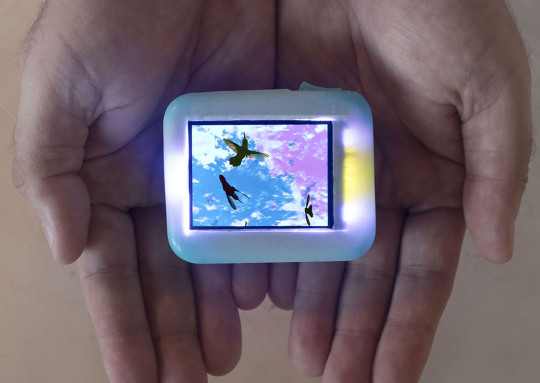
Valery Jung Estabrook, Blue Birds, Feel free to laugh and smile again, 2018; silicone, video, touch capacitive electronics, thermochromic pigment.
VJE: To be completely honest, I sometimes worry about sounding like an apologist. Not only here in this conversation, but in talking about some of the past work I’ve made. On the political scale I score extremely liberal, yet I too get frustrated with the over abundance of caution I have to put into everything so as not to be misinterpreted. Sometimes I think my attempts to be nuanced, or worse, my attempts to be funny, are misconstrued as celebrating or rationalizing something that I loathe. And I worry that my worry will cause me to fall into the trap that you described, of playing into stereotypes - in constantly reaffirming my intentions I also end up flattening the message. Leaving space for individual interpretation can be terrifying in this political climate, but I think it’s necessary, and something that I’m really trying to allow in my work. I don’t know how successful I am, but I am trying.
I think that’s one of the reasons why I’ve been enjoying working in clay so much. With all the madness in the world, it’s been really nice to create something that doesn't drain me of emotional energy. I started making the leaf forms out of my fascination with and admiration for the datura genus of plants, also known as jimsonweed. They grow wild here in New Mexico and at my home in Virginia. The plants are toxic, and have hallucinogenic effects when eaten; I remember kids in school used to eat jimsonweed to try to get high (which is incredibly stupid btw). There are stories of datura in witchcraft, and it still is used today in some Native American ceremonies. Anyway, did I mention the plants are toxic? Like, extremely poisonous. The toxin is concentrated in the seeds (something like half a teaspoon of seeds can kill a person), but is in every part of the plant and can be absorbed through the skin. The plants produce large, beautiful trumpet blooms, so they are popular among gardeners despite their toxicity. Some species are illegal to cultivate in certain states, but it’s still pretty easy to buy datura plants or even find them growing on the side of the road. I think they grow in parts of west Texas too, so maybe you’re familiar with them. Anyway, I think it’s funny that here’s a plant that obviously doesn’t want to be eaten or touched, and yet we humans keep insisting on trying to consume and/or cultivate it. We talk about American arrogance, but what about plain human arrogance? It’s so obvious that plants will be here long after we’re gone and yet we think we’re at the top of the pyramid.
Part of the exploration is material, teaching myself how to work with clay and getting back into sculpting with my hands. I also started throwing on the wheel, which is very meditative. It requires a lot of strength, stillness, and focus. Last fall I started experimenting with pit firing, and am intrigued with the process of allowing the fire create a surface treatment. I have some ideas of what things might look like when I’m done, but because I’m still learning the physical limitations of the clay I don’t want to marry myself too early to a concept for the final form. At the moment I’m experimenting with creating my own glazes, and am crossing my fingers that something exciting will come out of that. It definitely has been a joyful process, and it feels really good to be in that mode.
I’m impressed that you’re able to shake off your past experiences enough to avoid the pitfalls of identity artwork. Do you have any words of wisdom or advice for how to do that? Asking for a friend.
CE: Thanks for this last collection of clearly organized thoughts, there’s so much here that’s resonating with me.
Maybe I meant that my identity is not really an issue to me anymore like it was when I was 19 or 20. I certainly don’t want to imply that I effortlessly transcend internal and external identity-based conflict, but I think early on I began to create and attempt to communicate an identity understanding that was rooted in specific experiences that were true of my lived life. For example, in response to the infamous “where are you from, no, I mean WHERE are you from ?” or “what are you?” questions, I’d normally offer an abundance of information, sort of a short creation story that included the biographical information that the questioner was searching for but was also more granularly accurate of who I was and how I got to this point. It was an approach that was reserved for those questioners who were trying to box me into a single word or concept or nationality. Side note, in St. Louis where I lived for 5 years people would ask what school you went to (and they meant high school) as a way to sort of gauge your class and upbringing. So weird.
In terms of how a person’s identity gets translated into art, I feel like art students (and artists generally) are pressured or expected to make work about identity, as if identity pain is the only source of creativity. I definitely felt that pressure as a student and again more recently in one way or another. On one hand it feels like a special club of the oppressed that one could belong to, but it also feels like a trap that really limits your work in a number of ways. When I occasionally think about making work that directly references identity I find most interesting the blending and overlap of cultures, and it’s very odd to me how we, as a supposed melting pot, have such trouble recognizing and holding up that blur as remarkable. I recently met a 1st generation Korean-American woman, born of Korean parents, who grew up in NJ, and I could hear hints of a familiar Spanish accent that she picked up from her neighbors in her spoken english. That is one thing I do love about our country and about NY and perhaps more and more the norm as we approach the anxiously anticipated demographical tipping point year of 2045. It seems on one hand like such a distant science fictional date, and on the other hand right around the corner, only 25 short years from now. I feel like the media will continue to hype this milestone year and as it approaches I wonder how Americans will process that? Will we be any closer to confronting wealth, class, and social mobility issues that underly racial tension. Maybe racism will melt away with the icebergs.

Valery Jung Estabrook was born in Florida and grew up on an organic Asian pear farm in rural southwestern Virginia. She holds an MFA in Painting and Drawing from Brooklyn College and a BA in Visual Art from Brown University. Her video and installation work has been exhibited at a number of venues, including EFA Project Space, Auxiliary Projects, SPRING/BREAK Art Show, Field Projects Gallery, Shenandoah Valley Art Center, Knockdown Center, NY Korean Cultural Center, Aggregate Space Gallery, Columbia Art Center, Collar Works Gallery, Currents New Media Festival, and CHANNELS Biennial Video Art Festival. In 2018 she received the Gold AHL-T&W Foundation Contemporary Visual Art Award, an annual award recognizing artists of Korean heritage in the United States. In 2020 she was a Vermont Studio Center Fellow and the Paula and Edwin Sidman Fellow at University of Michigan's Institute for the Humanities. She currently resides in Albuquerque, New Mexico.
www.valeryestabrook.com @valeryestabrook Corey Escoto (1983 Amarillo,Texas) is an interdisciplinary artist whose most recent works span mediums of Polaroid photography, bronze sculpture, cast resin light sculpture, and more recently oil stick drawings. He is a resident of Ridgewood Queens and has a studio in Bushwick. Corey has had numerous solo exhibitions in galleries and museums including venues such as Regina Rex, Corbett Vs Dempsey, Halsey McKay, the Contemporary Art Museum St. Louis, and the Carnegie Museum of Art in Pitttsburgh, PA. He is a recipient of the gateway foundation grant, a Kala fellowship award winner, a Skowhegan alum and fly-fishing enthusiast.
www.coreyescoto.com @coreyescoto
0 notes
Text
6. TJ Shin & Jia Sung
TJ Shin and Jia Sung talk about their recent work, folk tales, female rage, and the reframing of power.

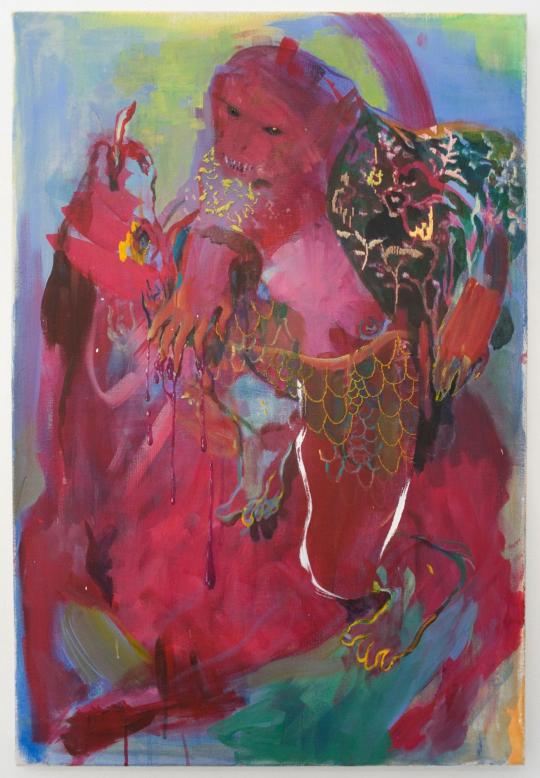
Jia Sung, 牛魔王(bull demon king), 2019, acrylic, embroidery thread, and glass beads on stretched canvas.
Jia Sung (JS): This piece that we were talking about when you came in, I feel like I've been working on it, not continuously, but for three to four months. I started it in the winter when I was really struggling with making work. so a lot of things like the embroidery of the Chinese characters and the blood drops were like busy work, in some ways. My vision for this piece was based off the Chinese folktale 竇娥冤, The Injustice of Dou’e. It’s quite moralistic in its original form, unsurprisingly very Confucian — a virtuous daughter sold off as a child bride is wrongfully framed for murder, and so she’s executed. And at her execution she swears up and down to her innocence, and that heaven will send proof in the form of a rain of blood, snow in June… that the blood would fly up as she was beheaded, without touching her clothes. And that there would be a three year drought. Prophecies, heavenly punishment and all that stuff. I was really drawn to the theme of apocalypse, but also this idea of a woman, a gendered body, a marginalized body experiencing — the violence inflicted on that body, but also this vengeance that is backed by heaven itself.
TJ Shin (TS): In folklore, the body is the origin of everything we know, like in John’s passage in the Bible, “The Word became flesh.” The woman represents purity, virginity, nature, motherhood, birth, reproduction.
JS: It’s a sad moral tale. I was drawn to its obscene levels of vengeance and lashing out.
TS: How are you able to redress or subvert these folk stories?
JS: Who gets to be the protagonist and who speaks?
TS: It reminds me of the anthropologist Trinh T. Min-Ha. She explains she wants to “speak nearby” the Other, rather than “speak about” the Other.

Jia Sung, apocalypse hymn, 2021, acrylic, gouache, glass beads, embroidery thread, and grommets on unstretched linen.
JS: I’m also super interested in the work you were sharing during our walk, the idea of the human nervous system. Would you talk more about that? You mentioned the idea of scent. The trajectory of your work up to now has been about metabolizing the politics and histories literally through digestive mechanism of our bodies. Bringing this down to the nervous system and tracing legacy through those pathways is really interesting to me; it feels quite different from your previous work on fermentation and digestion.
TS: My project is inspired by the novel The Vegetarian by Han Kang. The female protagonist, Yeong-Hye, is a victim of domestic abuse. She is sexualized by various patriarchs, her husband and father. One day she has a nightmare and becomes a vegetarian. After that, she slowly becomes a vegetable. It was profound to me because in comparison to Western ways of thinking about power, the protagonist intentionally gives away power. Eunjung Kim explains objecthood is a way to radically empathize with the Other. Critical disability scholars talk about objecthood as a generative framework without reclaiming liberal humanity or able-bodiedness. In becoming an object or a vegetable, I think Yeong-Hye is trying to be genderless, without becoming a he or a she. I like to think she is subverting how we understand animacies or bodily hierarchies. Later, I was thinking about the human nervous system and its likeness to mugwort, roots, and mycelium networks. Mugwort is considered an invasive weed in the U.S. because of its tentacular root structure. In my new body of work, I am creating a custom mugwort scent that is infused with my DNA. How do I exist as the Other and become the Other? How do I continue to exist in my deformation or desubjectivization? I am interested in the smell of the body. I want to resist the liberalization of our bodies and instead consider how our injuries can be fragmented or located in our collectivized bodies. You were talking about the female form, not as a specific figure but as a collectivized body.
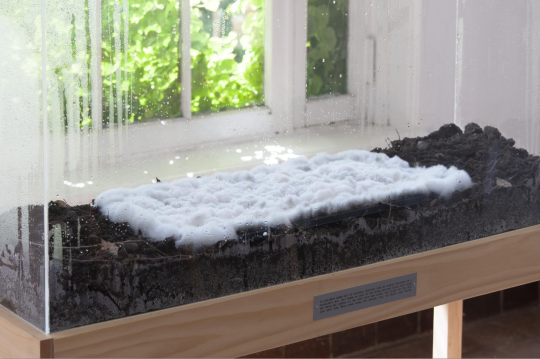
TJ Shin, Untitled (Incubator #2), 2020, soil from Wave Hill woodland forest, rice, plexiglass, wood, stainless steel plaque. 44 x 16 x 49 inches.
JS: Absolutely, and the symbol of violence but also rage against violence. When I look past the trappings of Confucian morality, the kind of signifying language of virtue, what I see is rage and desire for justice. What does that look like? Violence and retribution, punishment-based justice; it’s not necessarily the future I want to envision, but making space to understand where those desires come from. I’m interested in reading this project against The Vegetarian. You were considering the book through the lens of power, giving away power and accruing power. That’s interesting because when I think about that book, I think about the relationship between eating disorders and trauma. It’s very common in the wake of trauma, specifically sexual assault, to develop an eating disorder. It’s a form of control, a manifestation of desire, an attempt to regain control of your body, since it’s the one thing you might have a say over.
TS: What is very interesting is the first two chapters are told from the perspective of the protagonist. But the third chapter is told from the perspective of her sister. I'm struck by this impossibility of understanding her narrative. She’s hospitalized...
JS: ...right! Because the sister visits her in the asylum.
TS: Exactly. The protagonist is refusing to eat because she wants to be a tree and she feels very akin to the tree that’s outside of her asylum window. In order to become the Other, Yeong-Hye practices asceticism, a severe form of discipline to get rid of desire, human and carnal desire.
JS: Right, that’s such a tradition across all religions. This sort of self-castigation and self-denial echoes religiosity.
TS: And again this idea of why would anyone want to intentionally relinquish power.
JS: Yes, and in what framework of power.
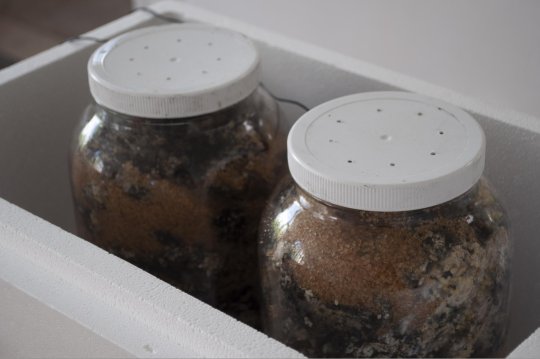
TJ Shin, Untitled (Incubator #1), 2020. Indigenous microorganism, sugar, glass jars, foam cooler, digital thermometer, stainless steel plaque. 26 x 19 x 39 inches.

TJ’s assignment to Jia:
Mugwort is a psychosomatic herb that helps you lucid dream. Forge fresh mugwort leaves. They are dark green and have hairy stems. The underside is silver white. Gather a handful and fold it in breathable cloth. Tuck it under your pillow. Write down your dream.
Reference photo from TJ Shin
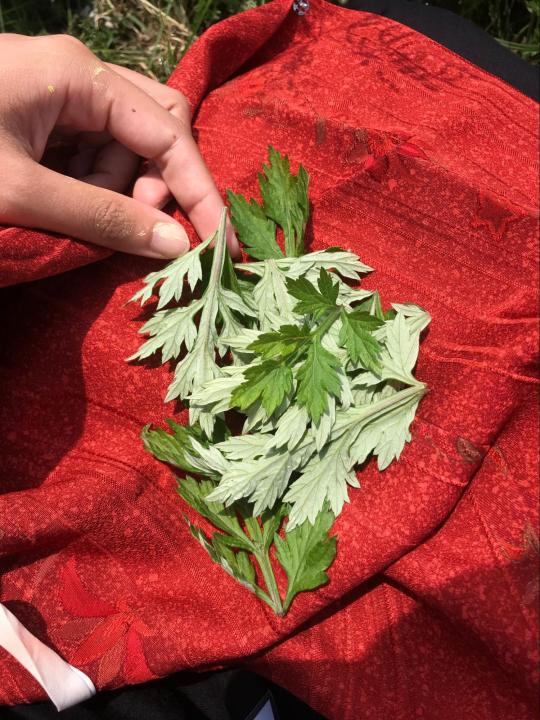
JS: I gather by invented rules: any leaf that falls and touches the ground is forfeit. I wonder how much mugwort is needed to dream a prophecy. I keep plucking. When I am tired I wade back through unnameable unmown grasses, trampling upturned faces of buttercups, flushing grey birds from underfoot. The flat package of linen-swaddled leaves travels home in my tote. It smells spicy, like rosemary or lavender. I wonder if being pressed up to my wallet will influence the dream. If the book of comparative journeys will send my spirit questing, or if the empty m&m wrapper will tie me to secular visions.
Between harvest and sleep, my grandmother dies.
I clean my face and hands, take nyquil, strip down. In my dream, I am held until I struggle, and then held until I give up, my ribcage pushing back against the rhythm of embrace.
Jia’s assignment to TJ:
Brew yourself a pot of your favorite tea. When it is steeped, pour a cup. With each sip, begin a breath meditation, breathing in for a slow count of 4, holding for 4, and exhaling for 4. Take 16 sips in this way. Tell me what you experienced.
TJ: A running body of water to the edge of fingertips.
A loose esophagus.
Intoxication of dirt.
Memories of mom during monsoon season.
Isn’t it wild how your insides can tolerate such high temperatures? Where does this temperature go?

TJ Shin is a Canadian-Korean artist living and working in Brooklyn, NY. Shin explores the porousness of bodily boundaries and the ceaseless movement of living processes, like fermentation, echoing the history of colonialism. They are interested in the history of conquest and the literal digestion of materials – smells, microbes, and food – as a system of relations that emerges from a complicated history of entanglement.
jaeyeonshin.com @fff00slut
Jia Sung is a Singaporean Chinese artist currently based in Brooklyn. She uses the familiar visual language of folklore to examine and subvert parameters set around the humanity of women, queer people, and those considered ‘other.’Drawing on motifs from Chinese mythology and Buddhist iconography, she decenters the cisheteronormative values embedded within these archives by reinterpreting them through a queer feminist lens.
jia-sung.com @jiazilla
0 notes